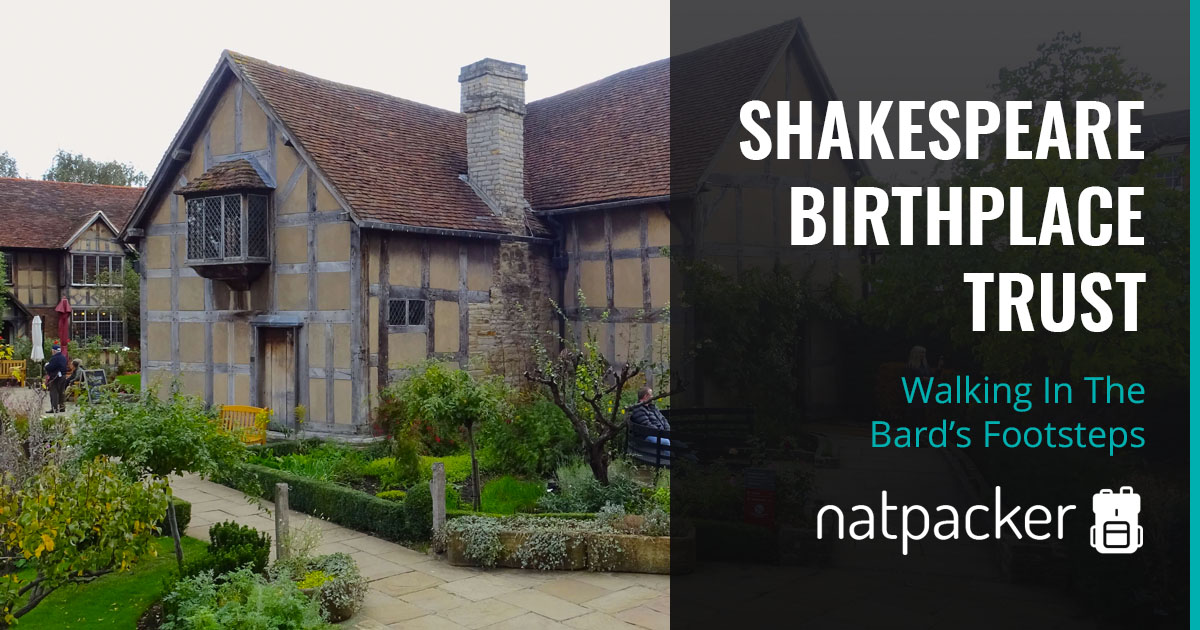If you don’t know, I got a little obsessed with Shakespeare a few years back, and so Stratford has been on my list for a while. I went to Stratford-Upon-Avon when I was younger, but don’t remember much. Finally, I managed to take some time to visit the birthplace of the bard. My plan was to see as much of Shakespeare as I can, the Shakespeare Birthplace Trust Houses and anything else Shakespearian I could find. We literally squeezed this trip in between a Christening in the Lake District and a Wedding in Shropshire, so we decided that it was kind of on the way for a road trip.
Disclaimer: I was gifted Shakespeare Birthplace Trust Passes for the Shakespeare Houses, in exchange for unbiased coverage. Therefore all opinions are my own
The Journey
Leaving Dave’s family in the Lake District didn’t go quite to plan. After a bit of car trouble, we finally managed to get going though. It was a long journey to Stratford from the Lakes.
We broke the journey up with a small detour to Pontefract. We’d wanted to find out what Pontefract Cakes were and thought the town would be the best bet to find out. And it’s not what you think, Pontefract cakes are not cakes, but liquorice sweets. We tried everywhere for them and in the end found them in a newsagent shop. Not as exciting as I’d hoped.
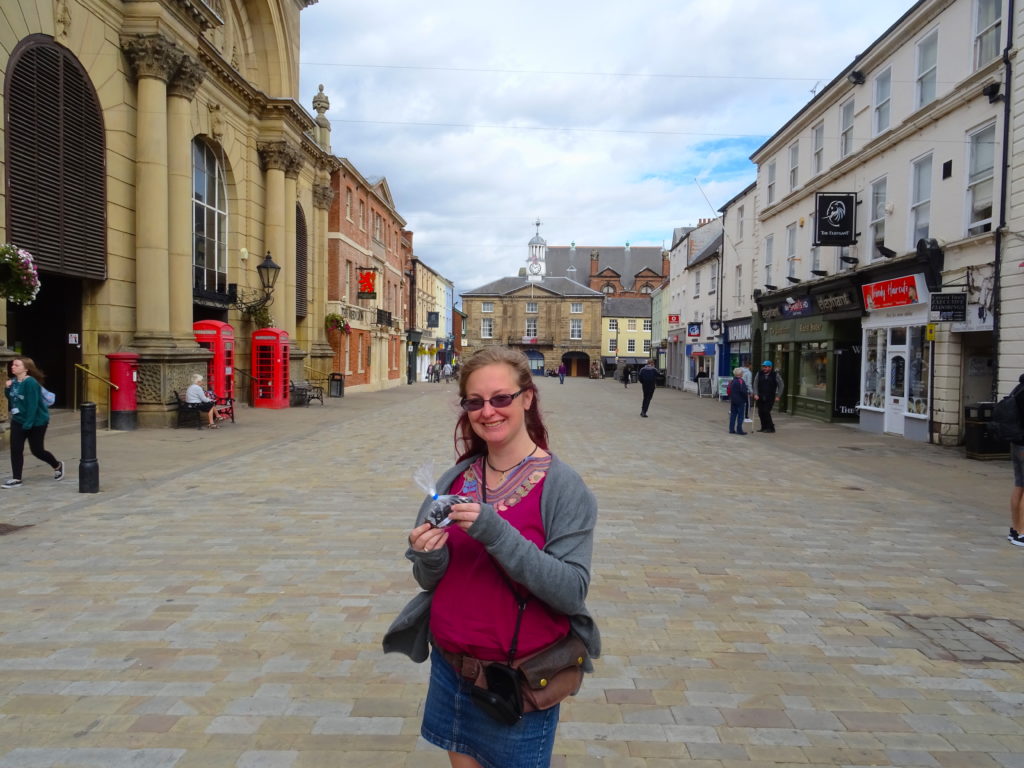
In Pontefract With Pontefract Cakes
Though it does look like the town is trying to encourage more tourism. There’s a pretty church and a few informative signs. It may be a place to go soon (check out what there is to do in Pontefract by clicking here).
Then after more driving, we finally arrived in Stratford-Upon-Avon. Our Airbnb was easy to find, just a little out of town, but it had parking. Our host was lovely and let us into our room (which was nice and big) and we got introduced to the cat, Alfie, who always tries to get into the guest room, but isn’t allowed.
A Night On The Town In Stratford
After we had had our introductions, we decided to walk into the town. It was an easy walk and took just a little over ten minutes. So not a bad location really!
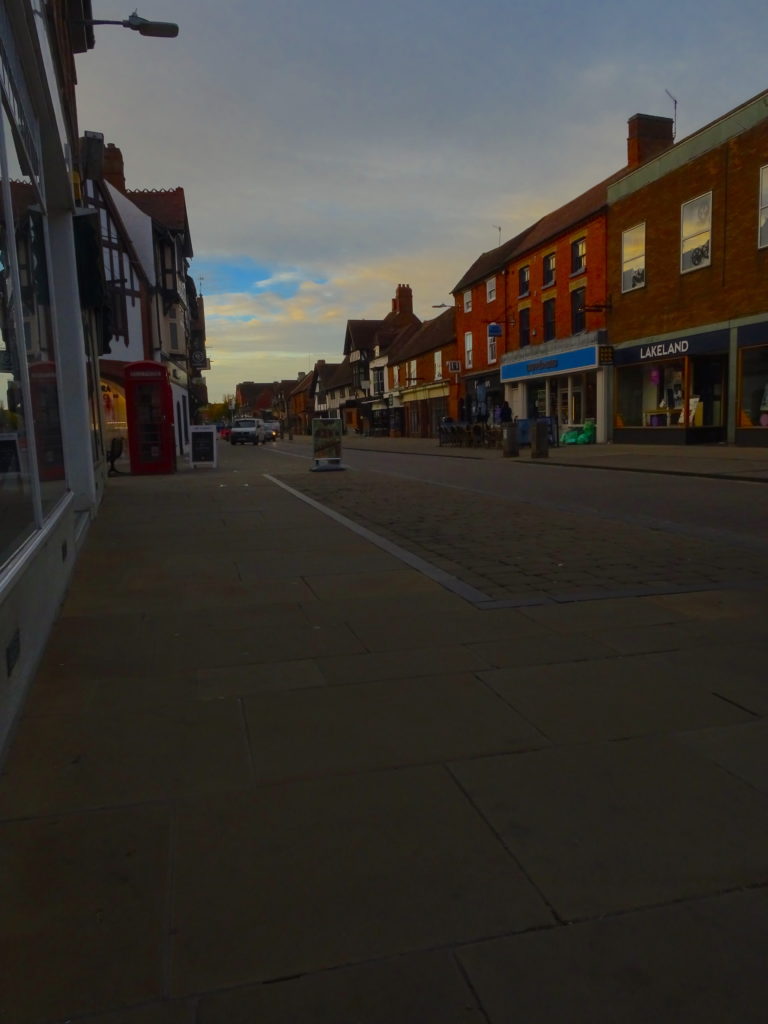
Stratford Is A Easily Walkable Town
Walking through the town I was in love with the old Tudor buildings. Everything was shut at this time, but Stratford is such a pretty little town, so it didn’t matter. We found a little microbrewery, the Stratford Ale House (see some reviews here). It was small and cosy, but with lots of choice of beer and cider.
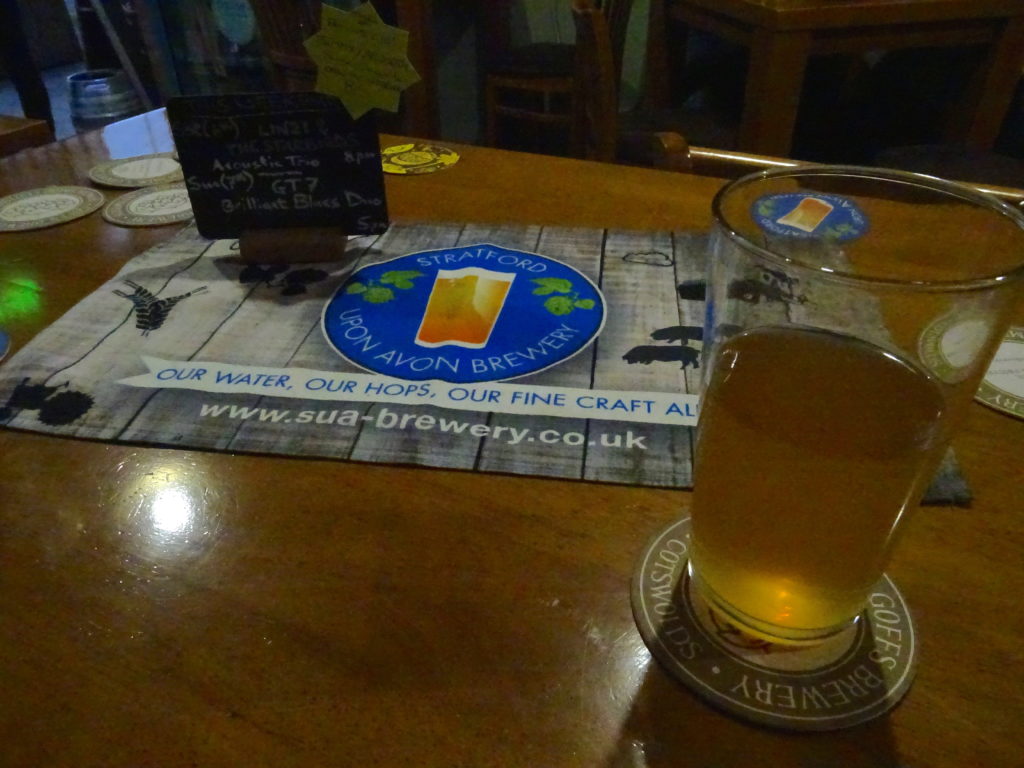
Enjoying A Pint
After one drink we realised how tired we were. So we ended up getting some chips, walking around a bit more and then heading home to bed. Because we are that cool.
Taking The Tour
The next morning we were pleasantly surprised that our AirBnB actually supplied breakfast! Always confuses me when AirBnB’s don’t, I mean, it’s in the name, right? Anyway, it was just your basic toast, cereal and caffeine, but it was definitely appreciated.
The night before we had decided to join the Town Walk tour. We don’t normally go for prepaid tours, but as it was the only one, had great reviews and was only £6 each (at the time I joined), we decided to risk it. So we headed to the swan fountain by the RSC Swan Theatre to meet the tour that started at 11 am.
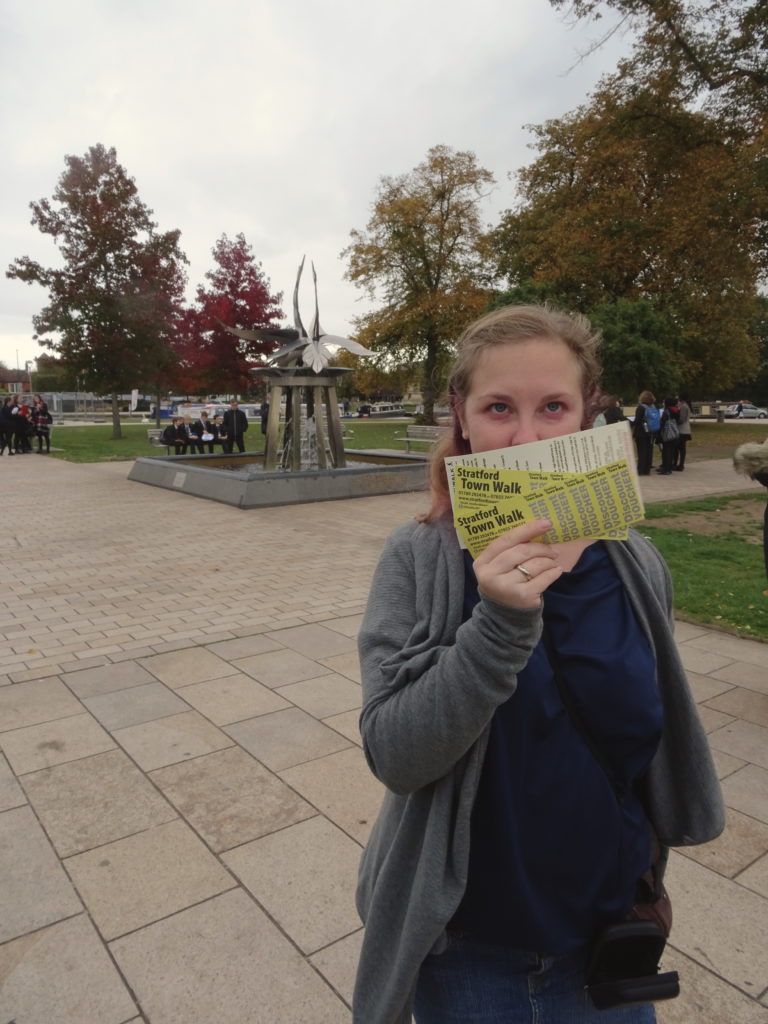
Tickets At The Ready For The Stratford Town Walk
And we had no need to fear. The tour was great, the only disappointment I had was that we didn’t have time to join the evening tour that they do.
A Bit About Stratford
The tour started with some basic information, such as Mary Arden’s Farm is twenty minutes away by bus, but four hours on the canal, due to all the locks. There was also some information about the town of Stratford itself, such as Stratford means “Street to the Ford”, as this used to be the old river crossing. There was a stone bridge to cross the river in the 1400s.
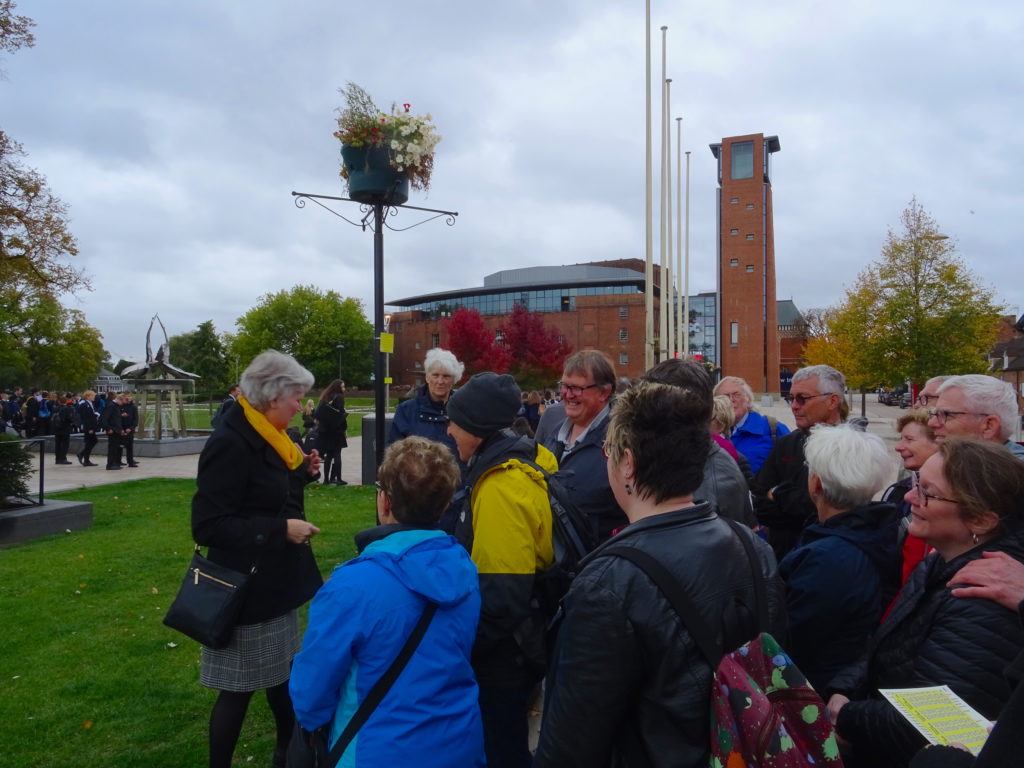
The Tour Started With A Brief Intro At The Meeting Point
Stratford has also been a market town for 800 years, despite the fact that it is on a flood plain. On one of the buildings, they show how high the river has flooded in the past, and it’s quite impressive!
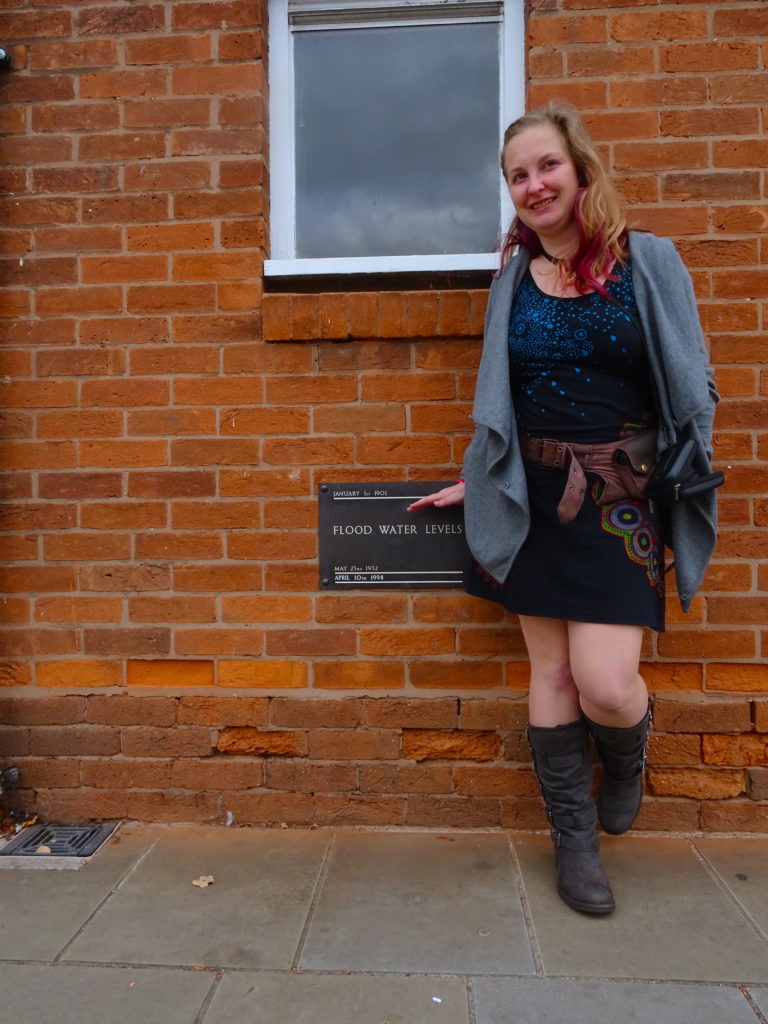
The Height Of The Floods
The town is obsessed with swans and there are plenty of swan images and references throughout the town, from the swan fountain to the RSC Swan theatre. This theatre was first built in 1936 but underwent renovations in 2010. The architect on the renovation project was Elizabeth Scott, making the theatre the first major work in Britain from the designs of a female architect.
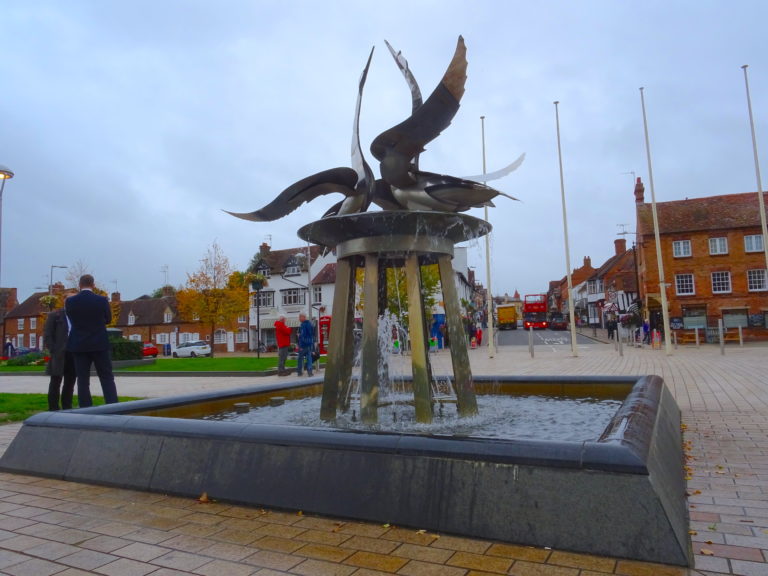
Stratford-Upon-Avon Is Obsessed With Swans
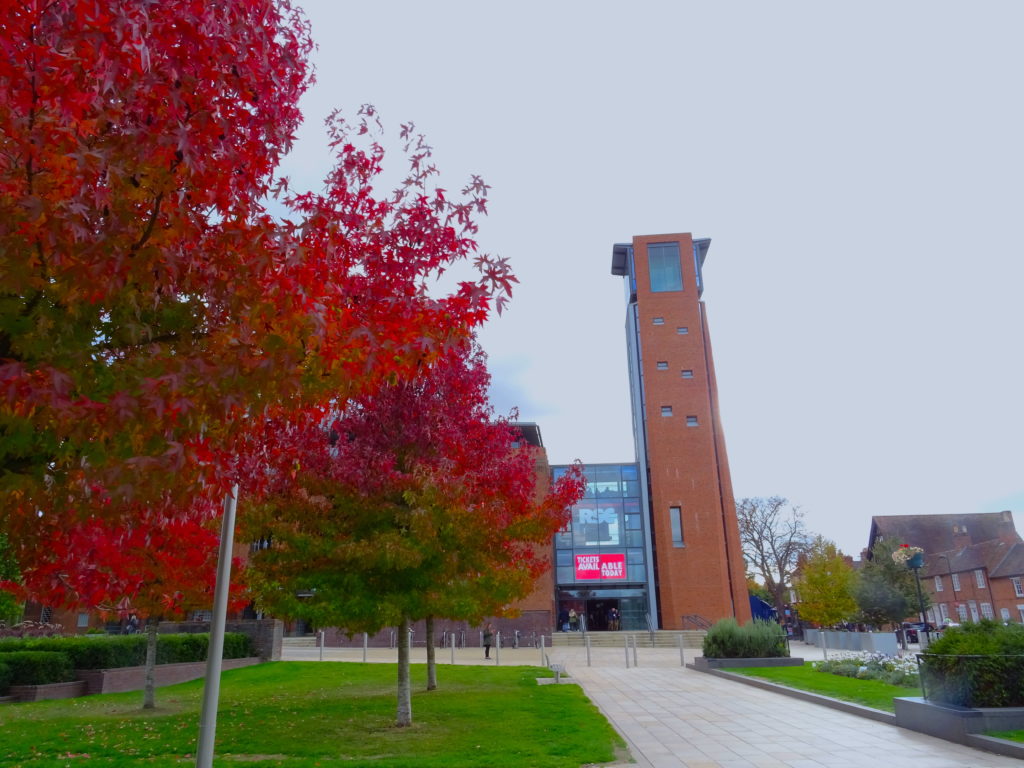
The RSC Swan Theatre
Quirks In Stratford
In Stratford town, there are an abundance of Tudor buildings, and fakes. Our tour took us to a Costa and White Stuff that are next to each other and told us to figure out which is actually a Tudor building. It turns out the “White Stuff is the right stuff”, as the Costa building was built in 1924. Despite this, it is apparently one of the most photographed Costas as people think it is Tudor.
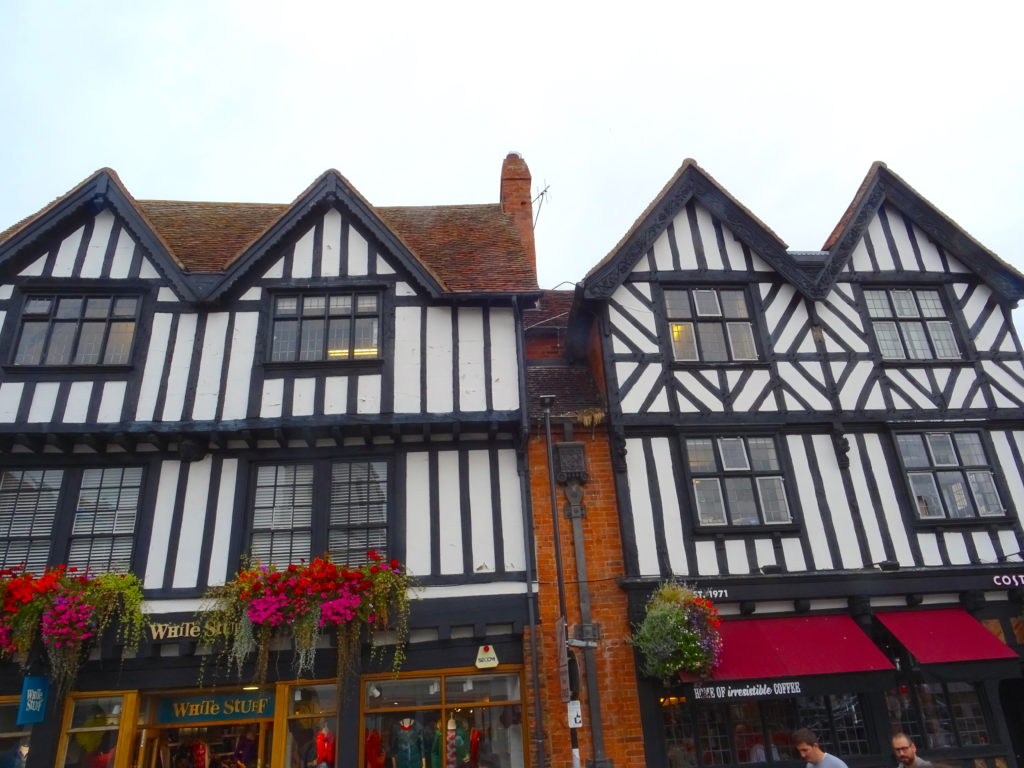
The White Stuff Is The White Stuff – Costa Is The Fake, Can You Tell Them Apart?
In Stratford-Upon-Avon you will also notice golden post boxes, there are two of them. These are to commemorate James Roe who won an Olympic gold medal in Rowing. Only one was actually meant to be painted, but as there are two on the same street the painters decided to play it safe and paint both!
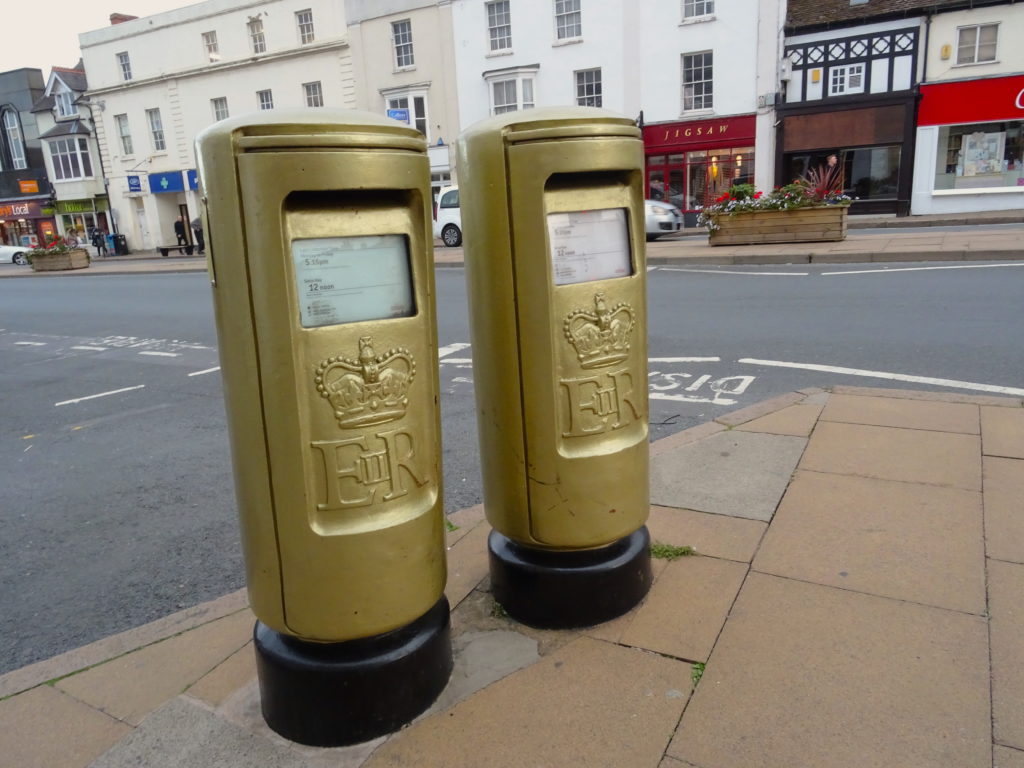
Two Post Boxes Were Painted By Mistake, Instead Of One
I had noticed the night before that there were parts of the pavement with writing on them. The seemed completely random and no sense could be made, there were things like “right we’re on our last lap now” and “watch that pigeon”. Completely random. Luckily, the tour guide told us all about them. These were part of a Millennial project. The words are actually overheard conversations.
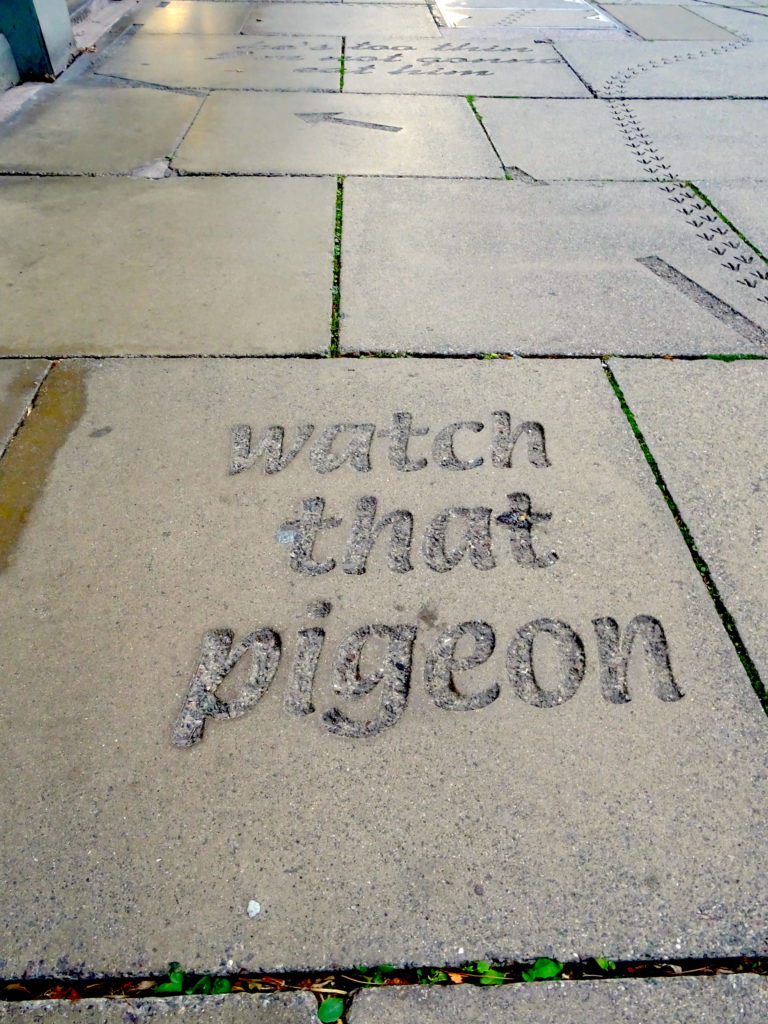
The Quotes On The Floor Had Got Me Wondering The Night Before
The Famous Stratford Writer
Obviously, it didn’t take long for the tour to turn to the most famous character from Stratford, William Shakespeare. As we came to Shakespeare’s birthplace, our guide told us a few bits about the house (annoyingly works were in the way, so we couldn’t get a good view of the whole house).
Firstly, we don’t actually know if Shakespeare was born here, as only baptisms are recorded, not births in Tudor England. It seems the likely place, but it’s not definite. The house is not actually just one house either, but three knocked into one. The right side is where John (Shakespeare’s father) had his glover business, the middle section is the family area and the left side was a separate cottage. Above the middle door, you will find the Shakespeare Coat of Arms, the Latin translates as “Not Without Right”.
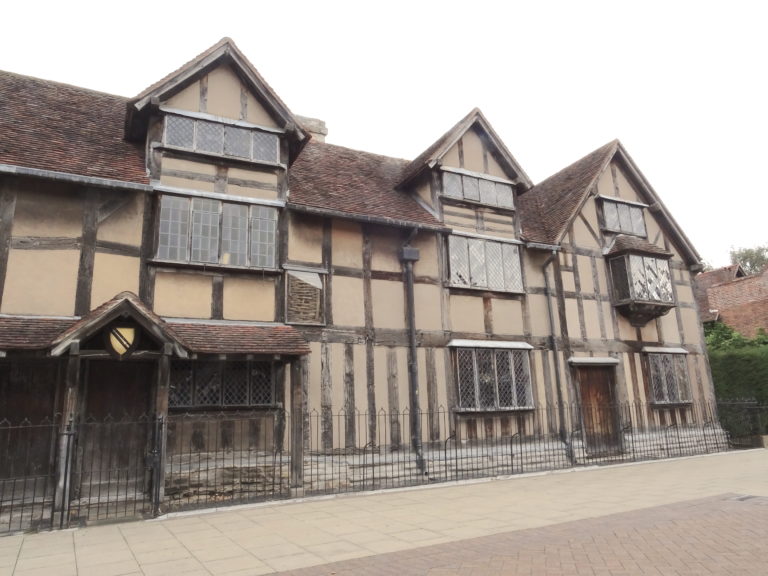
Shakespeares Birthplace, Though We Dont Truly Know If He Was Born here
Tudor Life
Tudor houses tend to have a lot of wood, in fact, it could take between 60 and 80 trees to build a house. That’s quite a few trees! The more wood your house had, the richer you were, as wood wasn’t cheap in Tudor times. Also, you know how we always see Tudor houses as black and white in style? This is actually Victorian; in Tudor times they would’ve been colourful. Is it just me, or does it seem like Victorians ruined a lot (don’t get me started on them moving invasive species around the world).
Our guide told us a bit about Tudor life, such as where the term Chairman comes from and why Tudors slept sitting up.
Stratford actually nearly lost this historic house in the 1800s. It was going to be shipped out to the USA, as it went on sale by auction. Luckily the London and Stratford Committees won the auction, buying the famous house for £3000 and so Shakespeare’s Birthplace was saved.
Stratford Town
Did you know, the pattern for the town centre of Stratford was planned in 1196? And it is made in the same pattern as Salisbury?
As we walked about our tour guide pointed out the American Monument, with its fairies and eagles, that was a gift from an American publisher. The memorial is a fountain and a clock, as well as a focal point in the marketplace.
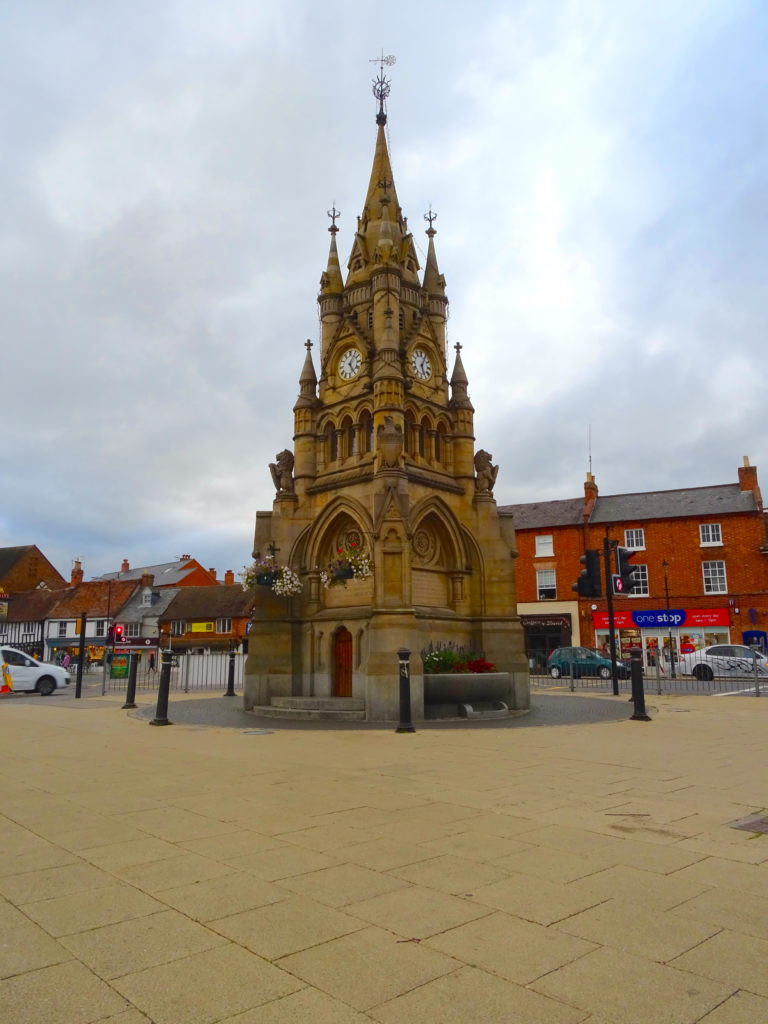
The American Monument – A Gift From An American Publisher
The statue of Puck was also pointed out. Found in Bell Place, this is one of my favourite characters, so naturally, I loved it. Behind this faerie is a green wall with little owl sculptures, which are actually quite hard to see.
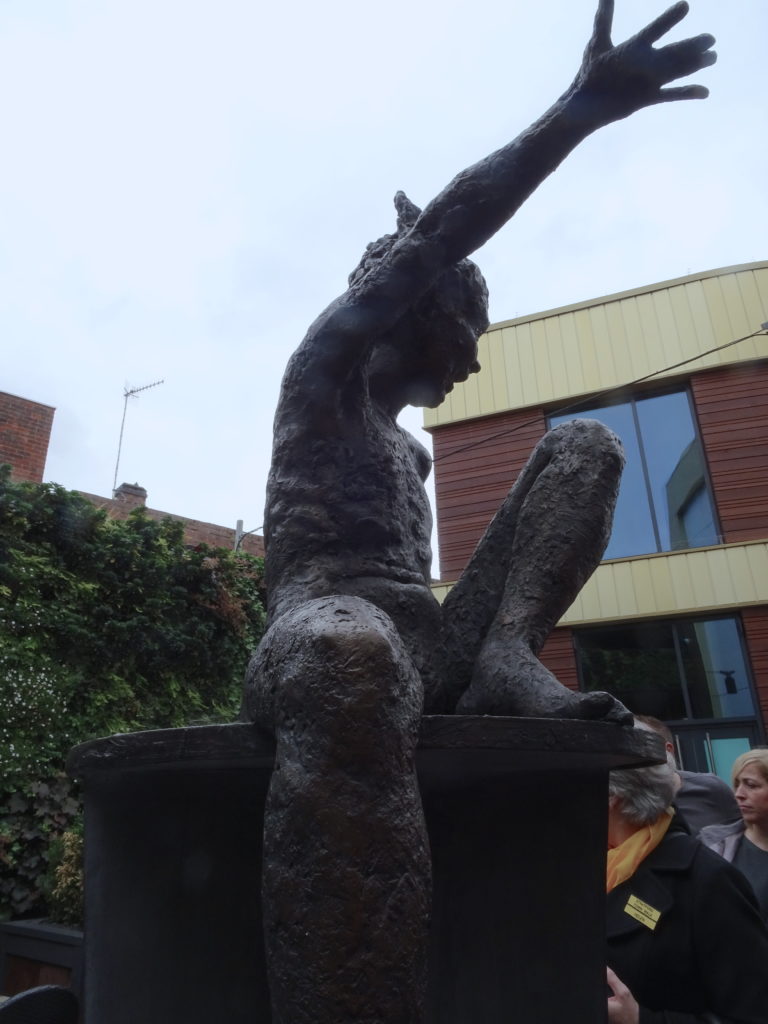
Puck Is One Of My Favourite Characters, So I Naturally Loved The Statue

The Little Owl Sculptures In The Green Wall Aren’t Easy To Spot
Also worth noting is the Old Thatched Tavern, which is the only thatched building. Although the building is now in the town, it used to be on the boundary, and so not technically in the town. Thatched was banned in the town, due to it being dangerous (flammable), but as this building was on the boundary, it got away with being thatched.
Time Travel On A Crossroad
We came to a crossroad, where the town hall is, and this is a very interesting crossroad. Here you can essentially time travel, well, kind of. Every building on each corner of the crossroad is from a different era. Don’t ask me what era, I can’t remember! You’ll have to do the tour to find out.

You Can Time Travel At These Crossroads
This crossroad also has Shakespeare links (like just about everything in the town). The HSBC, for one, has images of Shakespeare’s plays. This includes a carving of The Merchant Of Venice above the door, quite fitting for a bank!
Near this crossroad, you can also find the Harvard House. This is another building that is owned by the Shakespeare Birthplace Trust, but at the time of my visit, this was shut. The house was built by a wealthy merchant in 1596 and is al original. Hopefully, they will be able to open it up again soon.
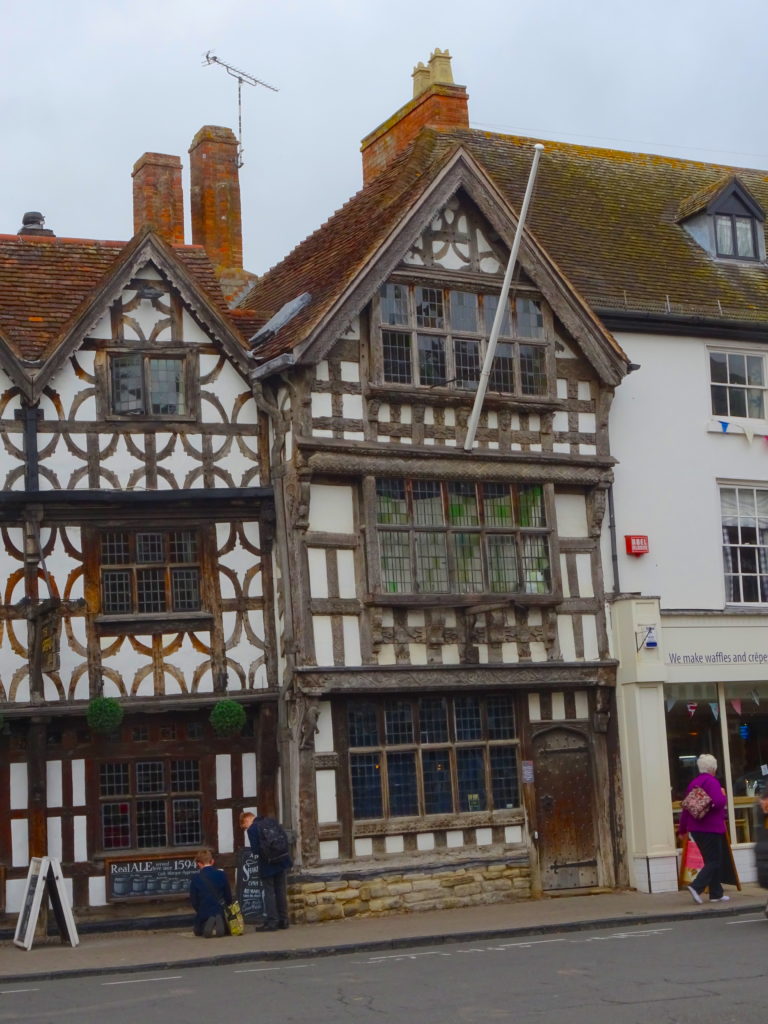
I Hope Shakespeare Birthplace Trust Manage To Open Harvard House One Day
Religion And School
Carrying on the tour, we passed New Place, which was Shakespeare’s second home in Stratford. I’ll tell you more about this place a little later on. One thing we were told on the tour though was that New Place would’ve had lots of beds, and as a bed cost at least half a year’s wages, this is quite an achievement. The house also had lots of fireplaces, which were taxed in Shakespeare’s time, further proof of how well he did.
Across the road from New Place, you can find the Guild Chapel, which is linked to the guild school. Here people prayed for member’s souls and the sons of the members went to the school, this is where Shakespeare was educated.
In the chapel, there are some hidden paintings. They are behind doors on the walls, and you can only see them at certain times, due to trying to keep them in good condition. Luckily, the tour got us here during the time that the paintings can be viewed (coincidence? I doubt it).
It is a beautiful chapel. When you visit, be sure to look above the Nave where you will find “The Doom”, this is considered one of the finest portrayals of the doom in Europe. It was actually whitewashed during the reformation, but this has started to come off, so some of the colour can be seen.
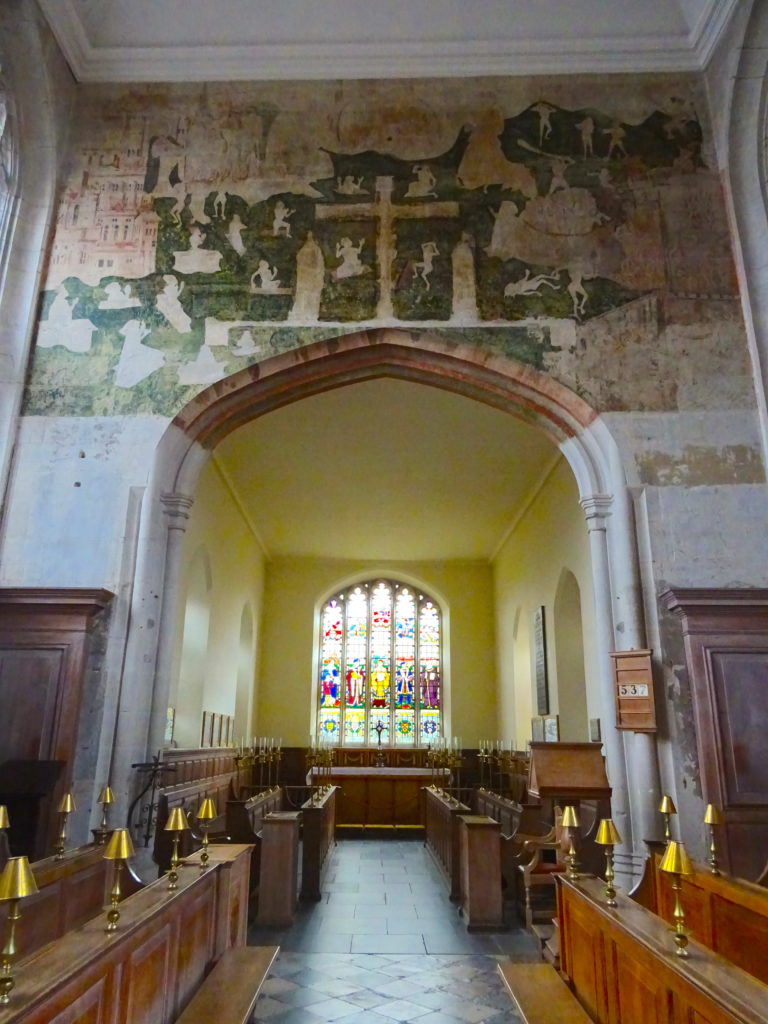
The Doom Is A Massive Painting
The Doctors House
A little further on and around a corner, the tour took us to Halls Croft, this is another Shakespeare house. This is where his daughter, Susanna, lived after marrying a physician. Hall became her married name.
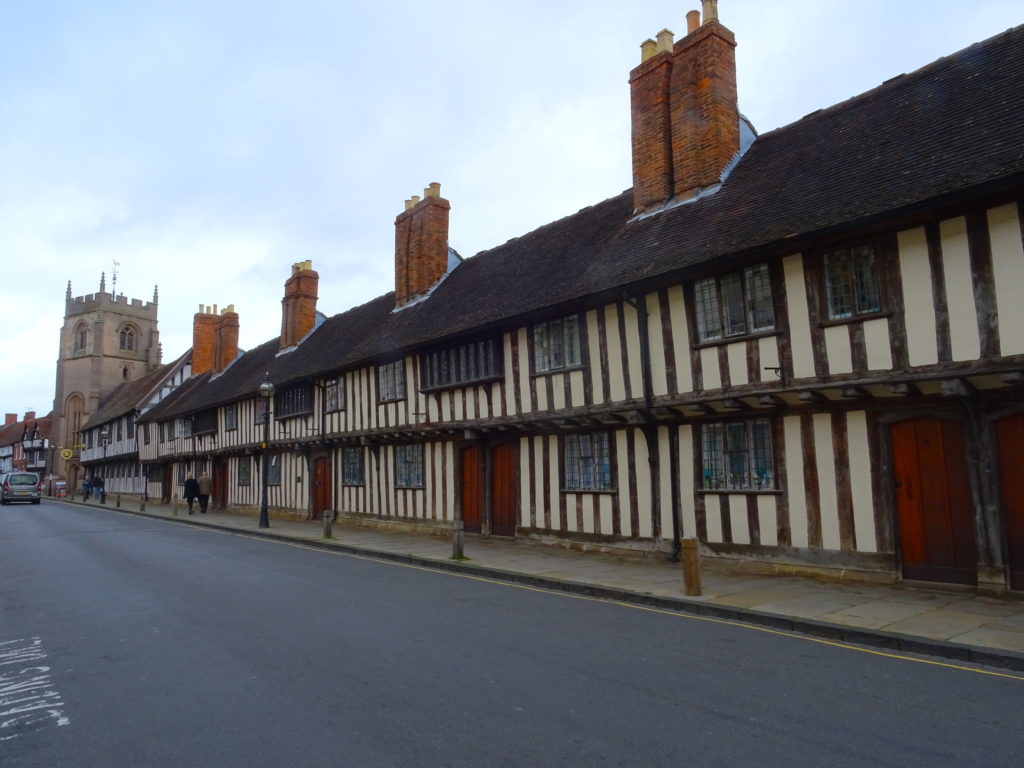
A Little Past these Buildings You Can Find Hall’s Croft
The house is big with big glass windows, this is another way of showing wealth, as glass was expensive. The poor used cowhide to cover their windows.
Our guide told us some rather interesting bits here. For instance, you know how traditional barbers have blue and red on their barber’s pole? That’s because barbers used to do surgery, physicians would not get their hands dirty. So the red shows that they can perform bloodletting and blue shows that they can bandage.
We also learnt about some random sayings that we have in the English language. You know the phrase, of having “a frog in your throat”? (For those that don’t know, this means having a cold/cough). Anyway, this comes from a Tudor cure for colds, which was to hold a frog over your mouth until it spits and that would cure a cold. There is a sliver of truth to this madness though, as certain frog’s saliva has antibacterial properties. But don’t try this cure, please get actual medicine for your cold!
All About The Lamp Posts
If you visit Stratford-Upon-Avon, you will notice some really cool ornate lamp posts. I had and luckily the tour explained these to me. Yay!
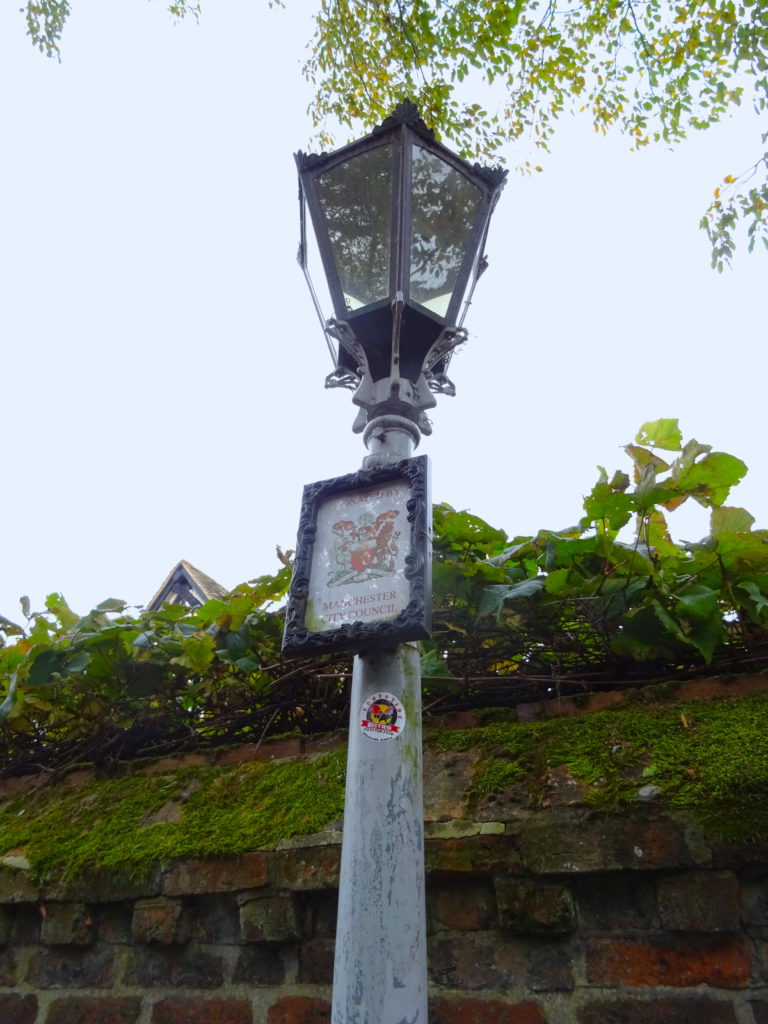
In The Lamp Post Collection, The Closest To My Home Is Manchester
The lamp posts are an “International Lamp Post Collection”, and are intended to represent all the visitors of Stratford. They put out adverts asking for adverts from all over the world (including in Lamp Post Monthly – I can’t believe this actually exists). At the time of my tour, there were almost 50 of these lamp posts in Stratford. They came from all over the world and I hope that they manage to get more.
Holy Trinity Church
We started making our way to a church next, Holy Trinity Church (for reviews follow the link). As we walked into the grounds of the church, our guide pointed out the tower, which is the oldest part of the church. There are 24 lime trees in the churchyard, 12 on each side of the pavement. One set is for the Israelis, the other twelve are for the Apostles – Judas is left out here.
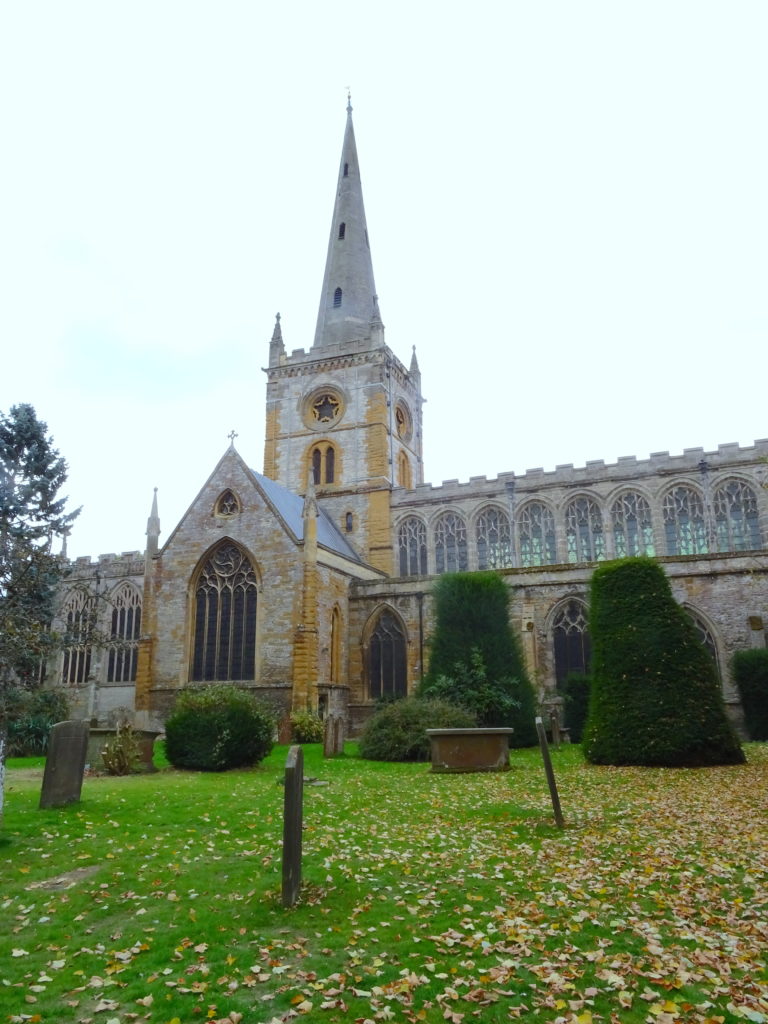
Holy Trinity Church Is Where Shakespeare Is Buried
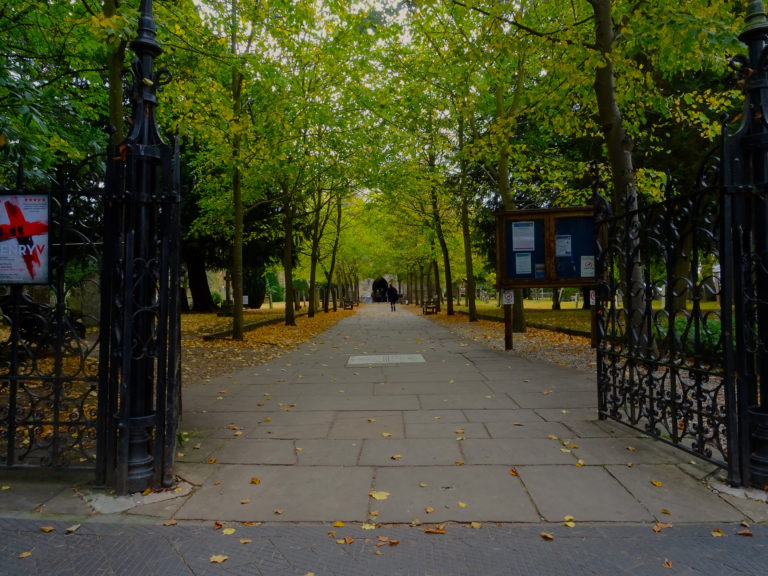
The Lime Trees At Holy Trinity Church
On the door to the church, there is a huge door knocker. This shows that criminals are able to have sanctuary here for 27 days. I can’t remember why or how, so feel free to educate me in the comments below!
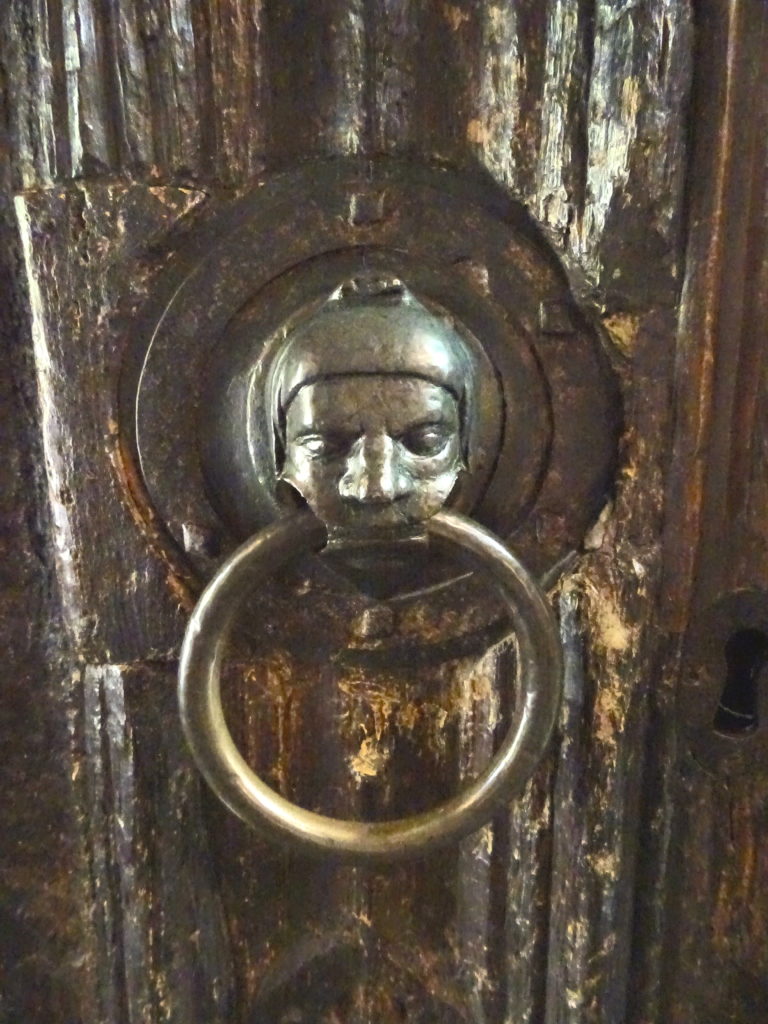
The Door Knocker Shows That Criminals Can Have Sanctuary

The Ceiling Of The Holy Trinity Church Tilts To The Left
Inside the Holy Trinity Church, it was quickly noted that if you look up you can see that the ceiling you can visibly see that it tilts to the left. Want to know why? This is apparently because on the cross Jesus’ head tilts to the left. So it is meant to represent that. Personally I think it was a mistake and they just came up with that story to cover up!
Shakespeare’s Grave
If you want to see Shakespeare’s final resting place, this is the right place. Although the church is free to enter, you do have to pay to see Shakespeare’s grave. It’s only a few pounds though, literally just a gesture. So totally worth it (and I assume it goes to the upkeep).
I was shocked to discover that his grave is in the floor of the church, I honestly expected it to be in the graveyard. Shakespeare and various family members are buried up by the altar, this is a very privileged position. Back in the day, you would only be buried in a marked grave for a year (I think), before being moved into a mass grave. Bu Shakespeare didn’t want this to happen, so he had a blessing and a curse put on his gravestone. Essentially, the gist is if you move him you will be cursed.
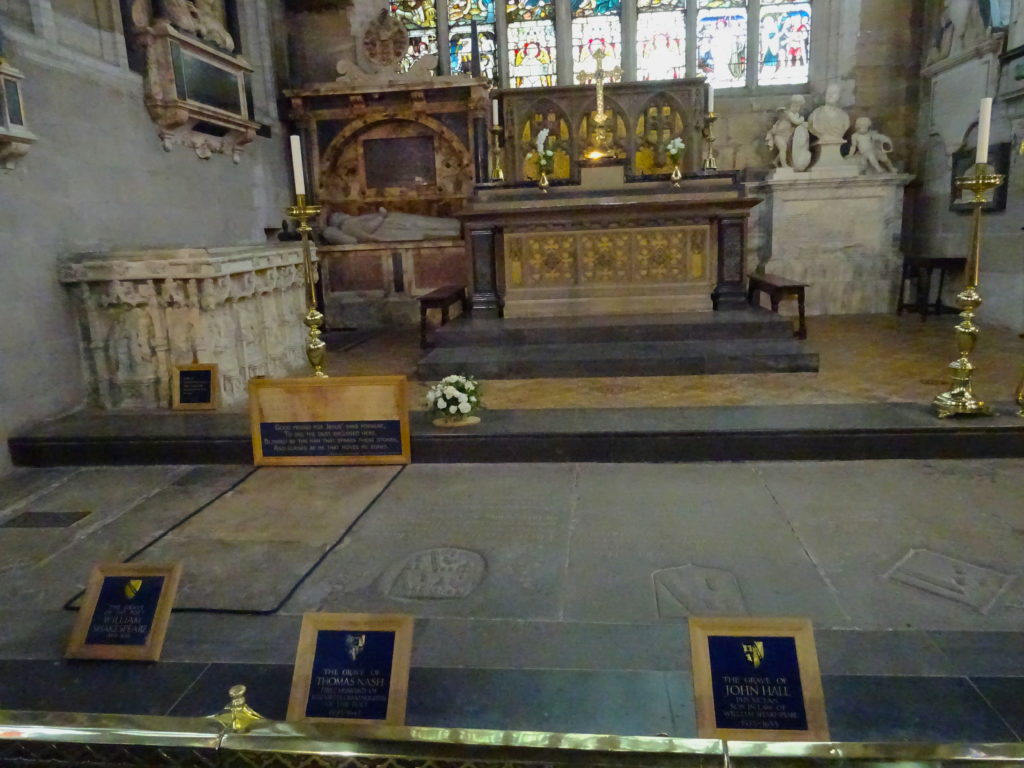
The Graves Of Shakespeare And Family Members
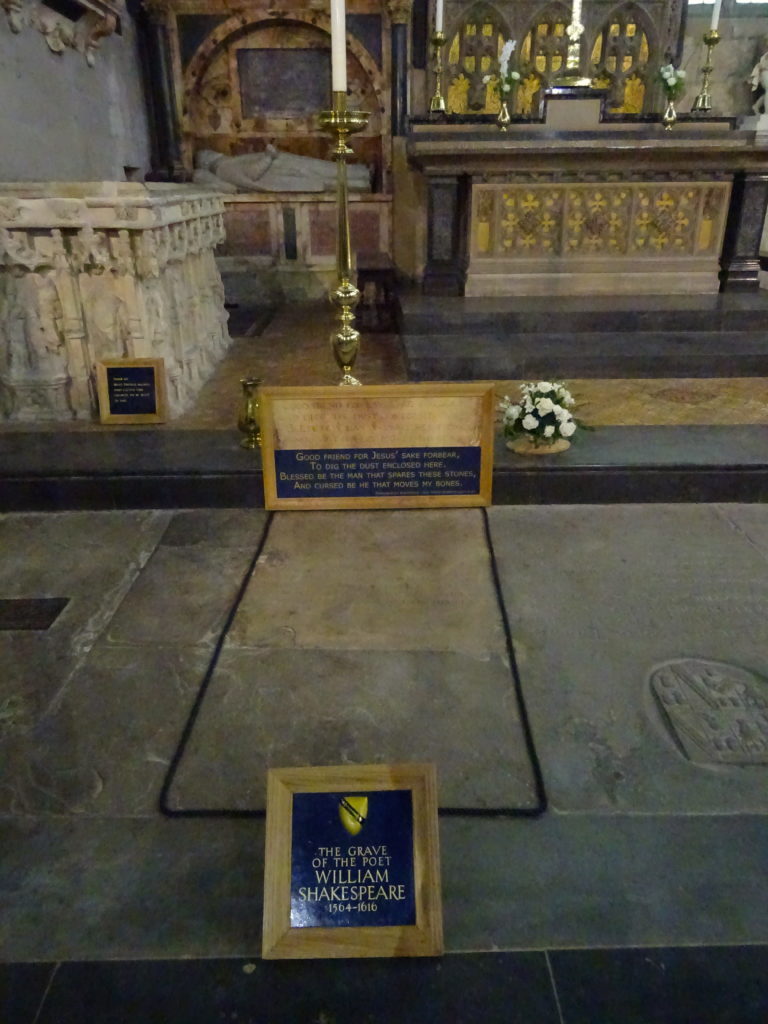
William Shakespeare’s Grave – Can You See The Blessing And Curse?
In this area, there is also lots of information on Shakespeare’s baptism, wedding a funeral, plus the differences with today’s traditions. This is one downside to coming here on this tour, there wasn’t enough time to read everything.
You will also find the original baptism font here, so this is where William Shakespeare was baptised. Our tour guide brought us together after a bit of time and pointed out a few things. For instance, the stain-glassed window is also worth noting, as it shows the seven stages of man (but in eight phases), from the monologue “All The World’s A Stage” from As You Like It. Also, a nice point is that Shakespeare’s baptism was recorded in Latin and his death in English, this shows how society had changed in a short time.
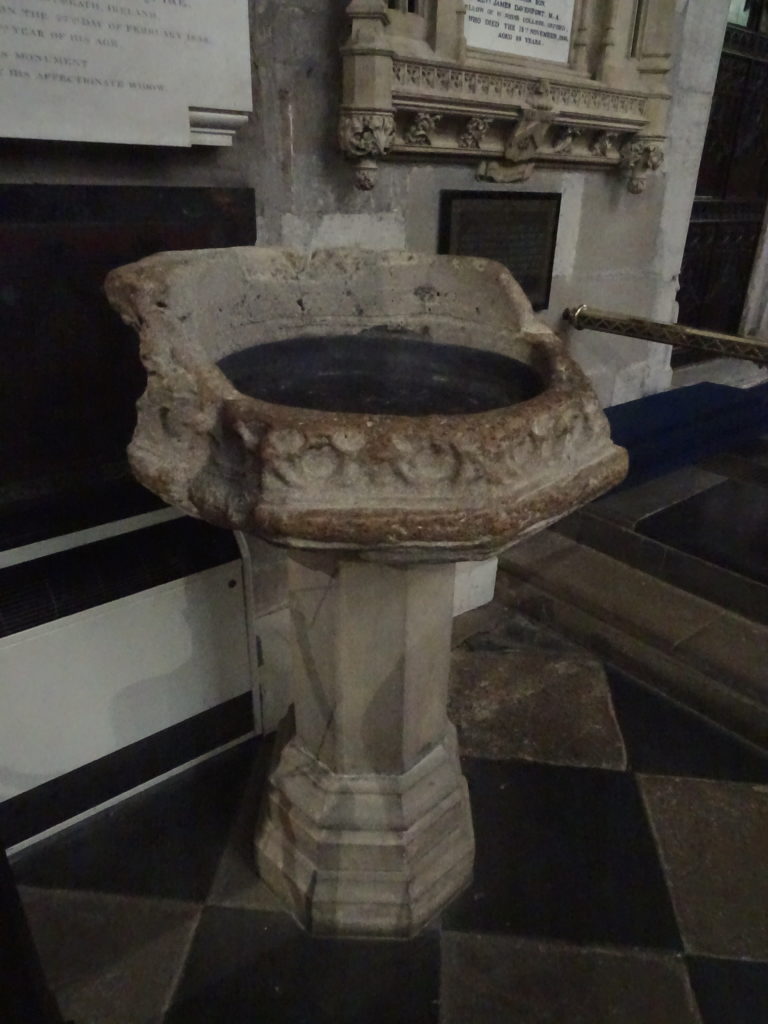
William Shakespeare’s Baptism Font
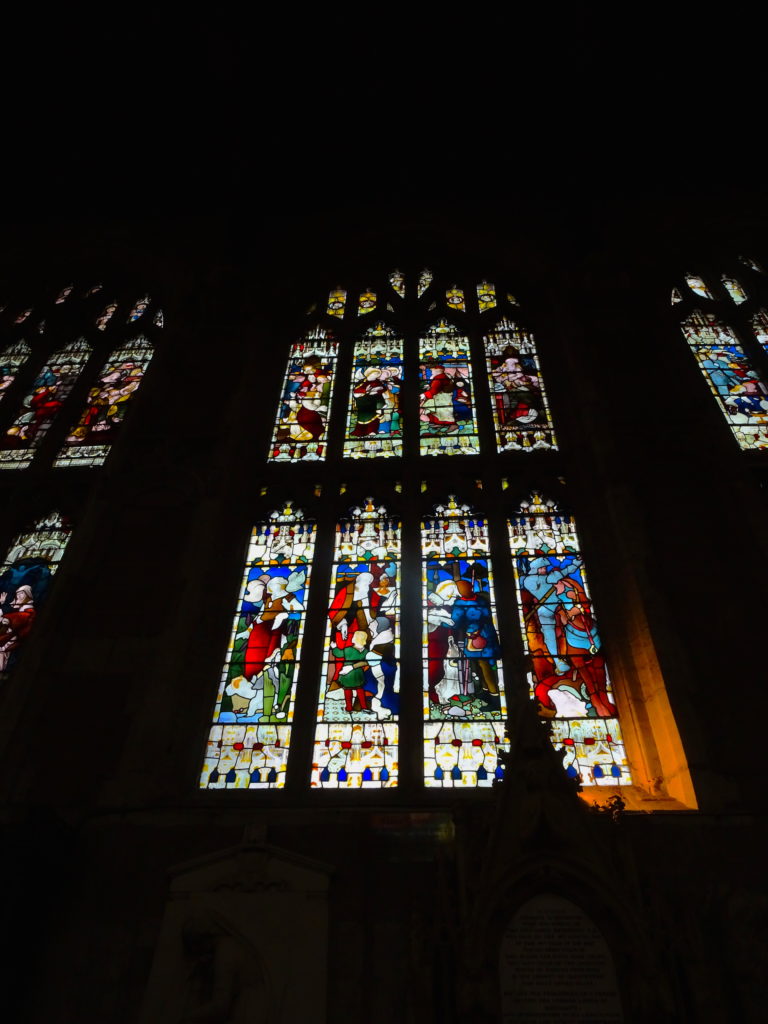
The Seven Stages Of Man In Eight Parts
A Shakespeare Statue
One part I was really excited to see was the likeness of Shakespeare, one of only three to be made around Shakespeare’s time. The artist was Gheerart Janssen, who lived and worked near the Globe Theatre, and so may have known William Shakespeare. Although the statue was completed after Shakespeare’s death, it was seen, and so presumably passed as a good likeness to his image, by people who knew Shakespeare.
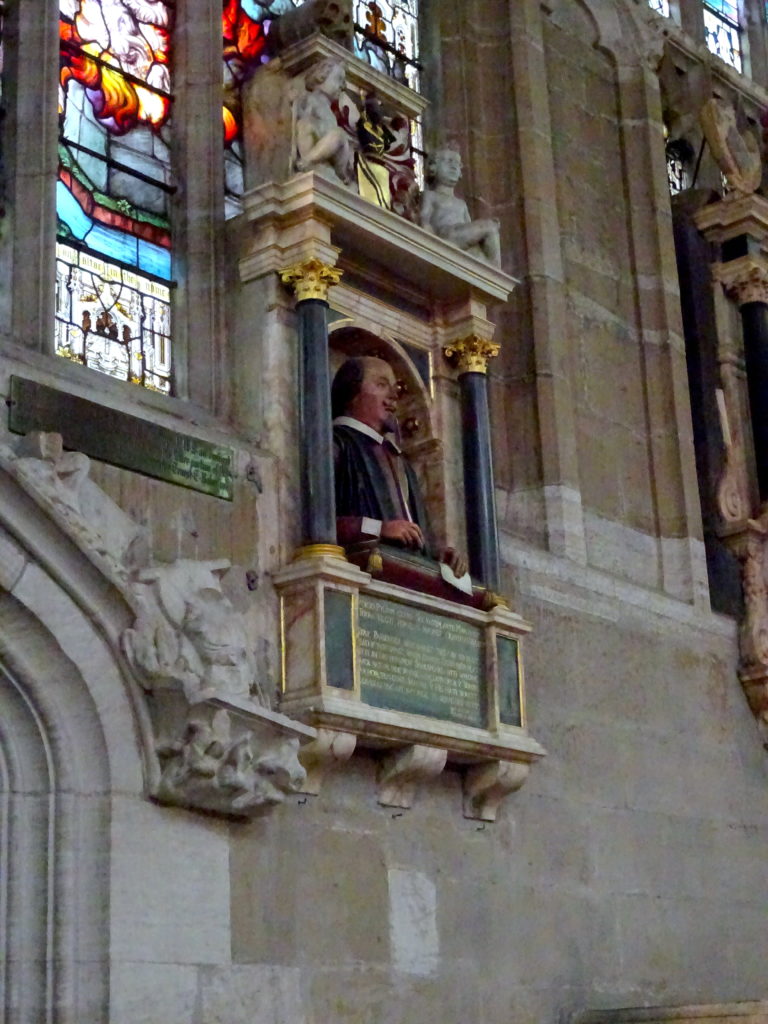
The Statue In Holy Trinity Church Is One Of Three Likenesses Done By Someone Who Might Have Known Him
The funny thing about this statue, we don’t actually know what it looked like when it was made. This is because in 1749 the colours were anonymously ‘refreshed’. Twenty-four years later a Shakespeare scholar was horrified by the colours and ordered it to be white-washed. This returned it to what he assumed, wrongly, was the statue’s original state. By the time it was repainted no one knew what colours to use and as colours give definition, much of the detail has been lost.
I was a little disappointed that when I asked our tour guide if this was the statue that had been whitewashed years after it was made and then repainted, she didn’t know. The above information is courtesy of a Bill Bryson book on Shakespeare that I read a few weeks before. So I had to look it up later and check that I had seen this. (Buy the Bill Bryson book here)
Theatres
Obviously, theatre is a big deal in Stratford-Upon-Avon, and so we had to have a stop about the theatres and actors. Originally there was the Shakespeare Memorial Theatre, but this burnt down in 1926. Now the Swan Theatre and the Royal Shakespeare Theatre sit side by side.
Not far from these theatres is the Dirty Duck (also known as the Black Swan). This is where actors go after they have performed, this includes famous faces.
Here we finished our tour and ended at one of the best lamp posts in the collection – the Israeli Lamp Post.
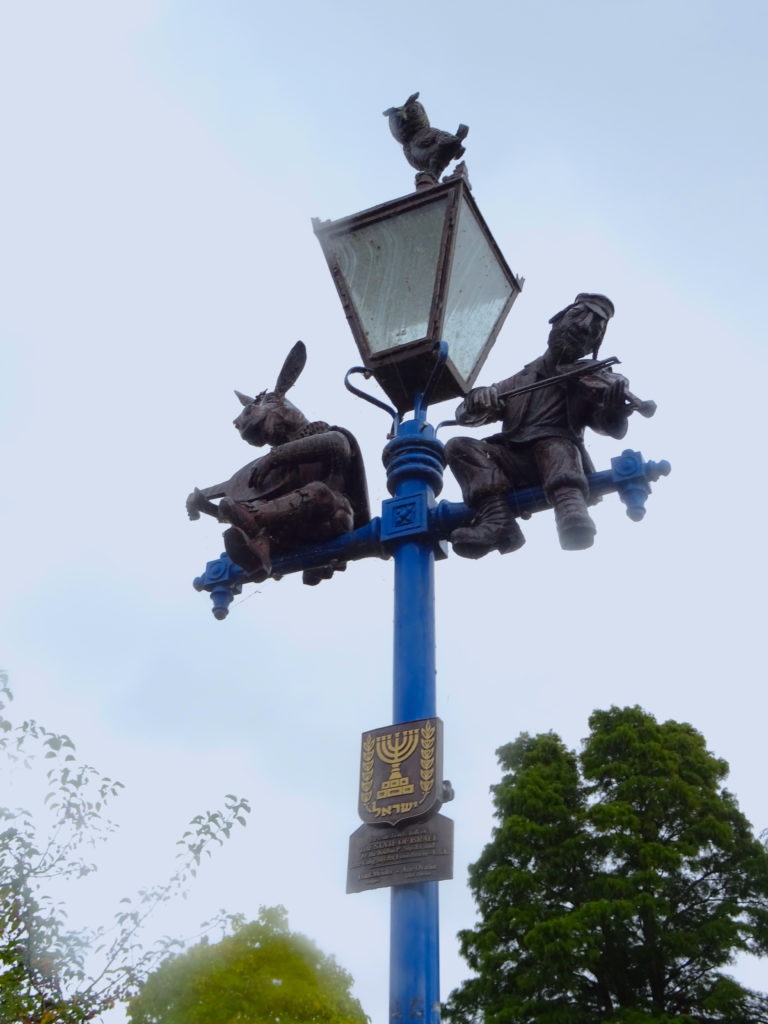
The Israeli Lamp Post Is One Of The More Decorative
Overall, a great tour, full of lots of information. Well worth the cost, especially as they gave us a little booklet with a load of discounts. The company also do a tour at night, but unfortunately, we did not have the time for this one as it wasn’t on every night when we were there. Be sure to check out some reviews of the tour here.
To Shakespeare’s Birthplace
Now we were done and had the afternoon to ourselves, so it was time to explore and learn more about Shakespeare. Which to be fair, was the whole point of the trip!
We decided to start a the beginning, at Shakespeare’s Birthplace (read reviews here). It was just a short walk from where the tour had ended. At any of the houses, you can either pay for just one or buy a cheaper ticket that allows you access into all five, called the Full Story Ticket (at the time of writing; to check updated tickets and pricing go here).
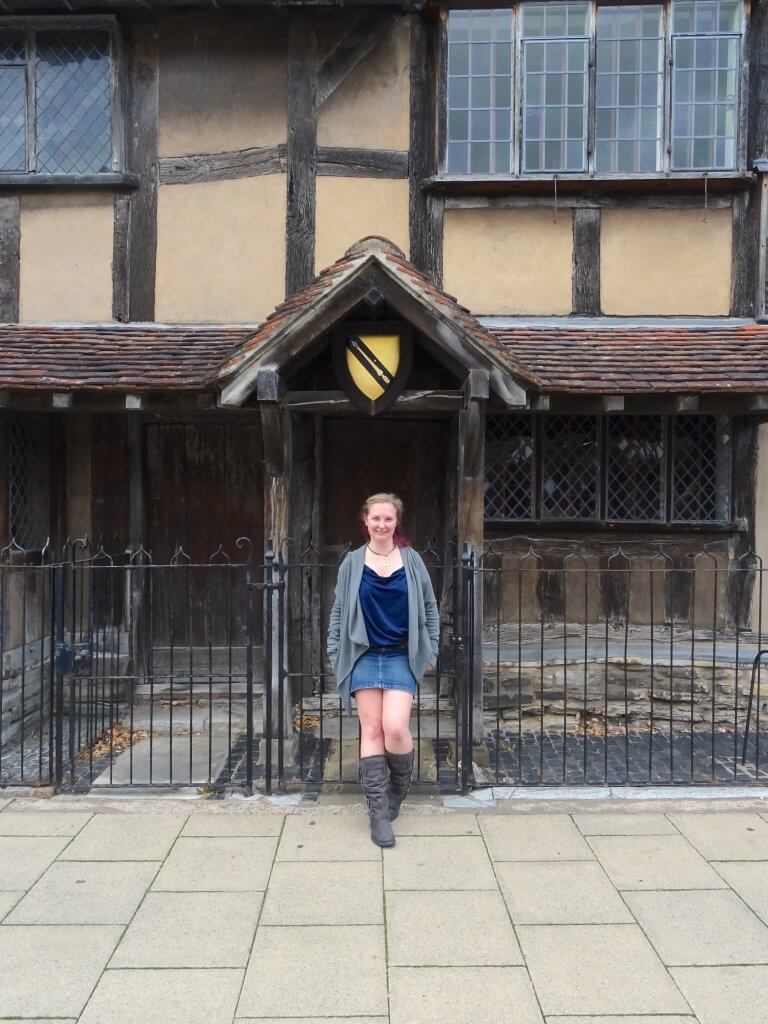
Outside Shakespeare’s Birthplace – Ready To Start My Shakespeare Birthplace Trust Adventure
Shakespeare, His Family And His Plays
Shakespeare’s Birthplace house is a good place to start really. As you go in there is a small museum about the famous bard. There is a video and lots of information about Shakespeare and what he has influenced over the years. You can also see carvings that represent his plays and a family tree of the Shakespeare family.
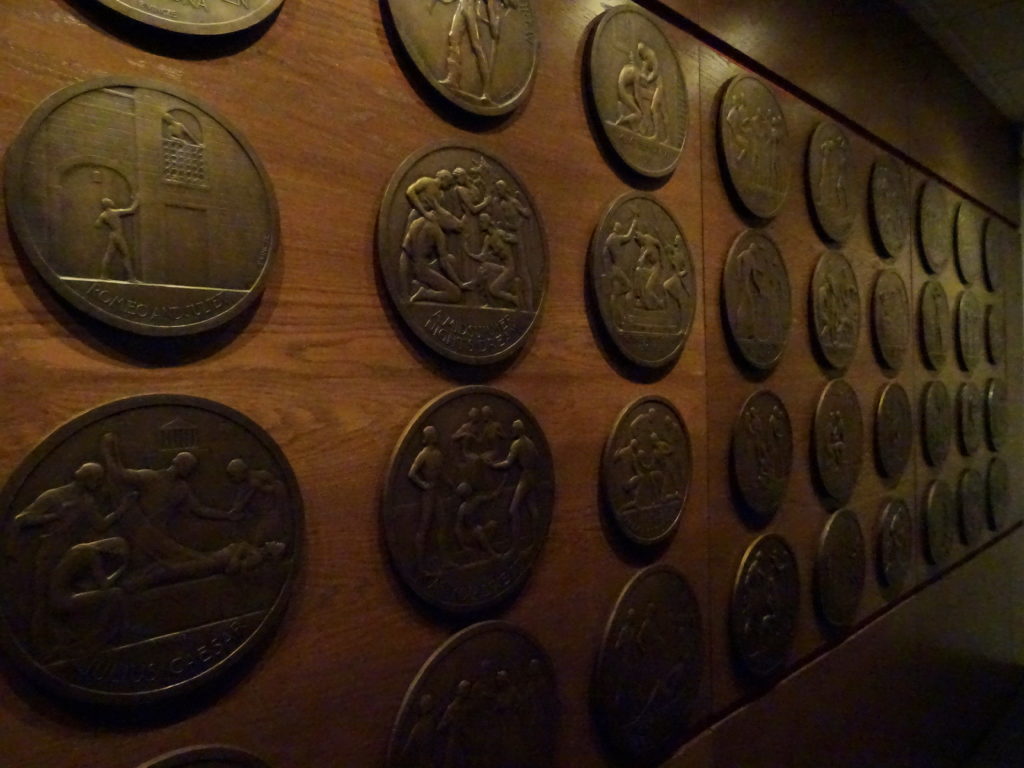
The Carvings Of Shakespeare Plays
Once through the small museum, I found my favourite bit. There is a massive wall with summaries of all the Shakespeare plays. I could have stayed there for as long as it took to read them all, but didn’t have the time. But luckily I could (and did) buy a smaller version in the gift shop.
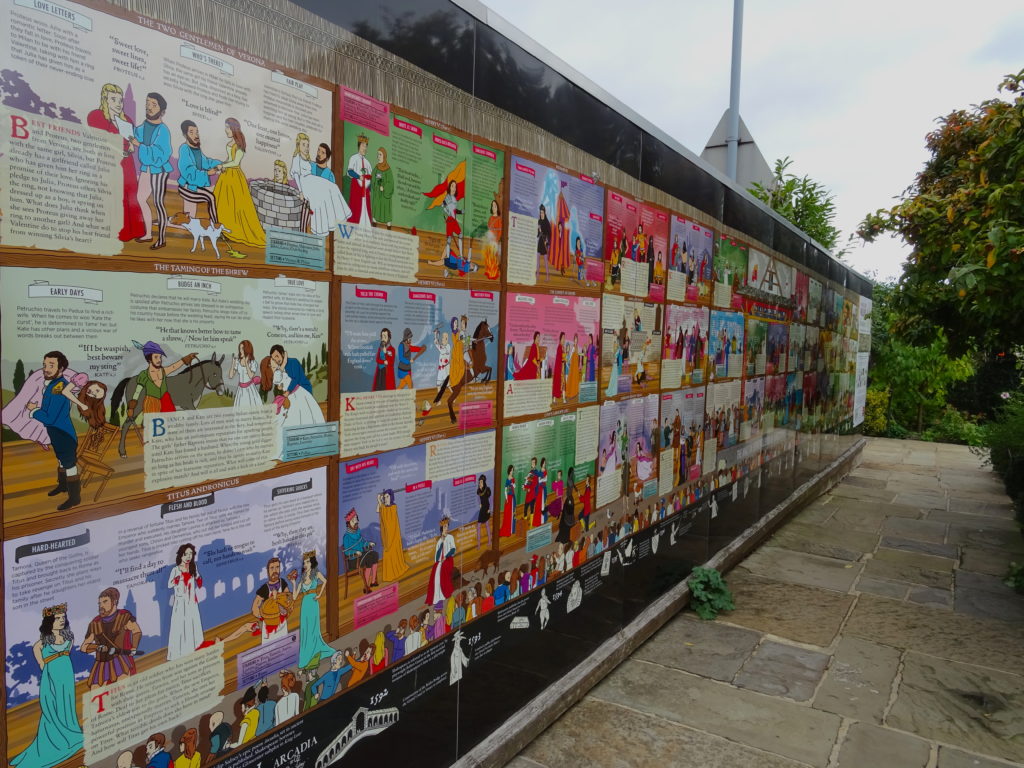
This Wall Had Me Reading It For Ages
If you ask me, from this point you get one of the best views of the house. You look through the gardens and can see the whole building. Yes, it might be the back of the house, but it still looks good.
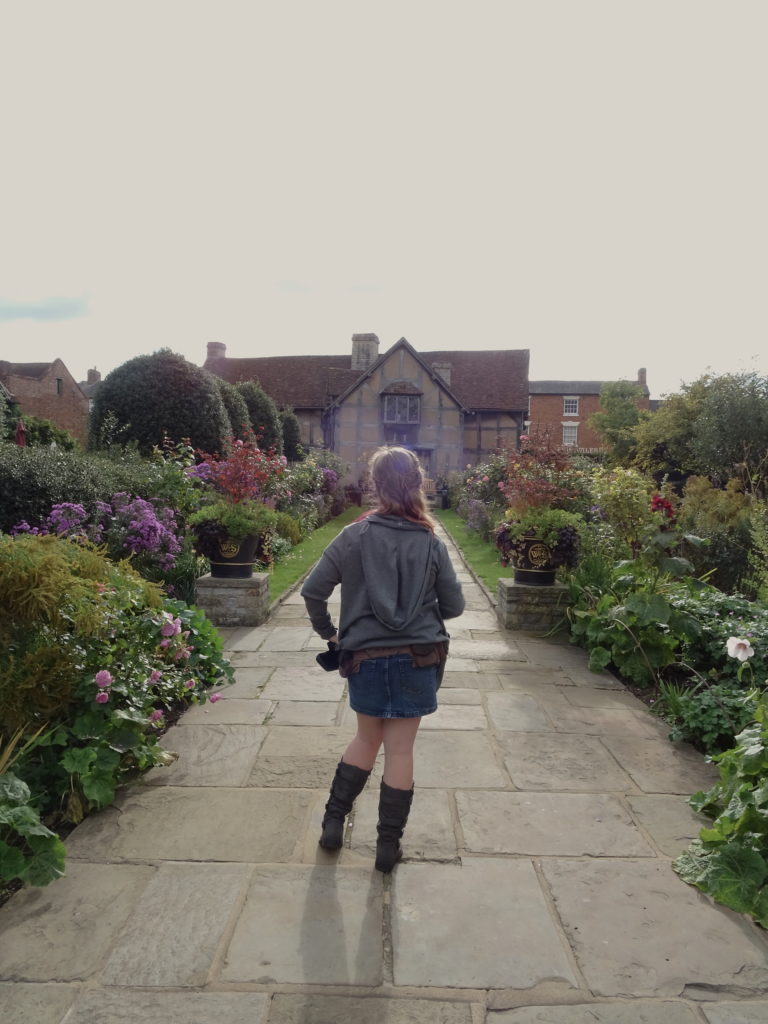
At the Back Of Shakespeare’s Birthplace, I’m Ready To Check It Out!
ShakespeariAnne
At the time that I visited, there was a small temporary exhibition in an outbuilding. I assume there is always a temporary exhibition that changes, but you will have to check for details. Anyway, when I was there, it was the ShakespeariAnne exhibition, which celebrated women.
This exhibition was Carrie Reichardt’s interpretation of Anne Hathaway. Her vision of Anne is as a quirky, passionate woman that married a Tudor entrepreneur. The exhibition also showed how consumerism and social media is changing the way in which we view history. It was amusing and quirky, with magazine covers and drawings. I thought it was awesome anyway.
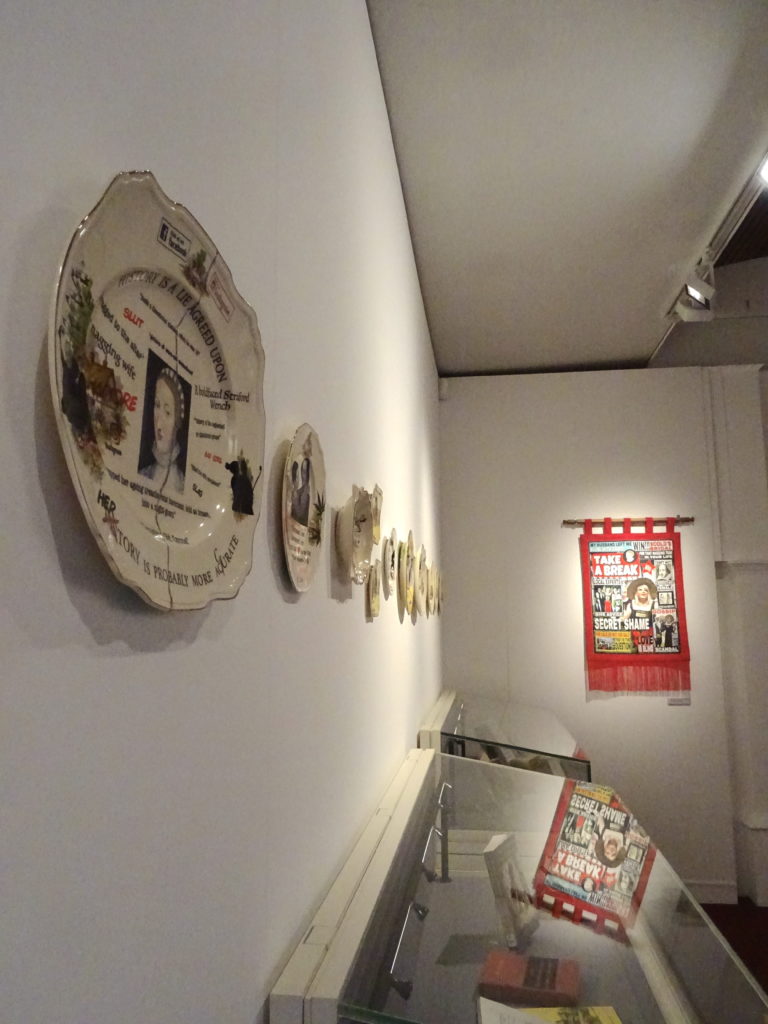
Some Of The ShakespeariAnne Exhibition
Into Shakespeare’s House
As we headed toward the entrance of the house, we noticed a couple of actors quoting Shakespeare. But unfortunately, they were just finishing up so we missed them… How annoying is that?
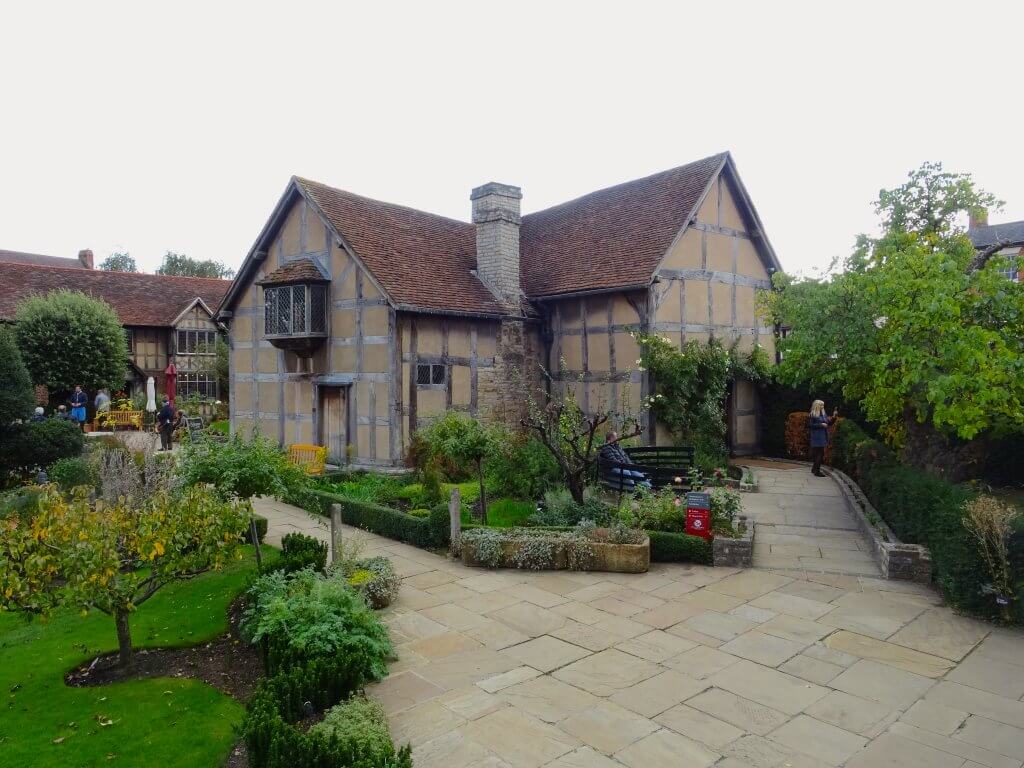
Shakespeare’s Birthplace Seen From The Gardens
As we entered into the first room of the house, there was a member of staff who was lovely. If anything, he got a little over-excited and wanted to tell us everything about the house. He knew so much.
The house essentially has a one-way system through it, with a few bits to the side. There’s lots of information in each room and actors around to give you even more information. It’s definitely worth spending at least an hour or so in the house exploring and learning.
The first room we entered after the entrance room, was the parlour. In here is the “best bed”, where it would have been in Elizabethan England. It might seem weird to have a bed in the parlour, but as this was on the ground level, people could see the bed through the window. If you were able to afford a guest bed you must be rich. It was all about showing off your wealth in Shakespeare’s day (not much has changed really, has it?)
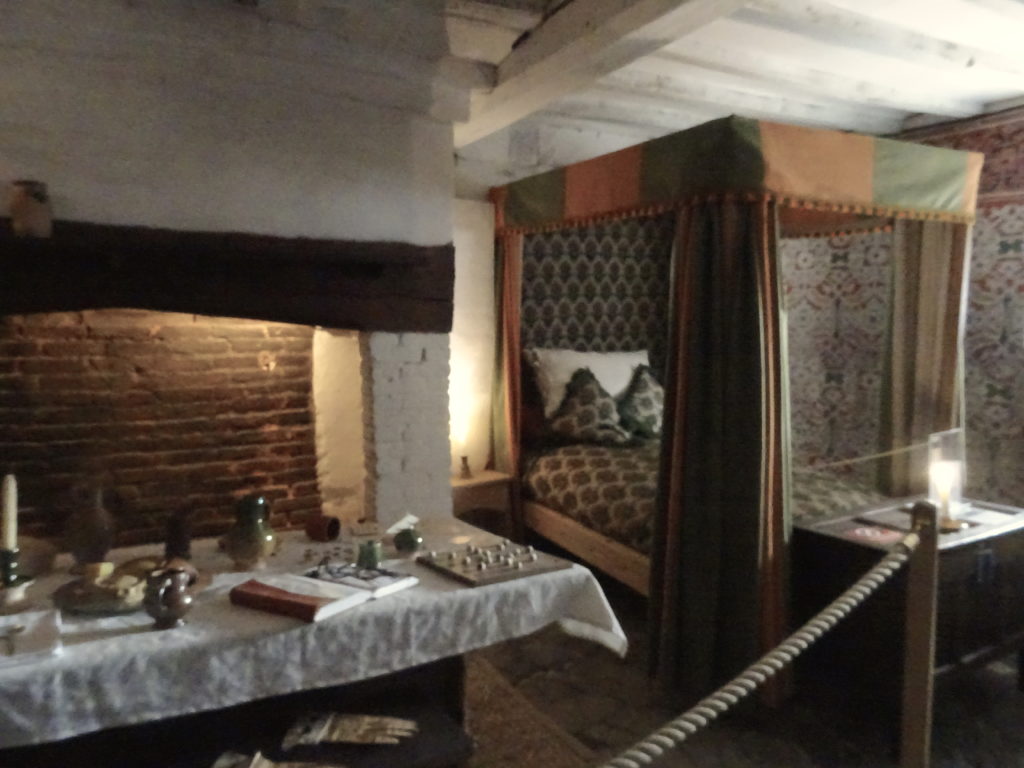
The Best Bed Would Be Kept In The Parlour To Show Off
I really enjoyed the information in the hall. Here was the board for eating (and where we get several old phrases and sayings from. There was information in this room on Sumptuary Laws, which I find fascinating. This is essentially the fashion police. In Elizabethan England, your class dictated what clothes you could wear and even what colours. As the Shakespeares were middle class, they had access to more styles and colours than lower classes.
Shakespeare Family And Admirers
The last room downstairs was the workshop; this was where John Shakespeare (William’s father) would have worked. John was a glover, he made gloves. So on display were various skins for gloves. One bit I found very interesting was the squirrels. I’d never thought about it before, but of course, there were only red squirrels in Elizabethan England (Greys are American). So how did they get grey fur? It was from the red squirrel’s winter coat. White fur was from the underbelly.
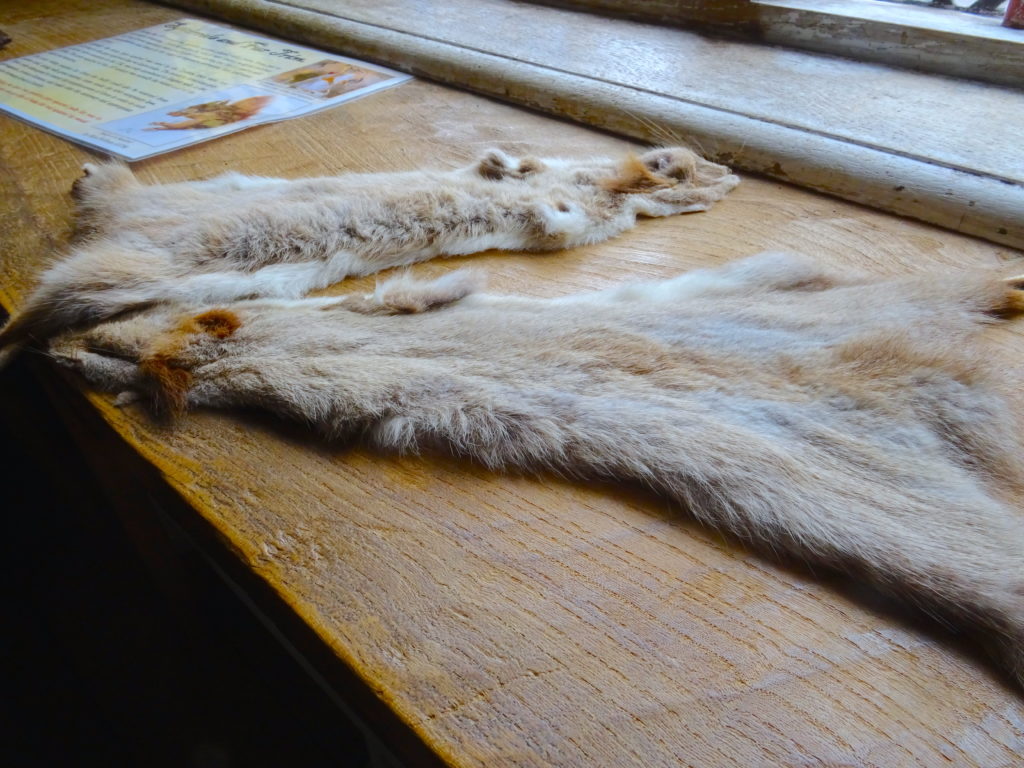
John Shakespeare Would Have Used Squirrel Fur To Make Gloves
Up the stairs and you enter the boys’ room, where the brothers shared, there was also an attic room above this. The sisters were on a ‘shelf’ above the workshop. Here there’s some great information on folklore and its influence. Fares and demons were thought to come out at night and bad dreams were caused by a creature called the “nightmare”. These tales and superstitions obviously influenced Shakespeare’s work. The room also had an awesome feature wall, a big bold pattern in black and white, I was half tempted to see if I could find it anywhere!
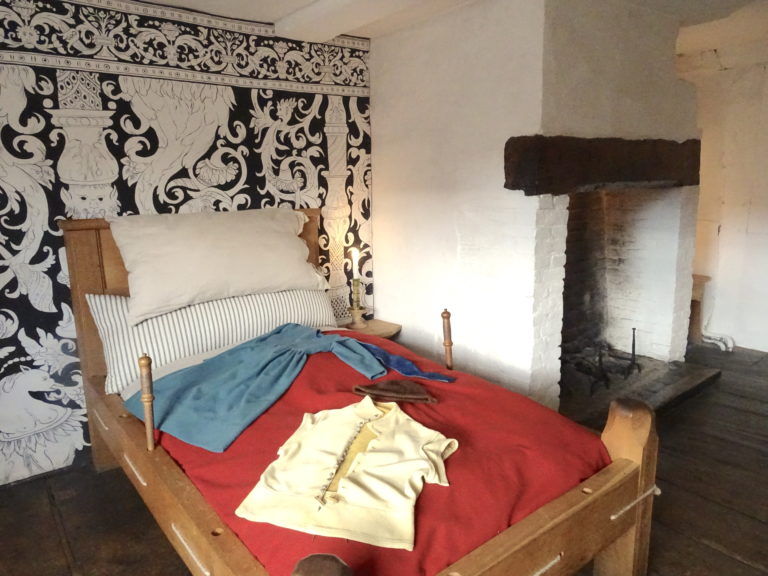
Anyone Else Love The Wallpaper?
Another favourite bit of mine was a window on display, this used to be the birthing room’s window but has been taken out and put on display. In this window loads of signatures have been scratched, including various famous writers, as a nod to Shakespeare’s influence. One famous signature you can see here is that of Sir Walter Scott. Though we did have to ask to have this pointed out to us – there are so many signatures it’s like trying to see the wood through the trees!
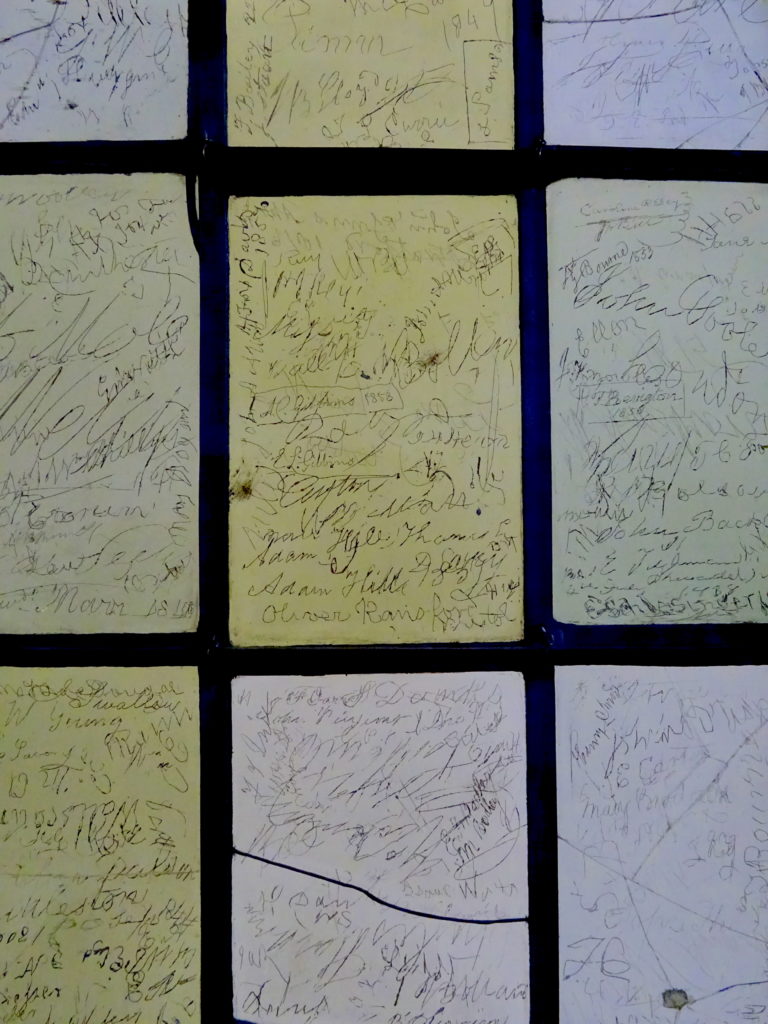
Can You Spot Sir Walter Scott’s Signature?
As there are so many signatures, the window had to be moved to stop visitors joining in and adding their names, plus the window was getting damage.
Shakespeare’s Birthplace
The next room was the final room of the house; the birthing room. This is where it is believed that Shakespeare was born, although there is no actual proof of this, it is just very likely.
As the house was quiet, we had the room to ourselves, apart from one member of staff, who was lovely. As we were the only tourists she was happy to tell us everything that she could about the room. One thing that I found very interesting was how there was actually a pull out drawer under the bed; this would be pulled out when a bay was born and used for a place for the baby to sleep.
Leaving the room, we could see that the actors were in the garden again performing, but we didn’t rush down; here was still some bits to read!
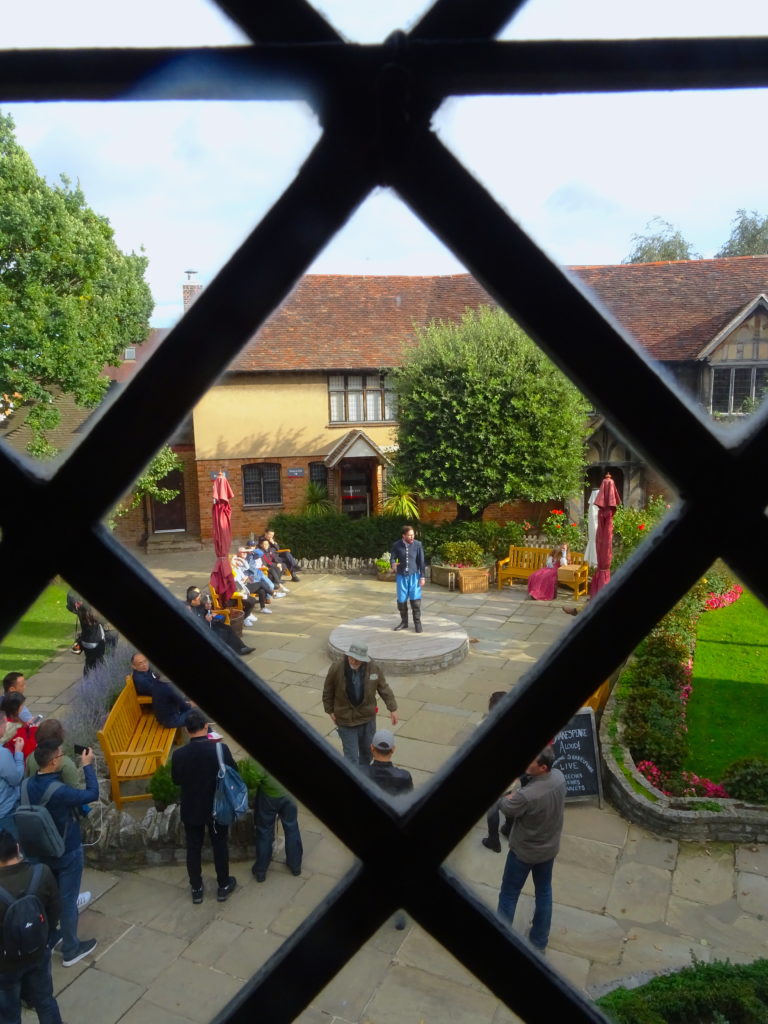
Spying The Actor In The Garden
Shakespeare’s Inn
One thing I didn’t know was what happened to this house once Shakespeare and his family moved to New Place. Can you guess? As Shakespeare already had New Place when he inherited the house, he had no use for it, so he turned it into a business. He rented it out and allowed it to became an inn, “The Swan & Maidenhead”. The inn had an extension added too.
The house remained an inn until it closed in 1846 and during this time it was visited by many literary pilgrims, such as those that scratched their names into the window of the birthing room.
Do you know why pubs were so important in Tudor England? Quite simply ale was the safer beverage. However, there were also plenty of punishments for drunken behaviour, so it’s a bit of a catch twenty-two really. One of the punishments was to wear a “drunkard’s cloak”, which was a hollowed-out beer barrel.
Shakespearian Plays
After learning about the house’s time as an inn, it was back out into the light. Luckily we had not missed the actors this time and so got to watch them perform. They did various parts of The Taming Of The Shrew, Hamlet and Macbeth, plus some sonnets and even requests, they were really good. I heard bits that I have heard before when watching plays and other quotes that I have neither read nor heard before.
We actually only caught the last part when we joined them, as the couple were performing a part of The Taming Of The Shrew, but decided to hang around to watch some more. In all honesty, I could have stayed there all day watching them.
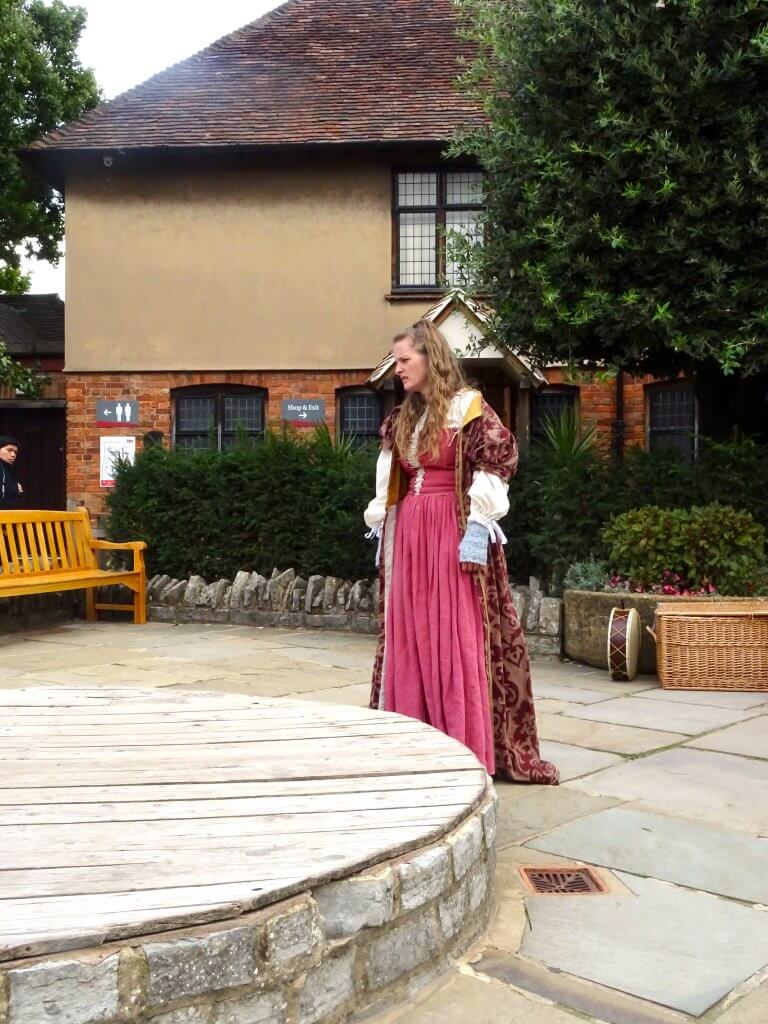
Actress At Shakespeare’s Birthplace – I Could Have Sat Watching The Performances All Day
Obviously, to leave the house you have to go through the gift shop. And for once I actually bought some stuff. I think I was a little over-excited over Shakespeare. So three books and one poster later we were back out in the main street of Stratford ready to explore more.
Just Enough Time
With just over an hour before closing, we decided to quickly head over to New Place (for reviews click here). This is the location of Shakespeare’s second house that he bought later in life. This house was the family home from 1597. Although the house itself has been demolished you can still visit this area, the Trust has done a good job on it since they took it over in 1884. I think the lack of house helps you to envision just how big this plot of land is, so you can see how rich Shakespeare had become to be able to afford such land.
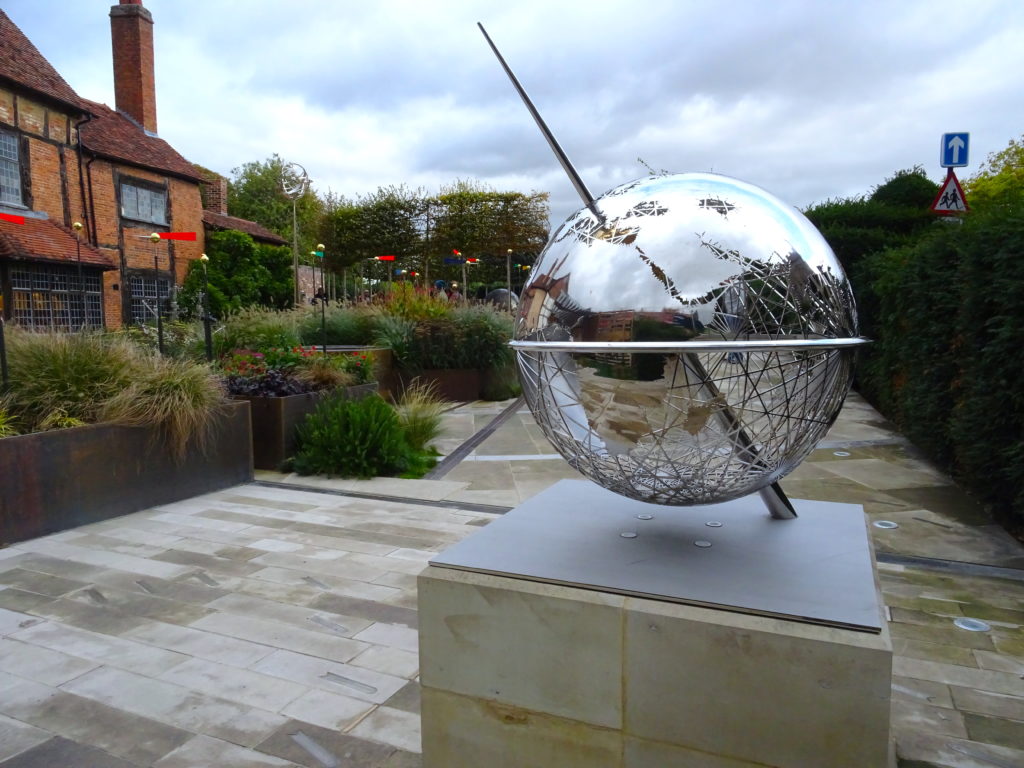
There Are Very Interesting Sculptures At New Place
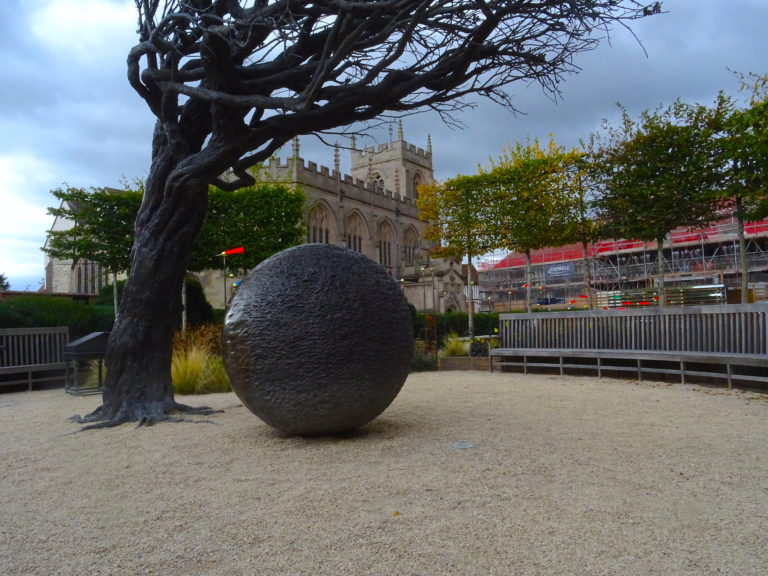
There Are Lots Of Sculptures A New Place
So instead of a house, there are gardens, which Shakespeare probably would not have had as his family would’ve worked the land. There would have been orchards, vegetable patches and even animals. As you enter you can see the deeds to the house, with Shakespeare’s seal, and you will notice sculptures, which I believe are inspired by Shakespeare’s works. There are also quotes on the floor as you walk into the grounds.
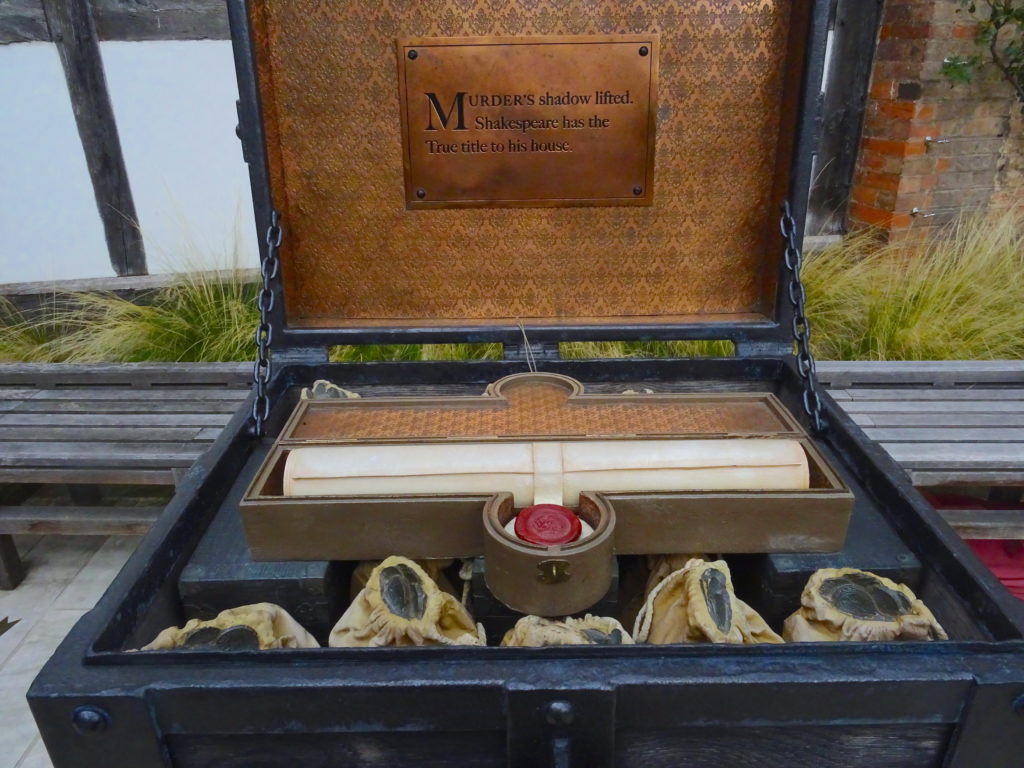
The Deeds To New Place, The House That Isn’t There
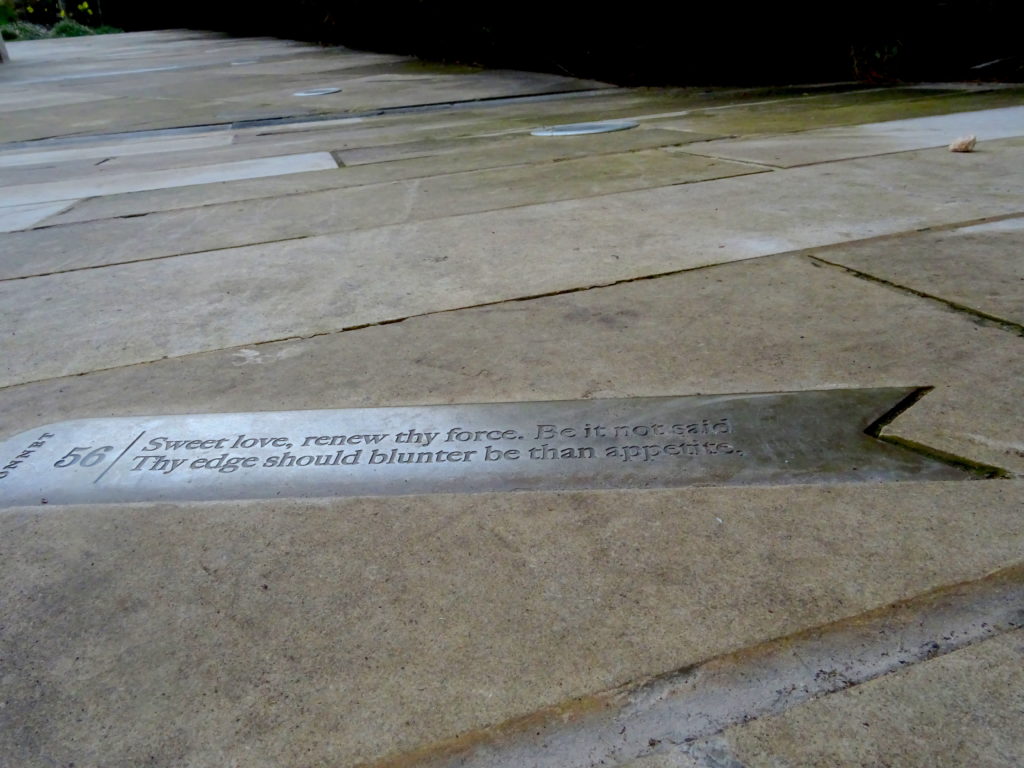
At New Place Be Sure To Look Down To See Some Quotes
The Wrong Time Of Year
Unfortunately, we did visit at the wrong time of year, as one of the main features of Shakespeare’s New Place the Tudor Knot Garden. This has been restored in keeping with designs by Ernest Law. The restoration is based on illustrations in The Gardeners Labyrinth by Thomas Hill. These gardens were very popular in Shakespeare’s time, though it would have been those that were very wealthy that had them. It is unlikely that Shakespeare had such a garden as he would have used the land to feed his family.
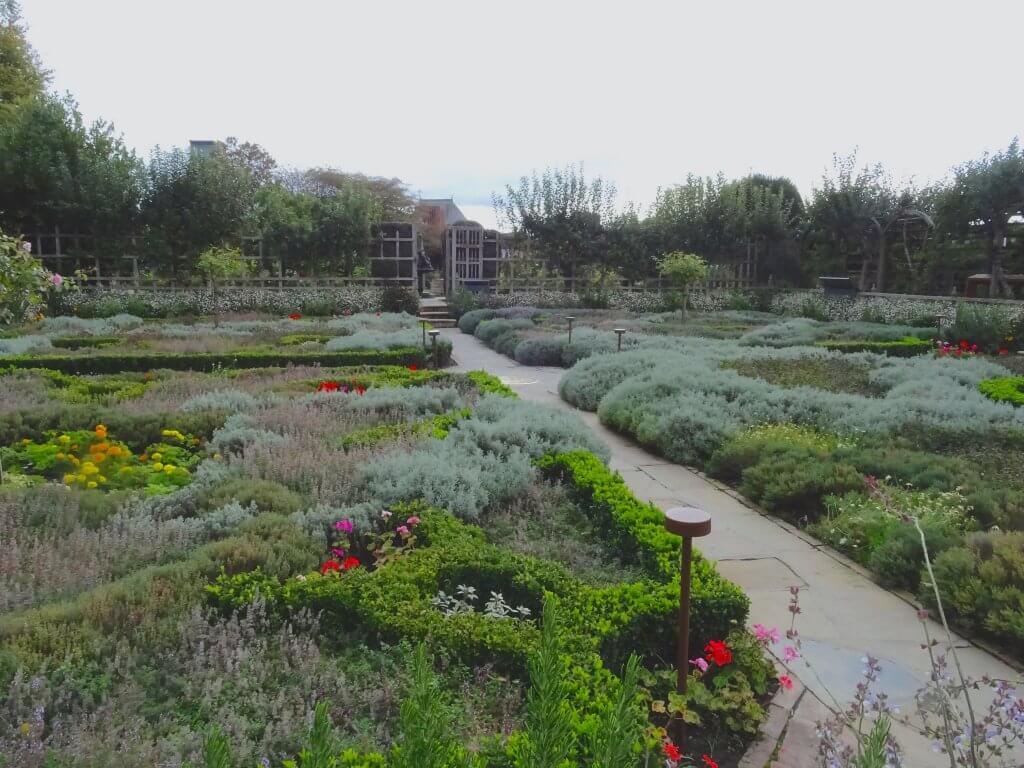
It Was The Wrong Time Of Year For The Knot Garden
As I was there in October, the Knot Garden looked a little barren. There was plenty of green, but not many flowers. I would definitely love to visit this garden when it is in full bloom.
Why Is New Place No Longer There?
The house was knocked down in 1759 by the owner, Gastrell. There is a section in the garden where you can learn a bit about this. It is the only place where I have seen (or heard) both sides of the story. The information portrays him as both a villain and a victim. Previous owners allowed tourists to enter the property, but Gastrell wasn’t keen at all on this. Basically he got frustrated by the Shakespeare tourists intrusions to his property and so tore it down. He even chopped down an old mulberry tree that is believed to have been planted by Shakespeare.
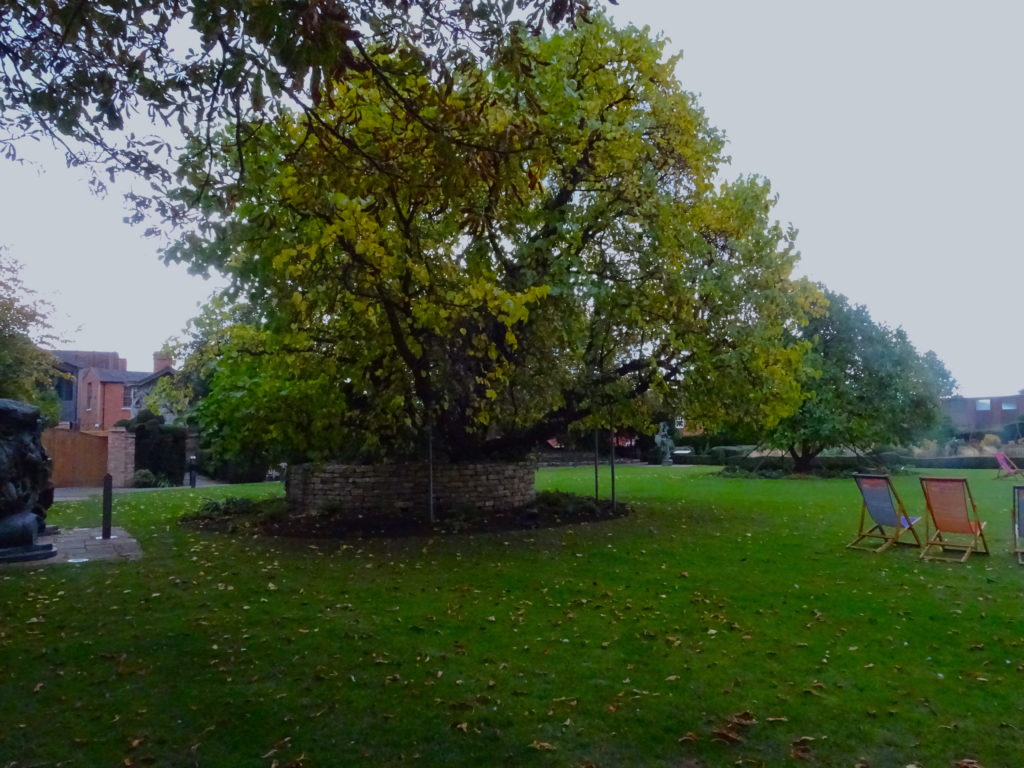
The Mulberry Tree In The Great Garden Has Links To Shakespeare
In the Great Garden, there is a mulberry tree still though. This is believed to have been grown from Shakespeare’s mulberry tree. So there is still some memory of Shakespeare’s life here.
Sculptures In The Garden
I really enjoyed exploring the Great Garden at New Place, especially finding the Greg Wyatt sculptures (not like they’re hard to find). Anyway, there are nine sculptures (at the time of writing), and each shows an interpretation of one of Shakespeare’s play. There’s A Midsummer’s Night Dream, Hamlet, King Lear and Macbeth. I loved these sculptures, they took Greg Wyatt over a decade to create these. Each sculpture also has a quote from the play that it represents. I just love interpretations of plays.
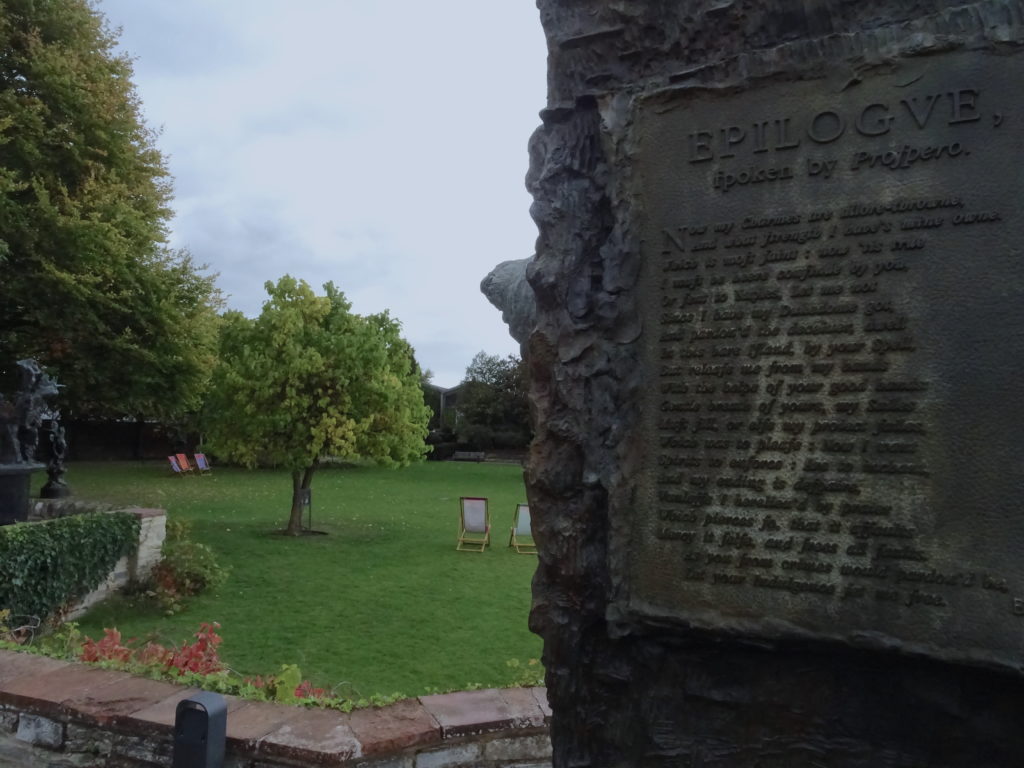
New Place Great Garden

I Love The Sculptures That Give An Interpretation Of Shakespeare Plays
Obviously, there is also a sculpture of the famous bard too. It’s quite the dramatic sculpture of the bard here, as he is sat between the Dramatic Muse and the Genius of Painting. The sculpture was created by Thomas Banks and originally found in front of John Boydell’s Shakespeare Gallery in London. When the gallery ran out of money, items were sold on, including this piece, which eventually came to rest in the Great Garden at New Place.
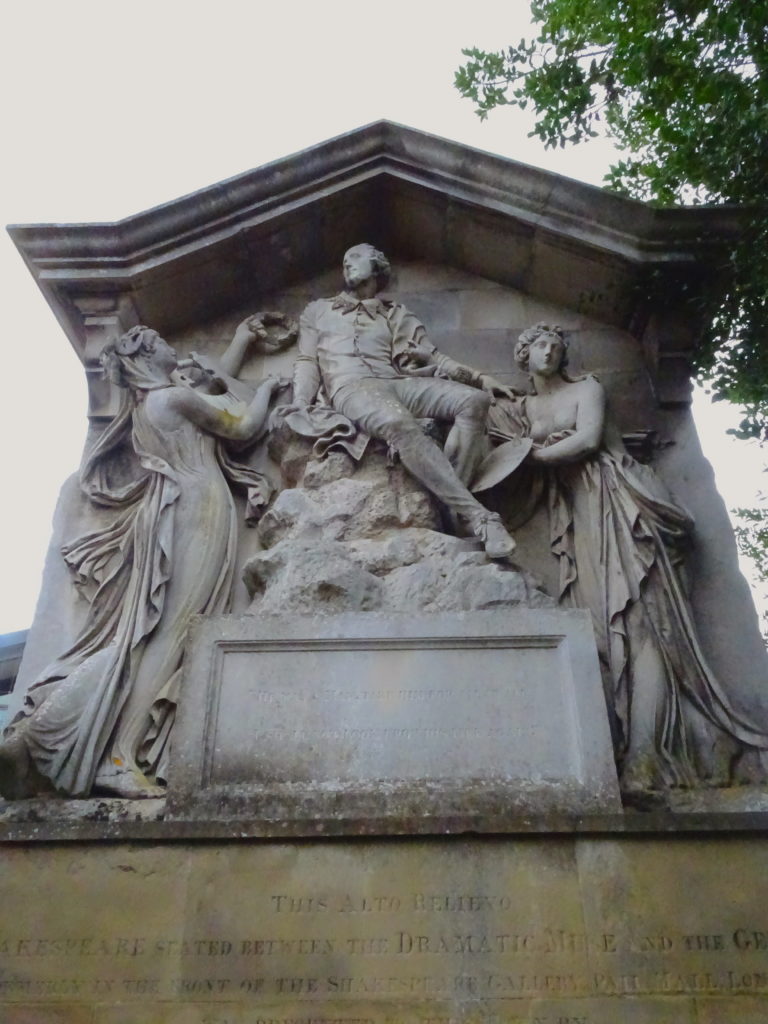
The Statue Of Shakespeare At New Place
At the back of the garden, there is also another interesting piece. You can find a column from the old Market Hall. The Market used to stand just down the road from New Place, however, due to various damages and the hall being used as different things (such as a prison), the building was remodelled into the Town Hall. The column found here was saved somehow and somehow ended up in this garden, though I do not know how.
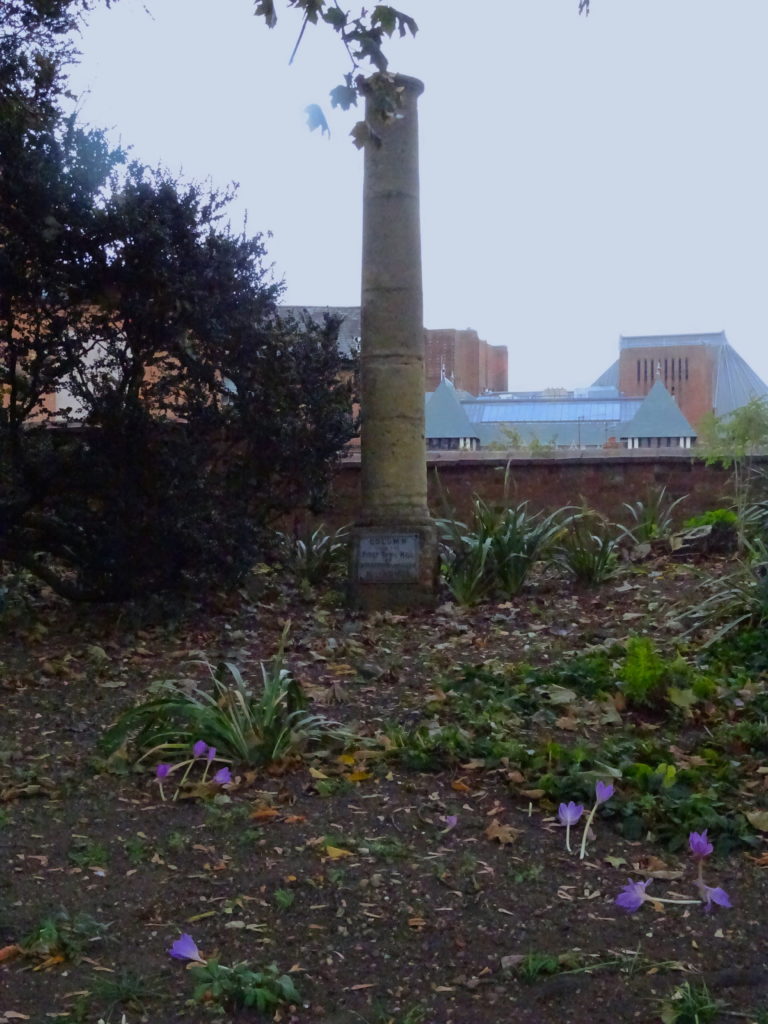
The Market Hall Column Seems Just A Bit Random
The Museum At New Place
After exploring the gardens we just had time to head into the museum for a look round. Luckily, it was a small museum, or we wouldn’t have had the time. Inside you can find items that were dug up on-site, such as bits of pottery, and a model of what the house would’ve looked like. There was also a dress-up area (my favourite), information on Shakespeare’s will and a really cool book that has been modelled into what I believe is a scene from The Tempest. It looked awesome whatever it was.
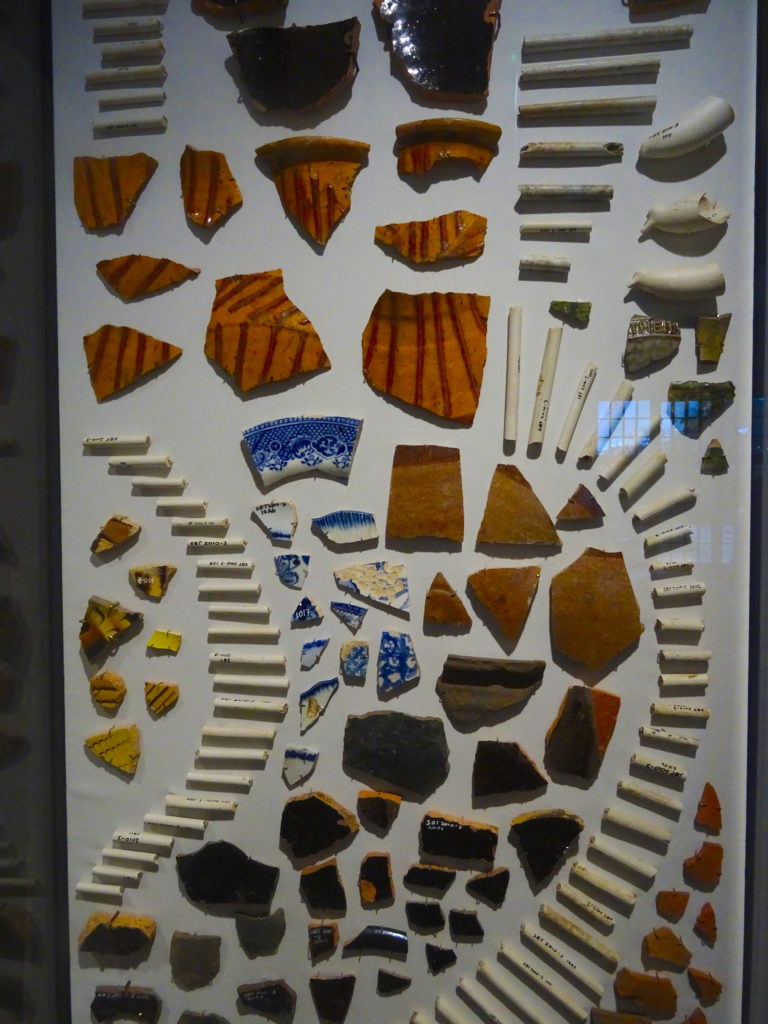
Some Of The Pottery That Was Found At New Place
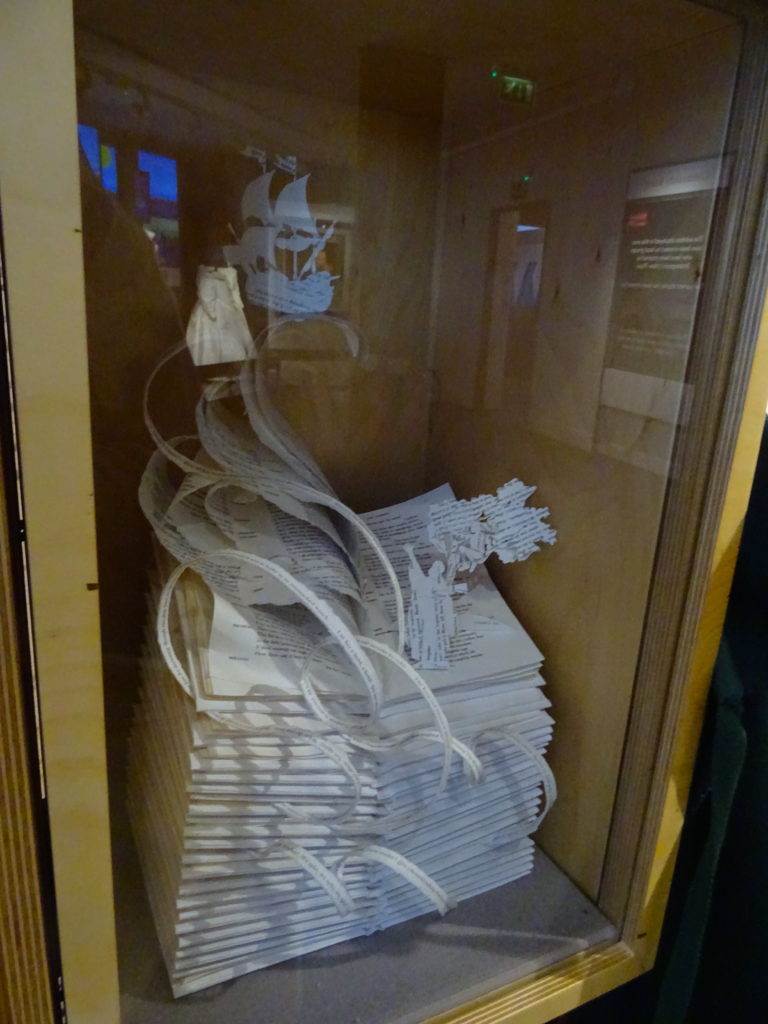
I Think This Shows The Tempest
However, one of the best bits of the museum area is the view. Seriously, you get some of the best views of the gardens from a balcony off the exhibition rooms.
Literally the last people out of the door, we headed out back into the town to just wander.
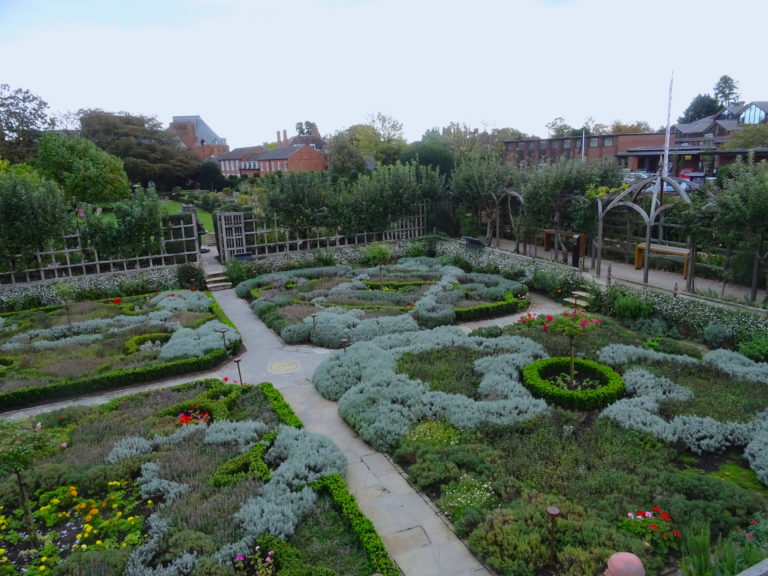
You Get A Great View Of The Knot Garden From The Museum
The Gower Memorial Statue
Our wanderings took us to Bancroft Gardens, by the river. I think that this is a really cool statue. There are four corners and a little away from the main statue on each corner is another statue, a character. Shakespeare is in the middle of it all. Each character represents a different genre of Shakespeare’s play. So you have lady MacBeth for tragedy; Hamlet for philosophy; Falstaff for comedy and Prince Hal for history. Behind each character, on the main statue, is a bronze mask and flowers to represent the character.
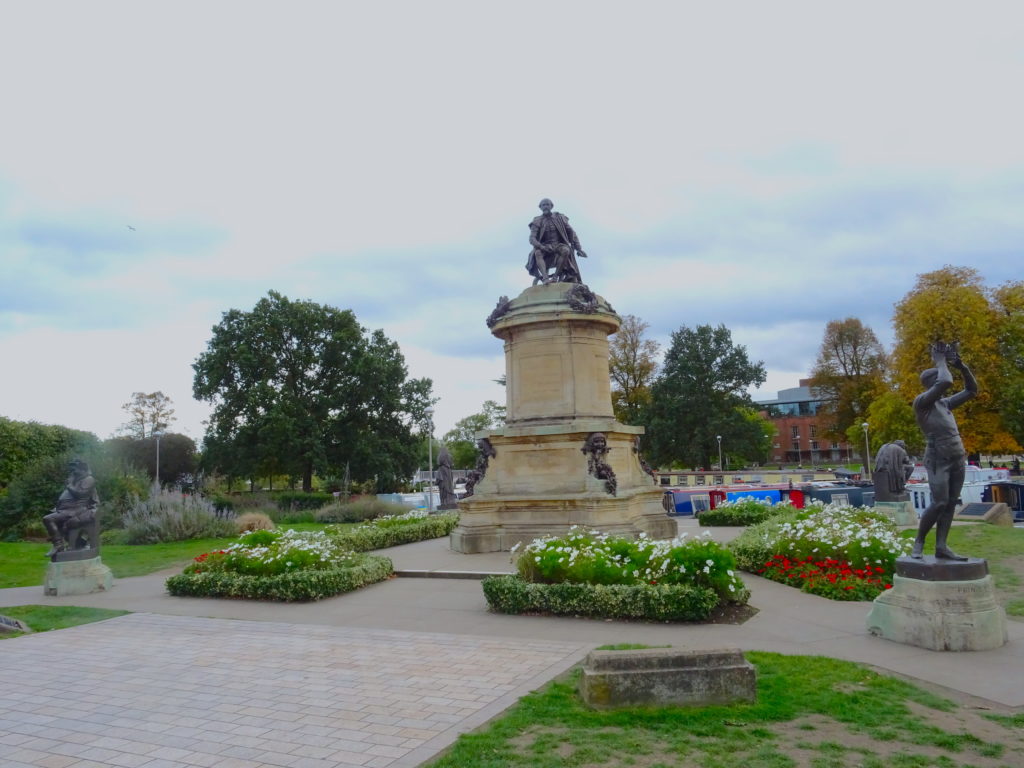
The Gower Memorial Statue Has Shakespeare In The Middle, Surrounded By Play Genres
The statue was given to Stratford in 1888 and was designed by Lord Ronald Gower. It wasn’t originally at Bancroft Gardens but had to be moved here.
If you visit it’s definitely having a walk around the statue and really taking a good look (click here for reviews).
Some Pub Grub
After admiring the Gower statue, we decided to just generally wander around. The Bancroft Gardens are pretty, with bridges over the river. Even though it was the end of autumn it wasn’t too cold and was nice to wander around.
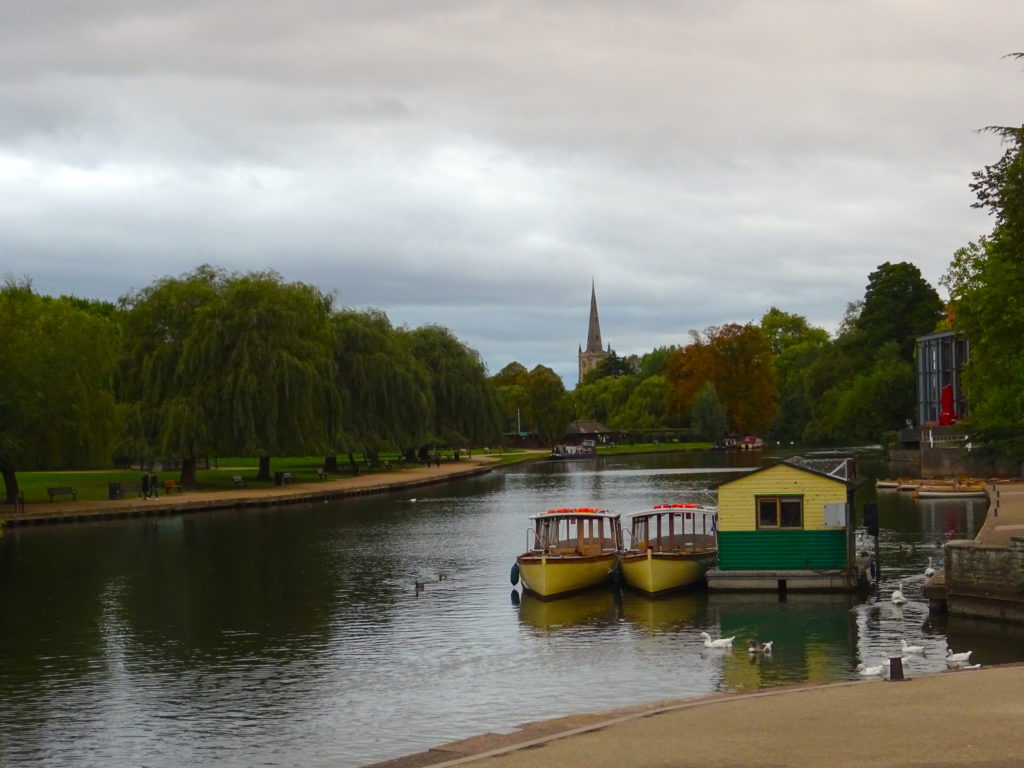
There Were Some Great Views From Bancroft Gardens
As the evening drew on, we decided it was time to grab some food. As we had a discount at the Dirty Duck (check out reviews here) from the tour we did earlier, we decided to head there. This pub is a Greene King, which are generally pretty ok. Apparently this is where many of the actors from the theatres go after performing. They have also had many famous actors and actresses through the doors, such as Judy Dench.
We were pretty hungry, and as we had the discount we went a bit mad. Greene Kings are usually a decent price, but with the discount, it was cheap. So we got a sharing platter to start, then I had sea bass and scallop risotto, whilst Dave went for fish and chips.
The food was standard pub grub. Not too expensive, nothing too impressive. Pretty good food at a decent price (even better with the discount).
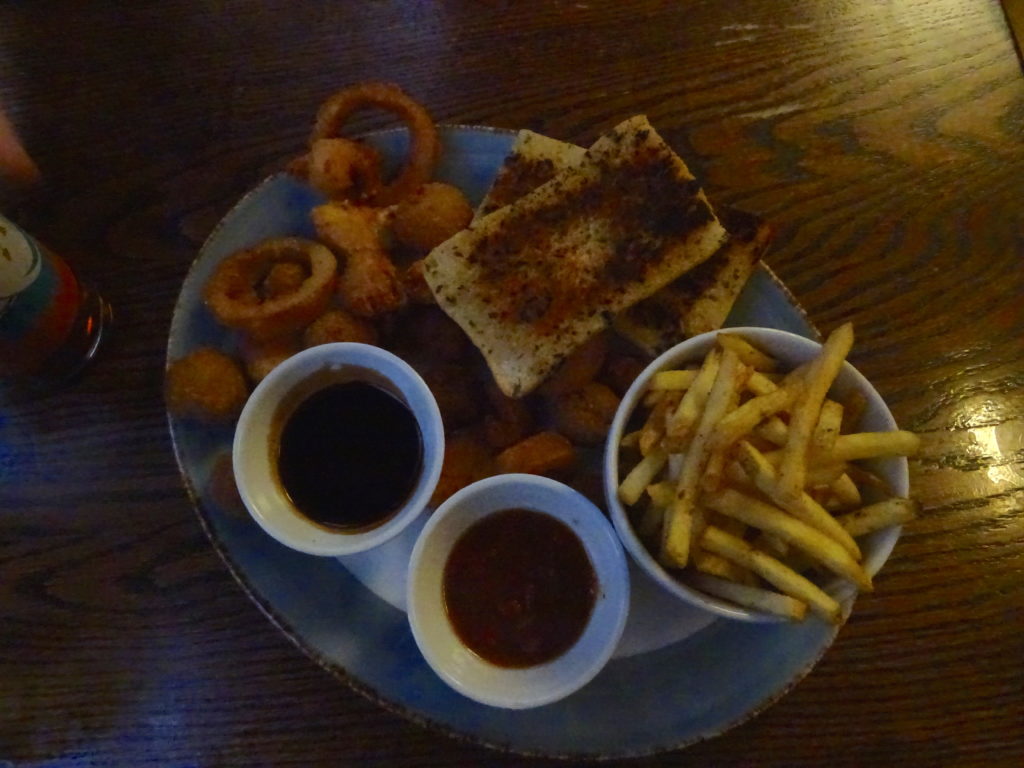
We Enjoyed The Sharing Platter
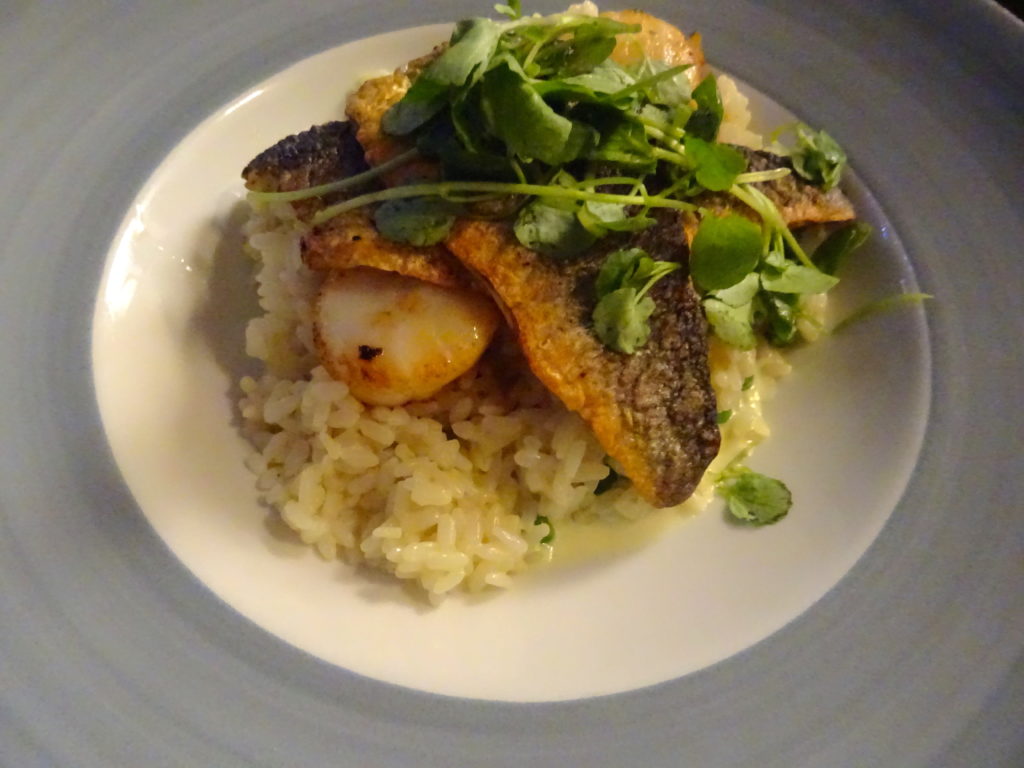
Seabass And Scallop Risotto At The Dirty Duck
A Couple More Pubs
After eating we decided to try a few of the pubs in Stratford, well, why not? Though we quickly realised that most of the pubs in Stratford-Upon-Avon are owned by Greene King. It’s quite weird for one chain to have such a monopoly, I wonder why this is… If you know, please let me know in the comments below.
Anyway, we ended up in the Garrick Inn (reviews are here), which is the oldest in the town. It apparently dates back to around 1400 (and is also a Greene King). And of course, we had to give the Old Thatch (click here for reviews) a go. Both pubs were quite quiet but cheap enough. You could tell it was a weekday in low season though!
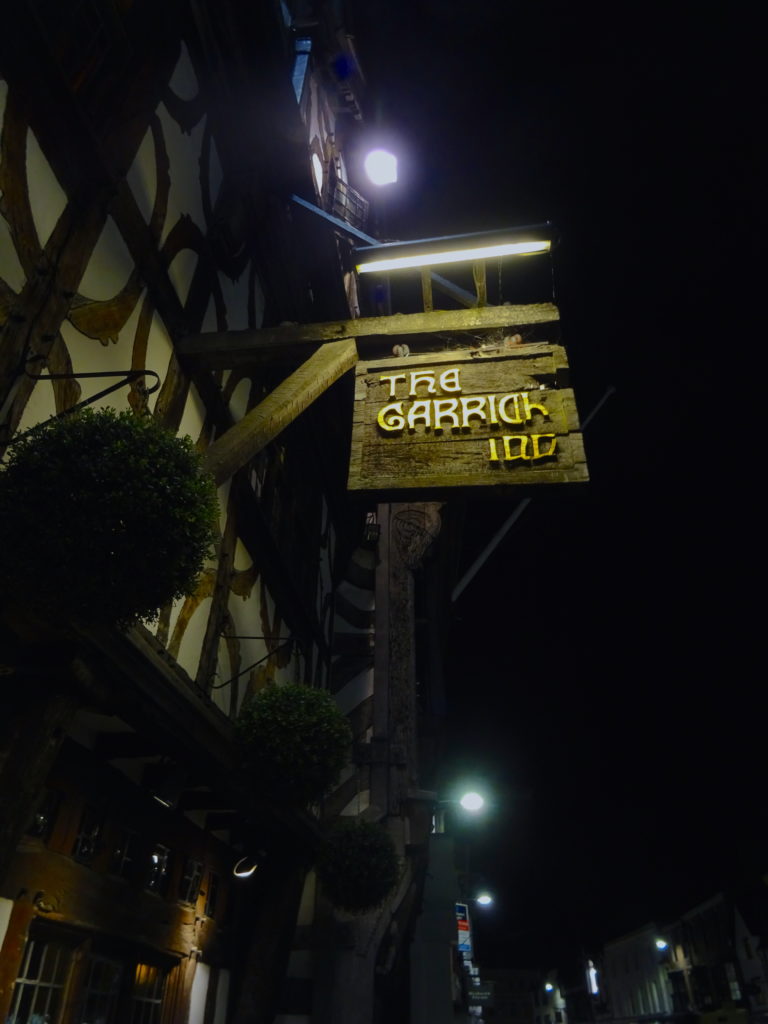
The Garrick In Is The Oldest Pub In Stratford
Walking To Anne Hathaway’s
Waking up the next morning, we were pleasantly surprised that our Airbnb host actually supplied breakfast! Just cereal, toast, tea and coffee, but we were very grateful. It’s always a nice surprise when you don’t have to worry about breakfast.
We had decided to head to Anne Hathaway’s Cottage for the morning. It is walkable from the town, so we were up early to get there early. We still had three of the houses left to do!
For the walk, we had two choices. We could either go along the road or take a slightly longer way and avoid the road. So we choose the latter.
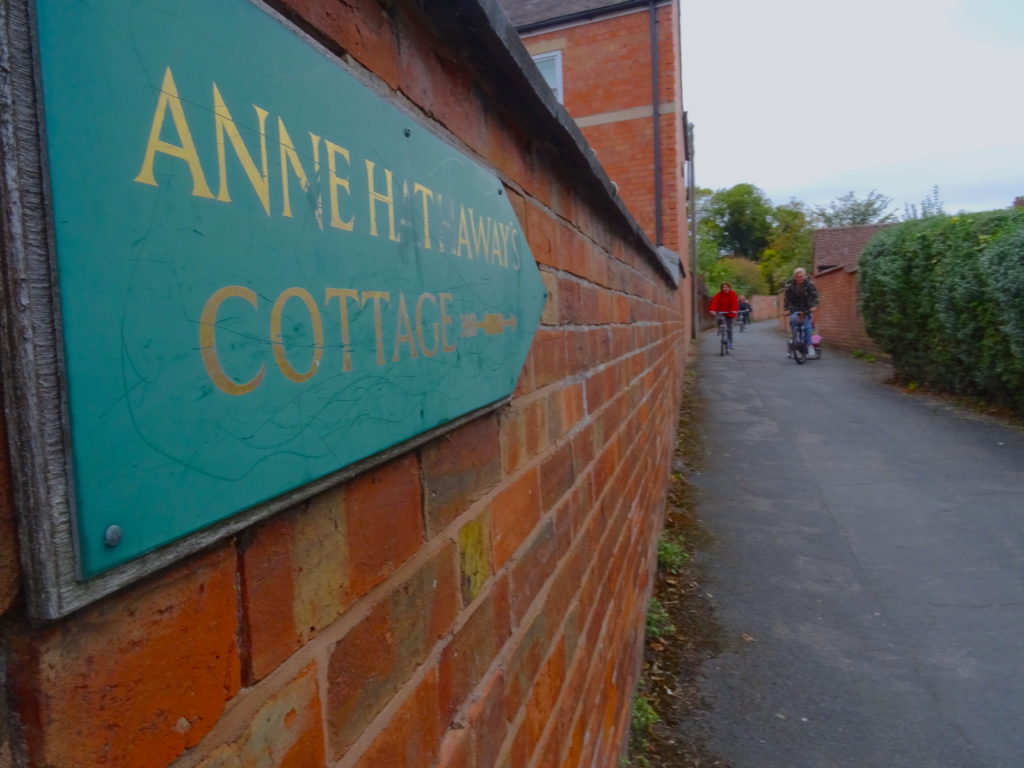
It’s Easy to Find The Path Leading Top Anne Hathaway’s Cottage
The start of the path is actually signposted, I was surprised to learn. It meant we didn’t miss the first turn like we normally do. Unfortunately, the walk wasn’t as pretty as I envisioned, but I guess it was prettier than the road. You go down some alleyways at the back of houses and through some parks. I think it really is just a way to stop hordes of people walking along the road. After the park, there were some pretty houses, but that was it for prettiness really.
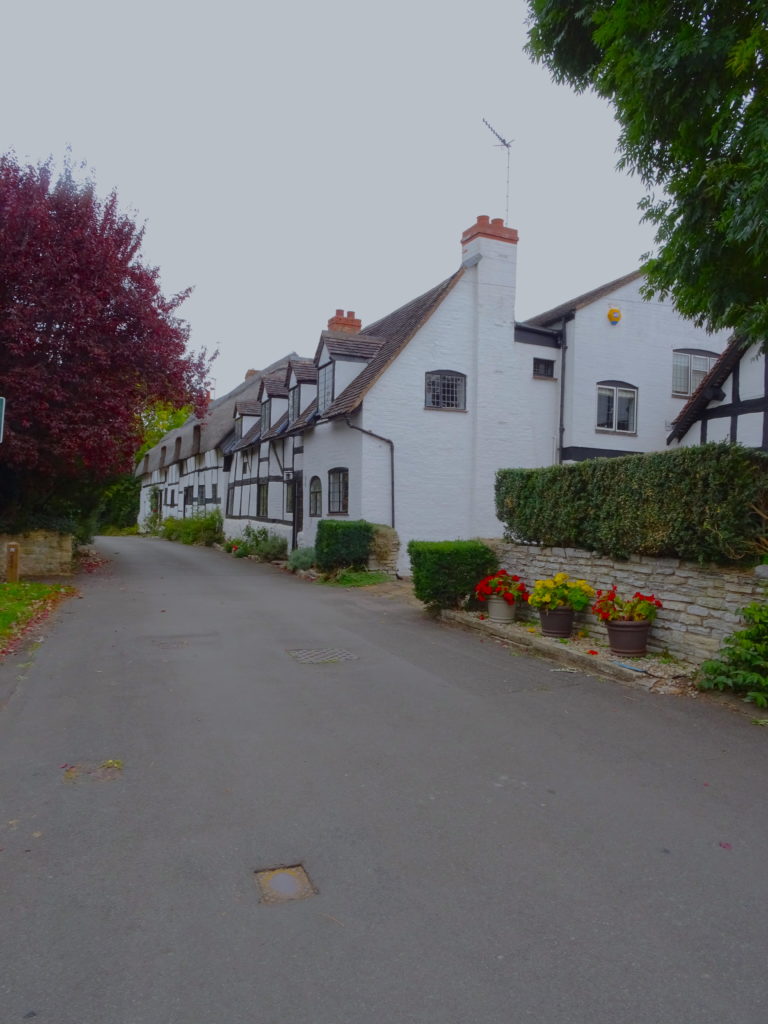
I Thought These Houses Were Cute, They’re Not Far From Anne Hathaway’s Cottage
If you want to do the walk, you can download a map from the Birthplace Trust. From our AirBnB it took about 30 minutes, so it really isn’t far.
Anne Hathaway’s Cottage
Once we arrived at Anne Hathaway’s Cottage (follow this link for reviews), it was fun to get in. You have to go all the way around the cottage to go in. Just a little confusing. So you go through the entrance, round the back, through a door at the back (they only let so many people through) then you are back around the front and have to go through another entrance to explore the house. Confusing, right? But don’t worry, it makes sense once you’re there. It also gives you the chance to explore the gardens first if the house is crowded.
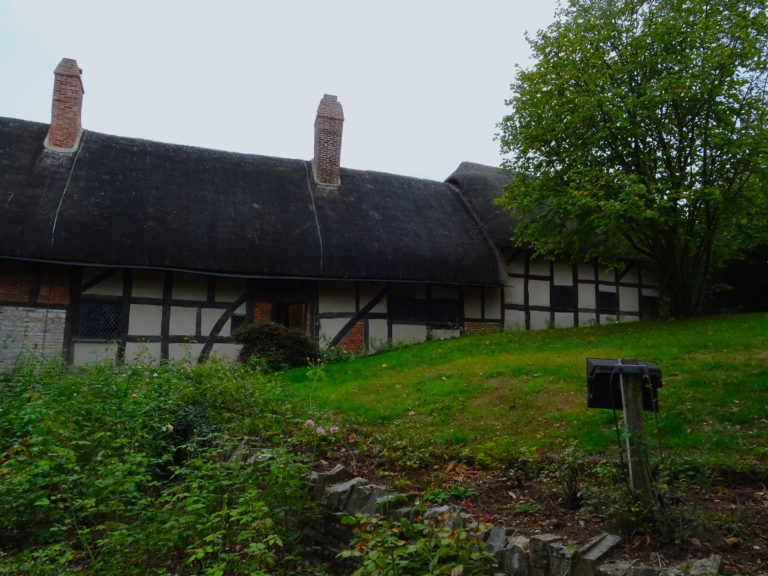
The Front Of Anne Hathaways Cottage – you Have To Go Round To Get In
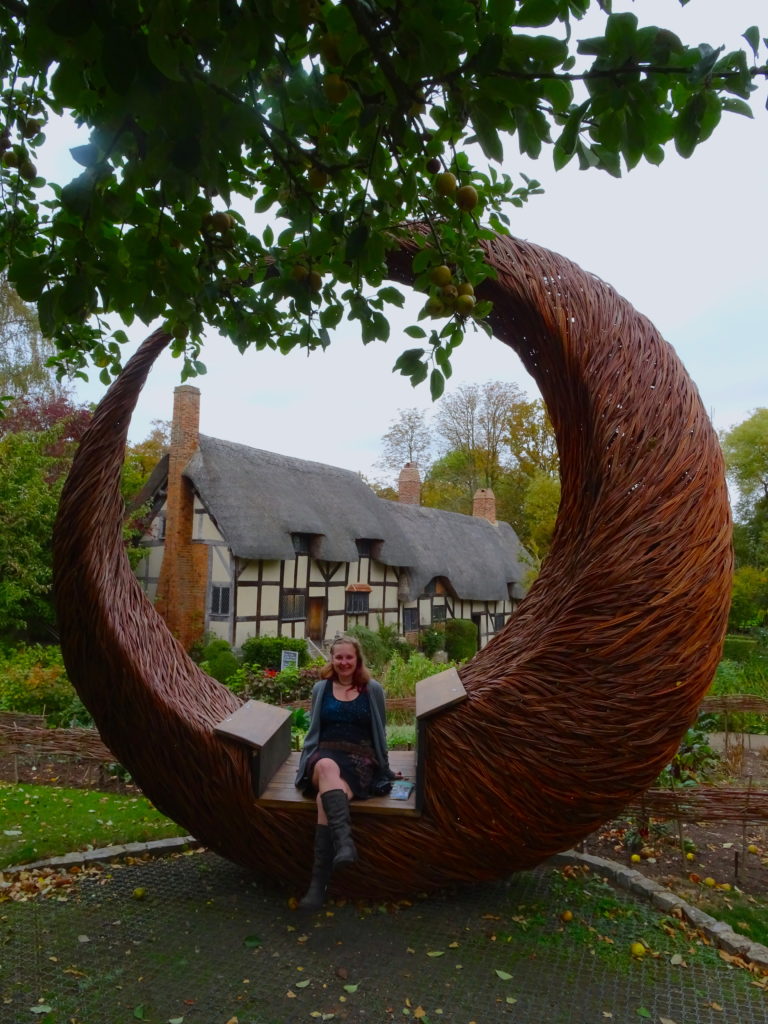
Ready To Explore Anne Hathaway’s Cottage
The house is actually much bigger than it used to be; it has been extended many times throughout the years. The door you go through at the front (to actually start exploring the house) is where the original front door was. This is actually where William Shakespeare would have picked up Anne for their wedding. There are herbs and a ‘hag stone’ hanging at this door, to ward off evil spirits.
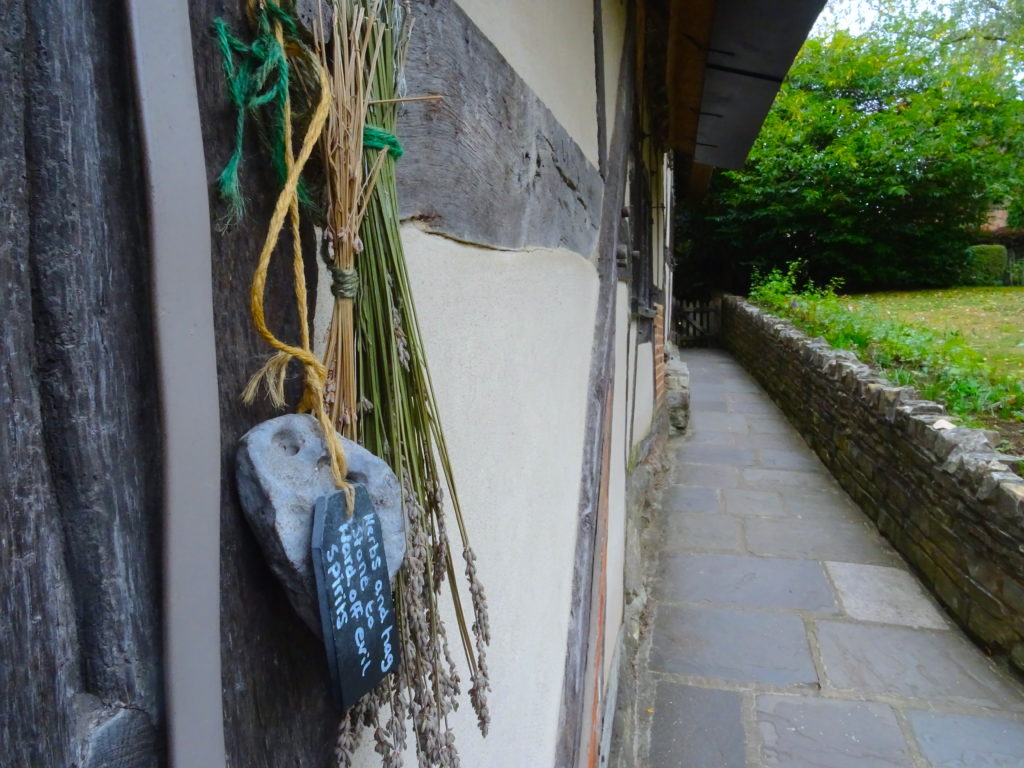
Herbs And A Hag Stone Ward Off Evil Spirits
As it was low season, we pretty much had the place to ourselves for the most of our exploration. We were able to explore at our leisure and talk to the staff. They had a lot to tell us about the history of the house and Anne Hathaway. Definitely make sure you have a chat with them!
Exploring Anne Hathaway’s Cottage
Once you’re finally inside the cottage after going round and round, the first room you enter is the kitchen. Here we had quite a long chat with the staff member – she was very happy to tell us anything and everything. One thing she did point out that I found very interesting was that the kitchen still has the original floor. That is one old floor!
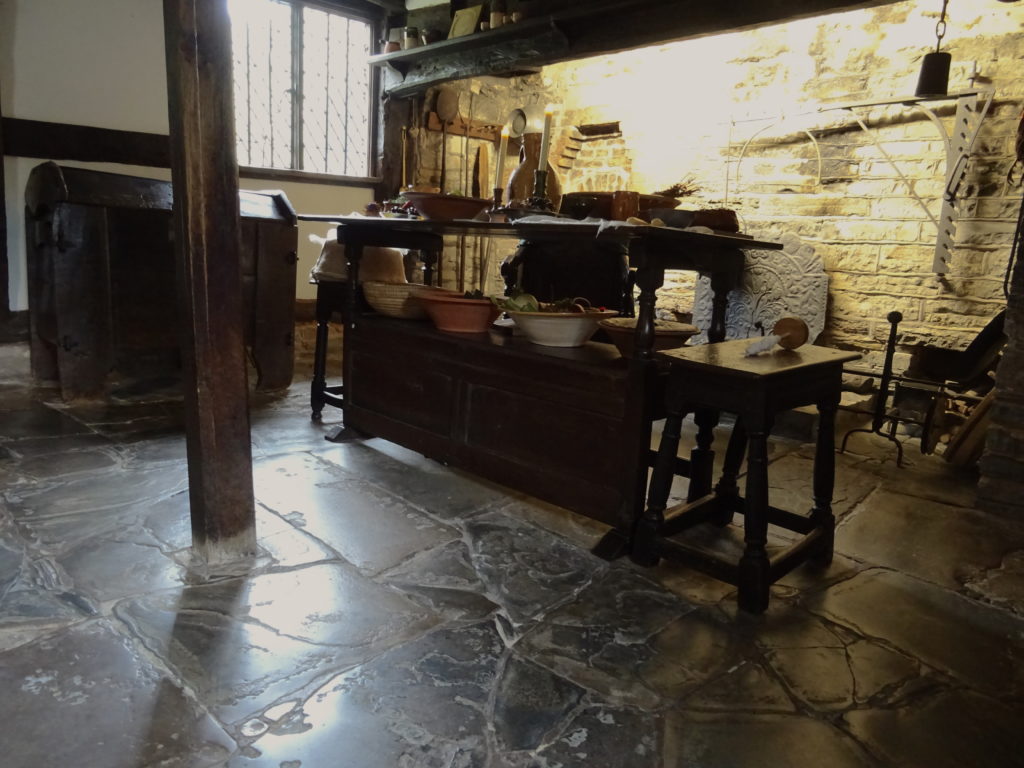
The Flooring Here Is Original, Now That’s Old!
As you go around the house you can find various bits and bobs of interest. There are lists of inventories, one of which has two beds on it. Now, back in the day, having more than one bed was a sign of wealth. There’s also a place that would have been used to smoke meat plus an old game that you can try your hand at.
One thing to look out for is an original bed from the 1500s; this was given to the Hathaway’s from Shakespeare’s granddaughter. Could this be the infamous “second-best bed” from Shakespeare’s will? Also not to be missed is the “courting chair”. Once again, this was given to the Hathaways from Shakespeare’s granddaughter. There are elements of the Shakespeare coat of arms in this chair, such as the shield with a spear and a falcon holding a spear.
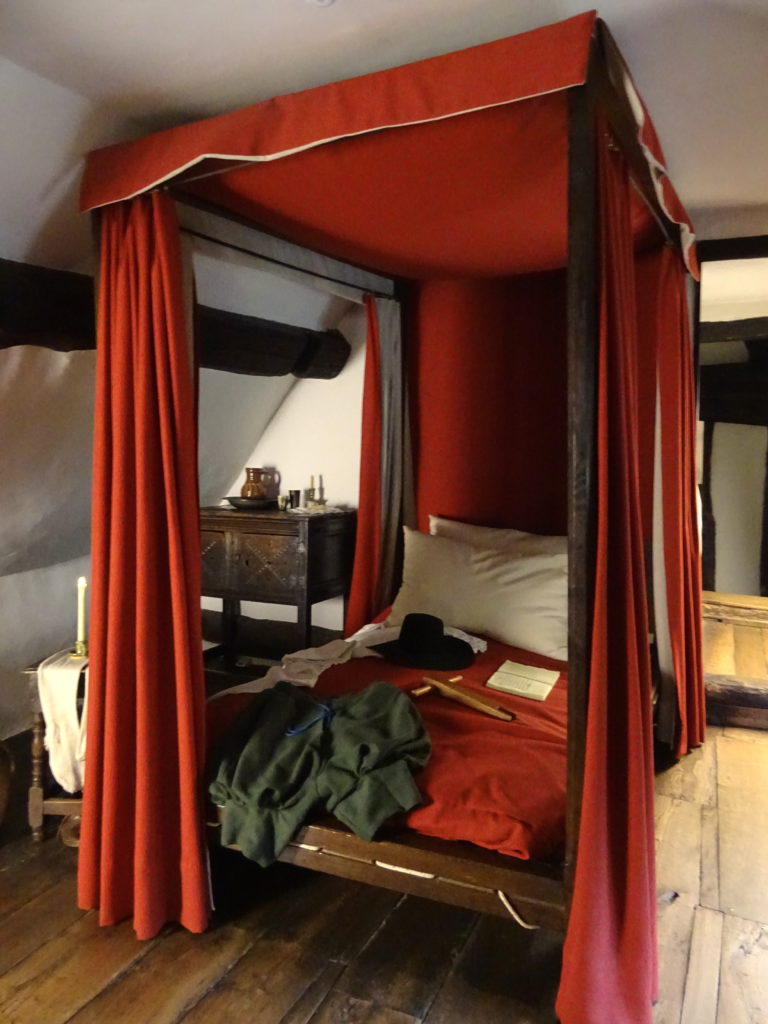
Could This Be The Infamous Second Best Bed?
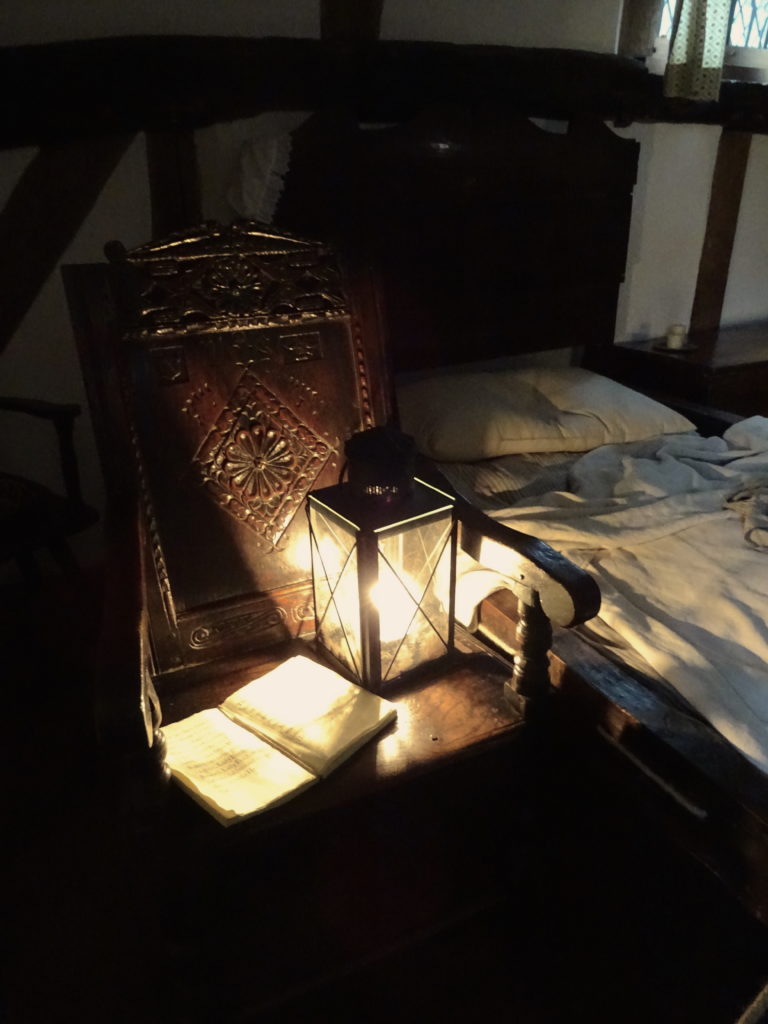
The Courting Chair
The Decline Of The Hathaways
By the 1800s, the Hathaways fortune started to decline. Therefore they started to mortgage some of their buildings and even sell some By 1838 the cottage itself was sold and the family remained as tenants. During this time the family still farmed the land and developed the garden.
The Trust bought the property in 1892 and descendants of the Hathaways were still living there. One of the last descendants was Mary Baker. Mary and her family were paid a wage as they cared for the cottage and told visitors stories. Currently there are no descendants living at the cottage.
During their time as tenants, the Hathaways still worked in and around the house. One of the things they did was to work on the gardens.
The garden in front of the cottage is known for its beauty. It was originally designed and planted by Ellen Willmott in the 1920s. Willmott was a renowned horticulturist at this time. However, as there are no original designs for the gardens, it has changed over the years. Luckily she did leave planting plans that show that she favoured pastel shades and flowers mentioned in Shakespeare’s plays. It was designed to stay colourful no matter the season. Currently, the Trust is researching what they can of the designs with the hope of returning these flower beds to their former glory.
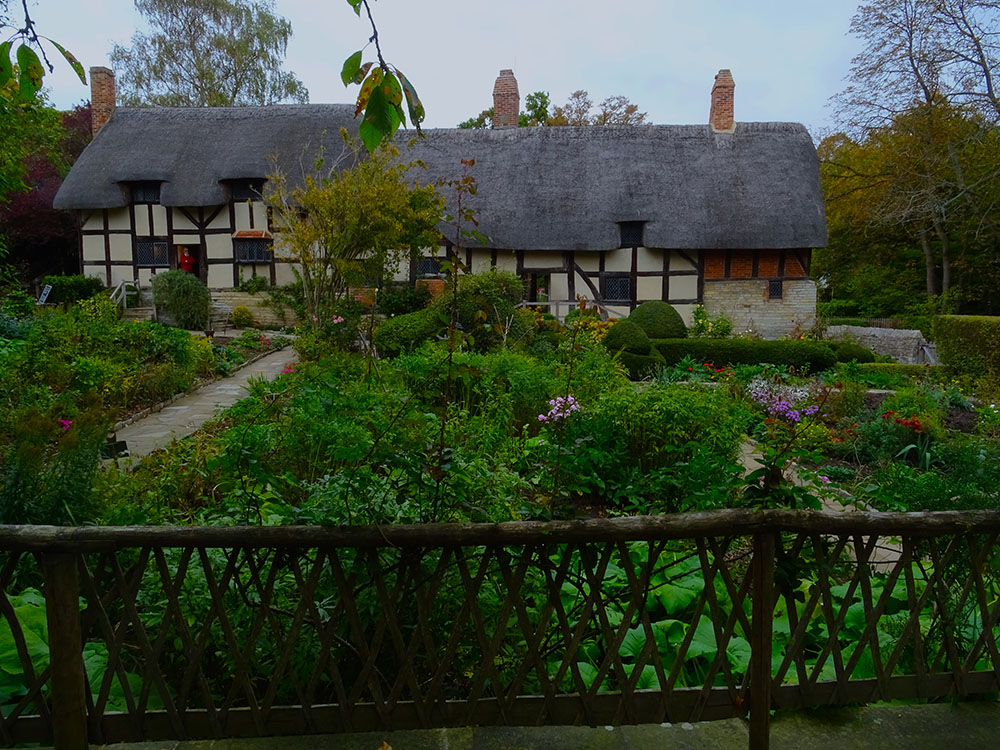
The Garden In Front Of The Cottage HAs Been Restored
Exhibitions In The Gardens
Once you’ve visited the house, you can explore the gardens at your leisure (or before) and that’s what we did next. The gardens were bigger than I expected, with plenty of features and exhibitions.
One exhibition I loved was the Romeo & Juliet feature (#giveascript), though I believe this was temporary. There was a walk through bit where you could hang up note. Your thoughts on the play or quotes. There were some really interesting thoughts, but some people really didn’t get it (the play and the exhibition).
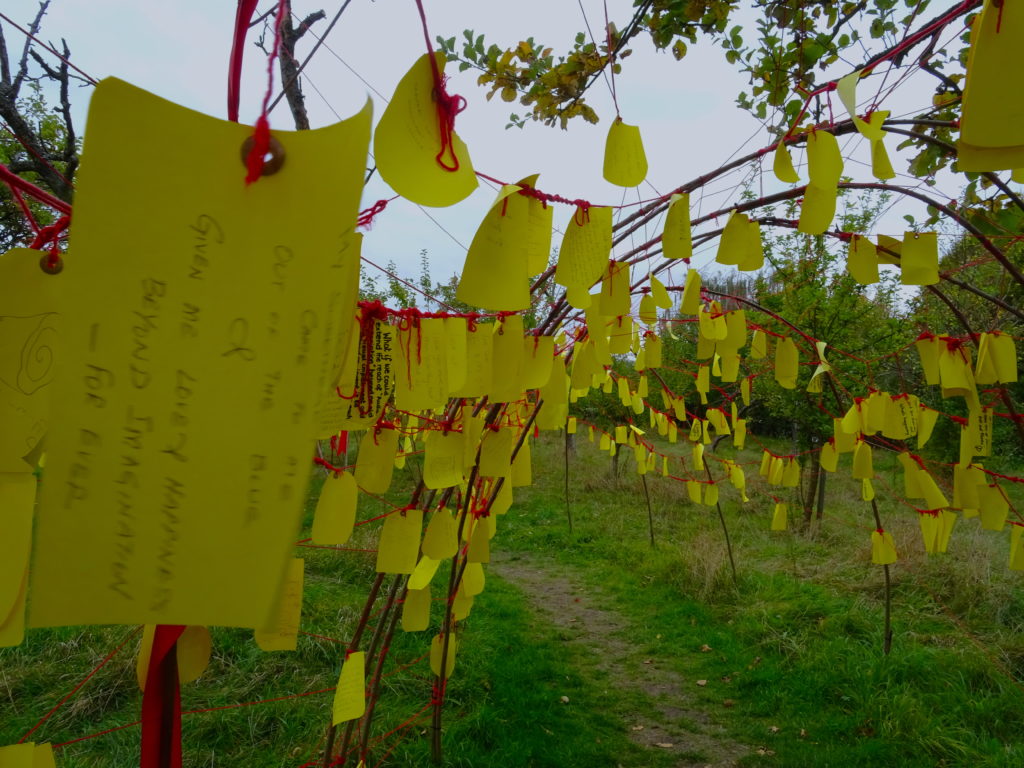
Give A Script Allowed Visitors To Leave Notes About Romeo And Juliet
With plenty of time to spare, we went to the Woodland Walk which, ironically, was shorter than I expected. Maybe I’m just crap at spacial awareness on maps. Anyway, it was a lovely little walk, with cheeky squirrels not far from the path. It was a quiet day, so, besides the squirrels, we had the place to ourselves. Near the end of the walk, we stumbled across a small stage with props and costumes. This was for kids to perform their own version of A Midsummer Night’s Dream. If only there were more people around I would have been well up for this!
Sculptures In The Gardens
From the woodland walk, I crossed the old orchard, with a look in at the beehives (unfortunately it was the wrong time of year for both of these), to the Tree Garden and Sculptures. It seems like the Shakespeare Birthplace Trust is a little obsessed with sculptures…
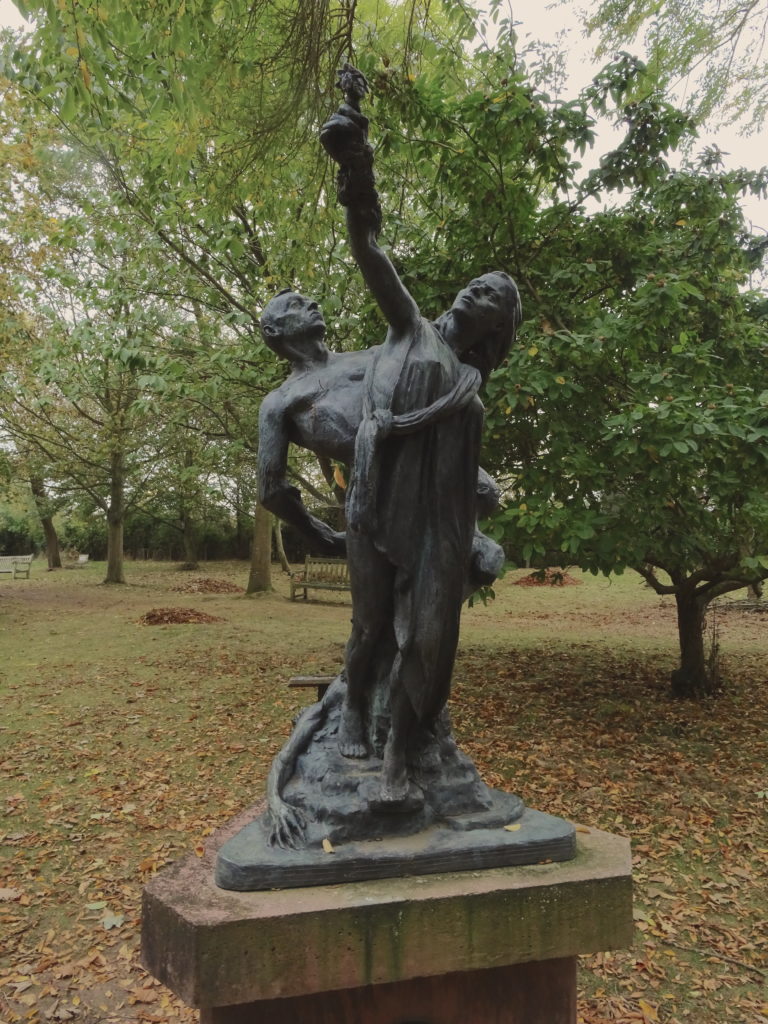
Sculptures In Gardens Seem To Be A Theme
I think this was my favourite part of the gardens and I don’t think many people explore this area. We didn’t see a single soul come anywhere near it. Although it was low season, I still expected one or two people wandering around.
In this garden, you can find 40 trees and other plants that are mentioned in Shakespeare’s plays. Each plant is labelled with a quote. You can find roses (obviously), hawthorn, hazel and more. I love gardens like this, with such a theme.
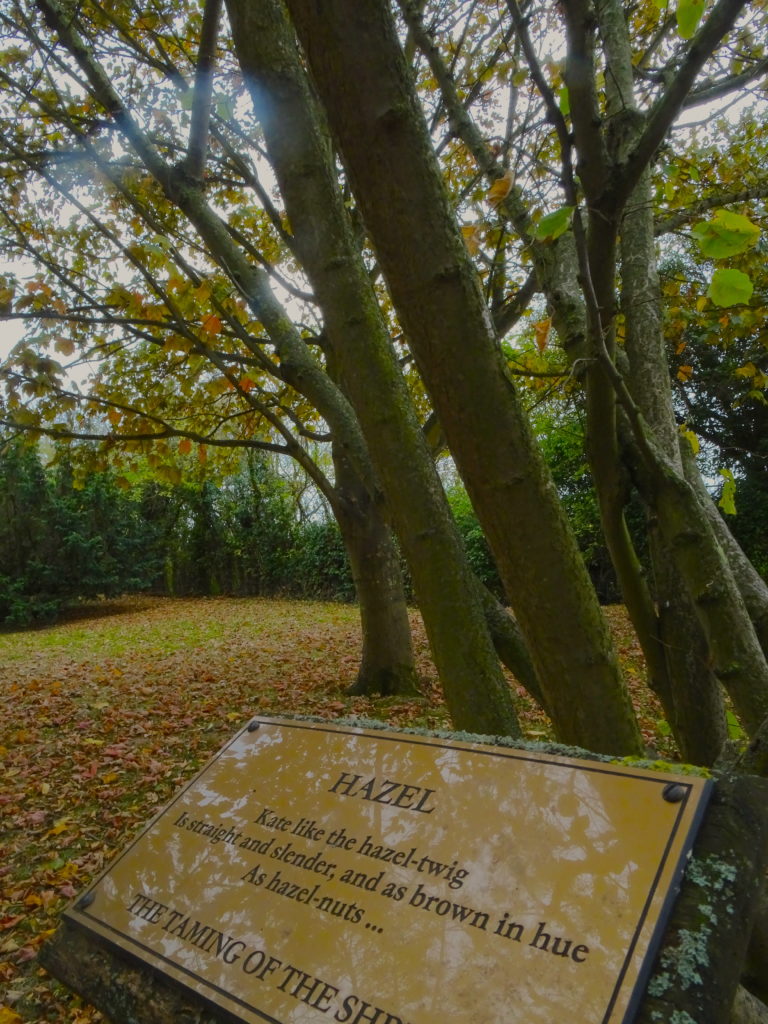
Shakespeare Mentions Many Plants, Such As Hazel, In His Plays
You can also find sculptures of Shakespeare’s plays here. These were created by art students. They’re pretty cool, though some are just a bit bizarre.
On To The Next House
As we had pretty much explored everywhere in Anne Hathaway’s Cottage and Gardens, we decided that it was time to move on to the next house. We had spent a few hours here and so time was of the essence, for this reason, we decided to walk back into Stratford along the road, as it is slightly quicker.
It was easy enough to find our way back along the road, except for the first turn where we got confused! But once on the right direction, we came back to the town near the Holy Trinity Church, which was perfect as the next house on the list was Hall’s Croft which isn’t far from here.
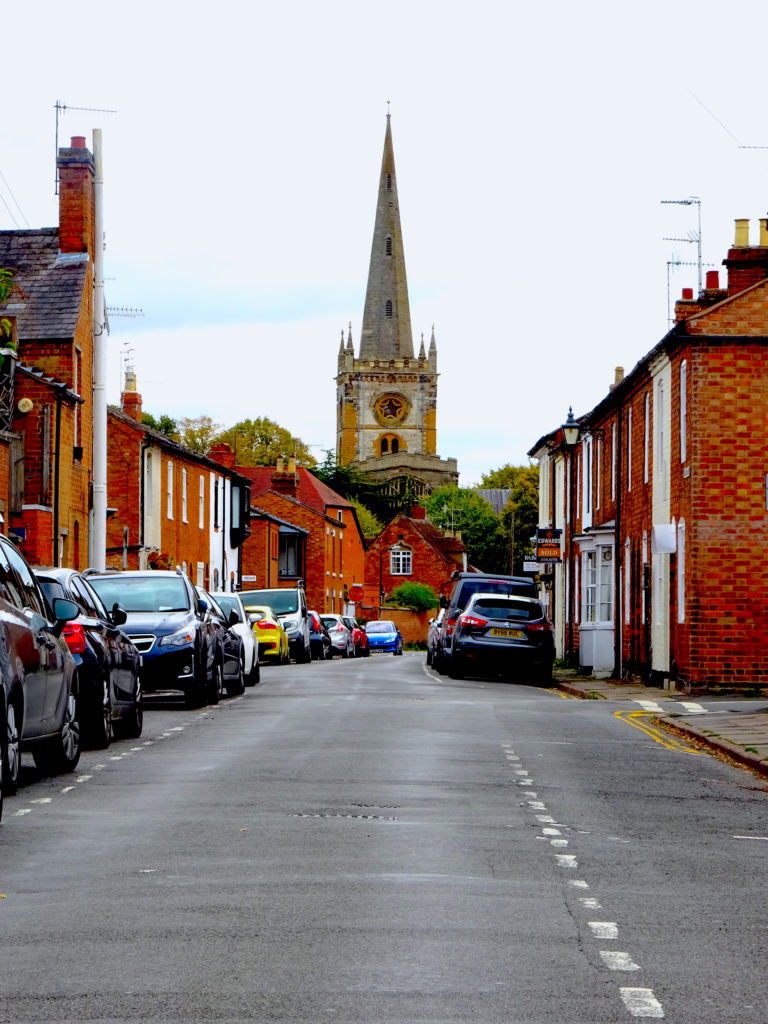
We Knew We Were Back In Stratford When The Holy Trinity Church Came Into View
Hall’s Croft
I think Hall’s Croft is one of the lesser-explored Shakespeare Houses, but it is well worth the time (for reviews click here). In fact, I think it was my favourite. The house belonged to Shakespeare’s daughter Susanna and her husband John Hall. The house has been refurbished into Jacobean style, probably the style when Susanna lived here. As John Hall was a doctor, you get to learn not only about Shakespeare and Jacobean life but also about the medicine of the day; something I’m always weirdly curious about.
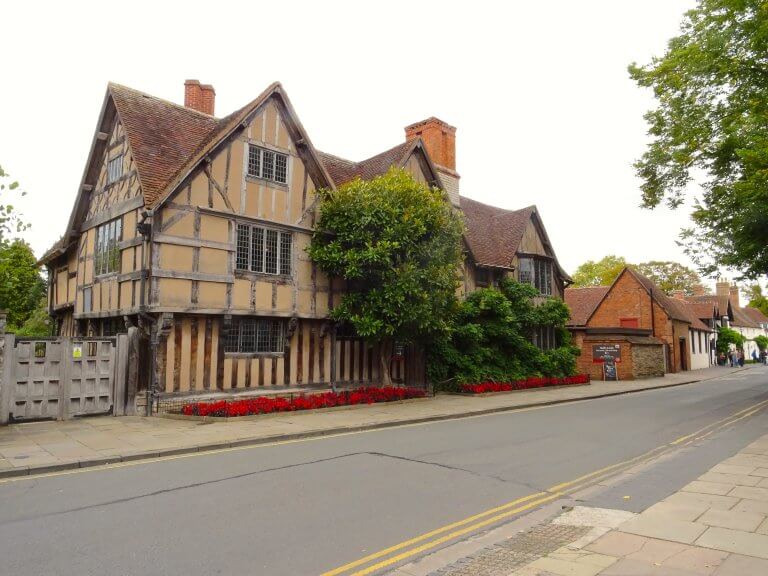
Halls Croft – Where Susanna And Her Husband Lived
After Susanna and her husband inherited New Place and so left this house to move there, the house saw a variety of changes. The Smith family bought Hall’s Croft and made a number of changes, such as adding a kitchen and a stable block. Then between 1850 – 1883 the House became Cambridge House, a school. It was a boys school twice and a ladies college once. It was taken over by the Birthplace Trust in 1949 and a lot of repair work began.
On entering the staff, as usual, were very happy to tell us anything and everything. They gave a great introduction to the cottage and gave us a load of sheets of paper with information as we walked around the house. There was also information on the pictures on display. All the portraits are of people that had connections with the Halls as there are no portraits of Susanna and John. Other paintings show what life would have been like in the cottage.
Life At Hall’s Croft
A lot of the rooms show how wealthy the Halls were when they lived at Hall’s Croft. The first room has a huge fireplace, for example. The room also has the original floor. Next comes the dining room, or parlour, which shows wealth just by being there. Many people in Jacobean England would not have had a dining room. This room is also where the original entrance was.
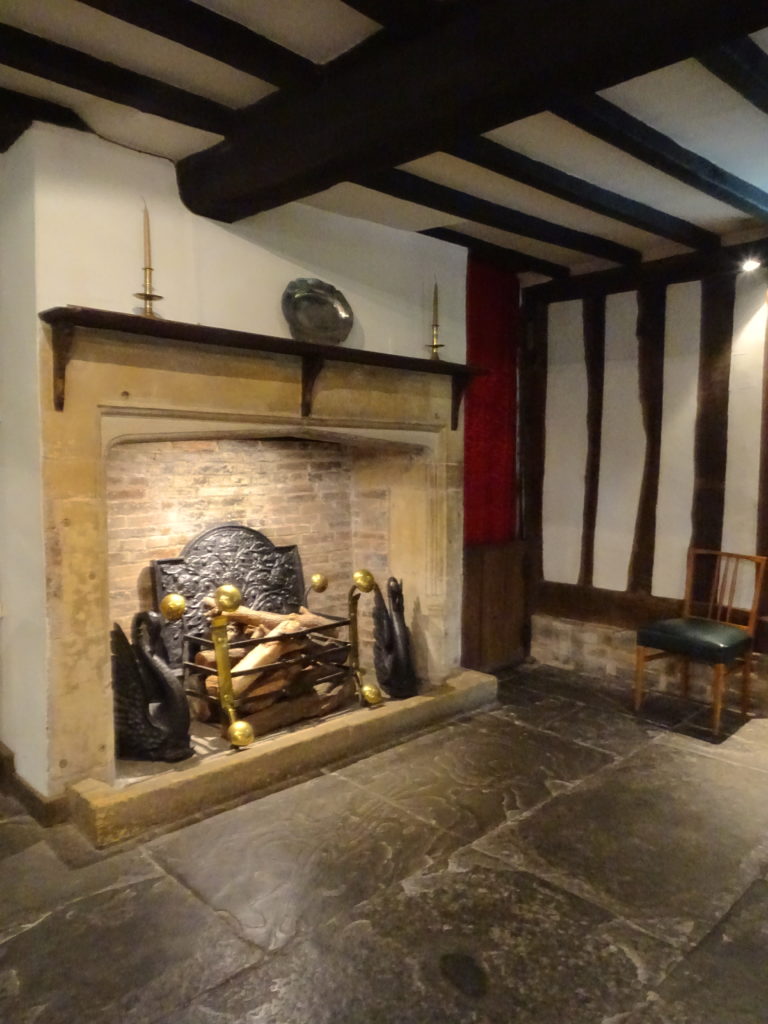
The Big Fireplace Would’ve Shown Wealth
There was also a dispensary room, which showed what John Hall would have used to treat patients. John was more into using herbs and natural substances to heal people, rather than bleeding them out and astrology. Physicians would have relationships with one or more apothecary, where they would buy the medicine needed. These apothecaries would know their regular’s prefered medicines and so keep the ingredients in stock.
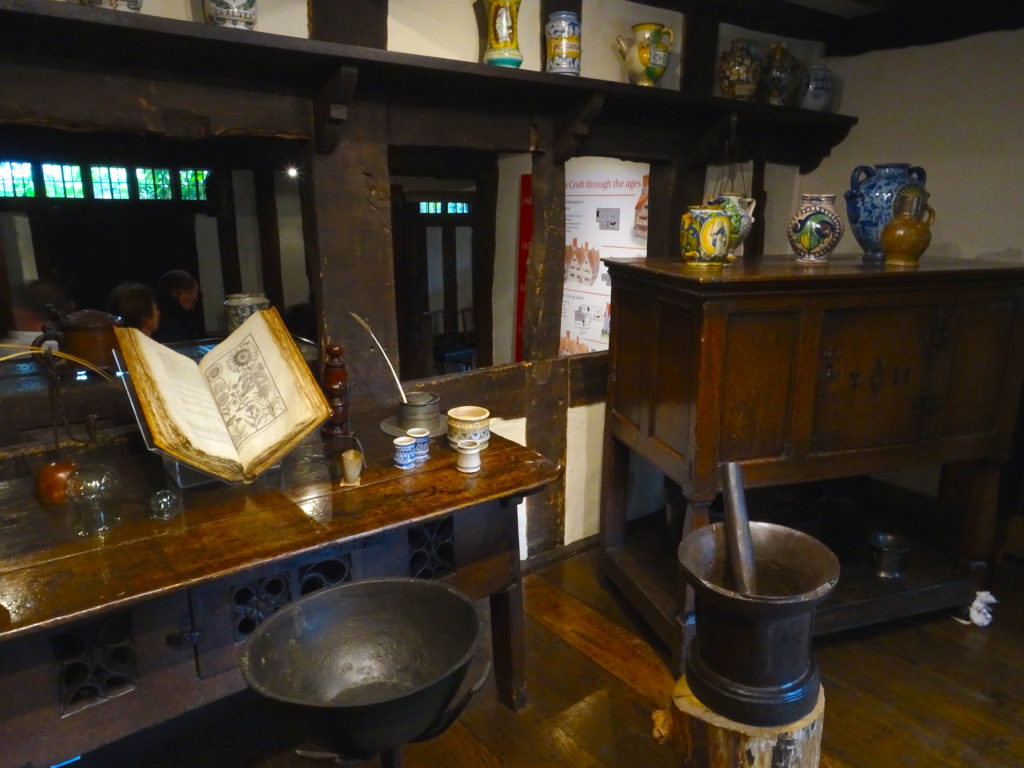
The Dispensary Room Containing Tudor Medicines
The kitchen that you see in Hall’s Croft was actually a later addition. It was built by the Smiths in 1630. One thing I found interesting here was the spit and smoke jack, this is from the 18th century, so another later development to the cottage. A dog could be used to turn the spit here, quite ingenious really.
Up the stairs was another Smith addition to Hall’s Croft, the bedroom. This is a barrel-vaulted room and is quite sizable. Like all the furniture in the house, none was owned by the Halls, but Jacobean furniture has been sourced where possible. The bed here is quite impressive and there is a display of Jacobean clothes.
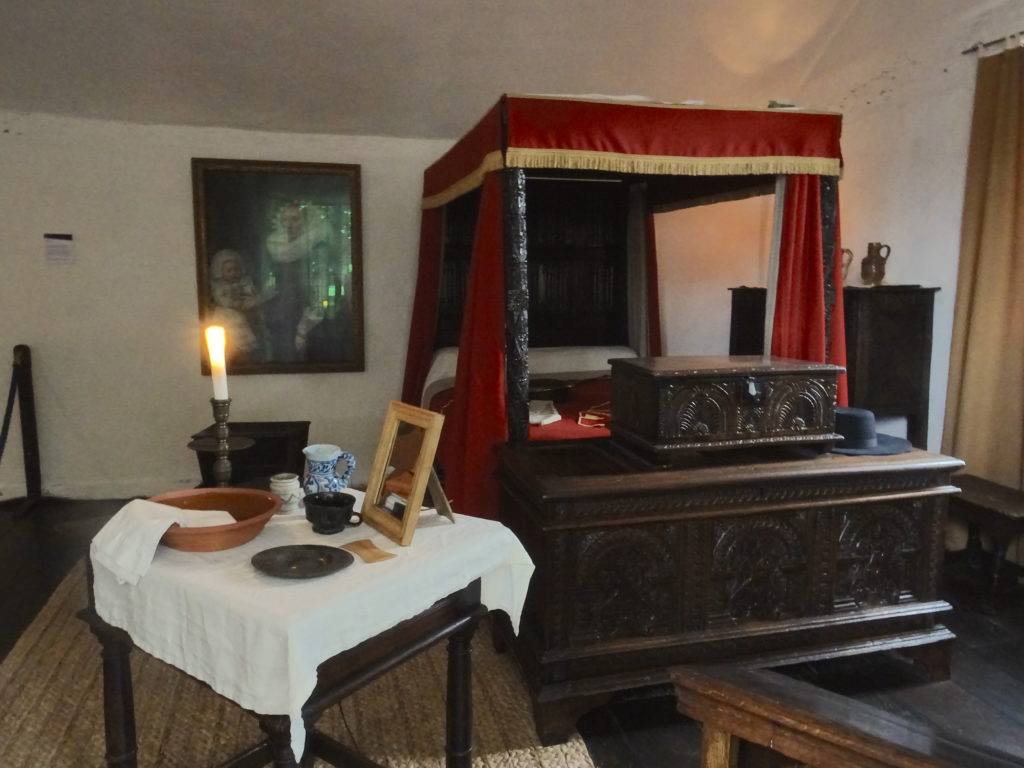
The Bedroom At Hall’s Croft
Medieval Medicine
Next was the exhibition room, which I thought was awesome. I have a weird thing with old medicine and healing.
The staff member here was very talkative and I think we spoke with her for at least half an hour. She used to be a teacher and actually taught Gemma Whelan (Kate in Upstart Crow, I’m keeping references relevant). Talk about a small world! She also told us that when doctors visit Hall’s Croft and look at the medieval cures they tend to have three reactions. The first is “That might actually work…”, the second “Oh My God! How could they even imagine that would work?!” and the last “We’ve actually started looking into that as a treatment.” I find the latter very amusing.
After having a good ol’ chin wag, we had a good look around the exhibition room, and I loved it. There’s a display of old surgical tools, which is more than a bit disturbing. You know when you look at things and read what they were used for and your brain just can’t piece the two things together? Yep, that happened.
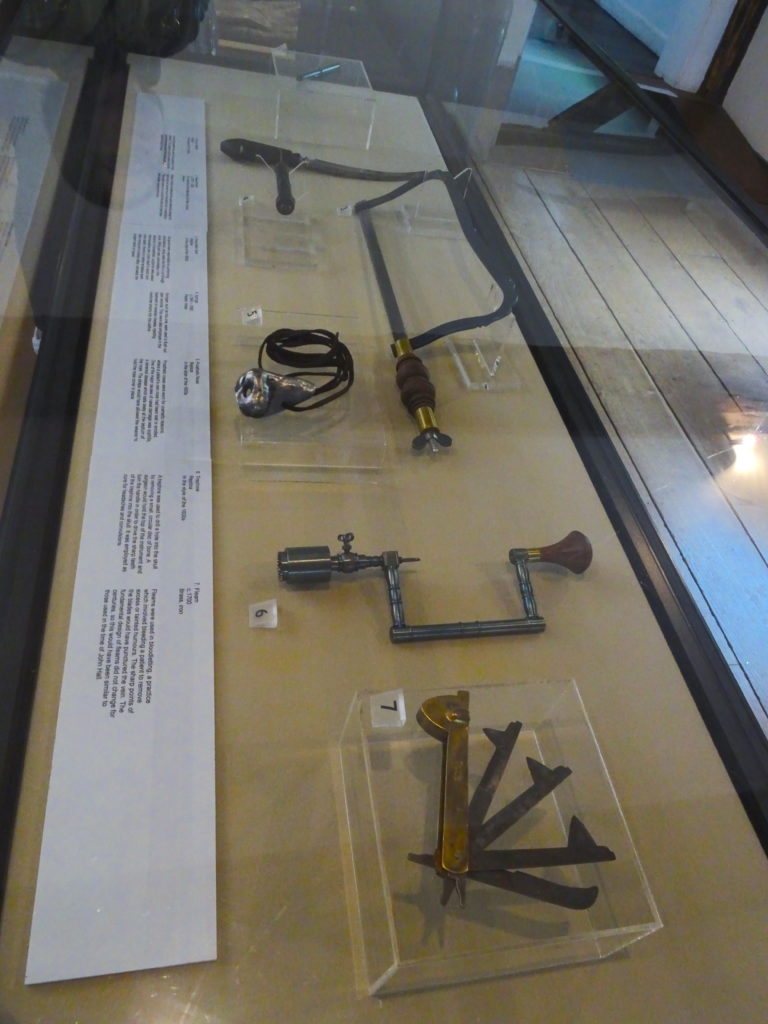
The Surgical Tools Are Just A Bit Disturbing
Humours And The Body
I found parts of this exhibition absolutely fascinating. In John Hall’s time, the human body was believed to be controlled by a collection of fluids called the “humours” (yellow, black, blood and phlegm). The balance of these humours affects physical and mental health. This theory was actually from ancient Greek and Roman medicine.
Illness was believed to come from an imbalance of the humours, or corruption. Climate, movements of the planets and emotional upset could affect the humours. Therefore treatment would focus on readdressing this balance and returning them to a normal state.
Medicines were designed to remove corrupt or excess. And so would induce vomiting, sweating and bowel movement (depending on what needed removing). This was a physicians job. Medicines would include plant, animal and inorganic matter, such as semi-precious stones. Surgeons were instead concerned with the surface of the body and so dealt with fractures, amputations, ulcers, cataracts etc.
Other Parts Of Tudor Medicine
Astrology was also used to interpret the body, as different constellations were thought to rule various parts. And, obviously, Religion was central to understanding. The body was thought to be a ‘microcosm’, a miniature, of the ‘macrocosm’, the whole universe.
If a physician wasn’t around, a clergyman could treat illnesses. This would be via getting the patient to repent and offer prayers, hoping that God would cure them.
There was also a Uroscopy station set up, which was interesting. Here there was ‘wee’ (I have no idea what it actually was, but I hope not actual wee) in glass bottles. The liquids were different colours, ranging from clear to an almost purple dark red. Uroscopy was looking at a patient’s urine to diagnose. The colour and surface would be examined by a physician. There was a nice handy chart with the vials so you could figure out what was wrong with each person. I suppose this does actually make sense, you can tell some things from urine even now.
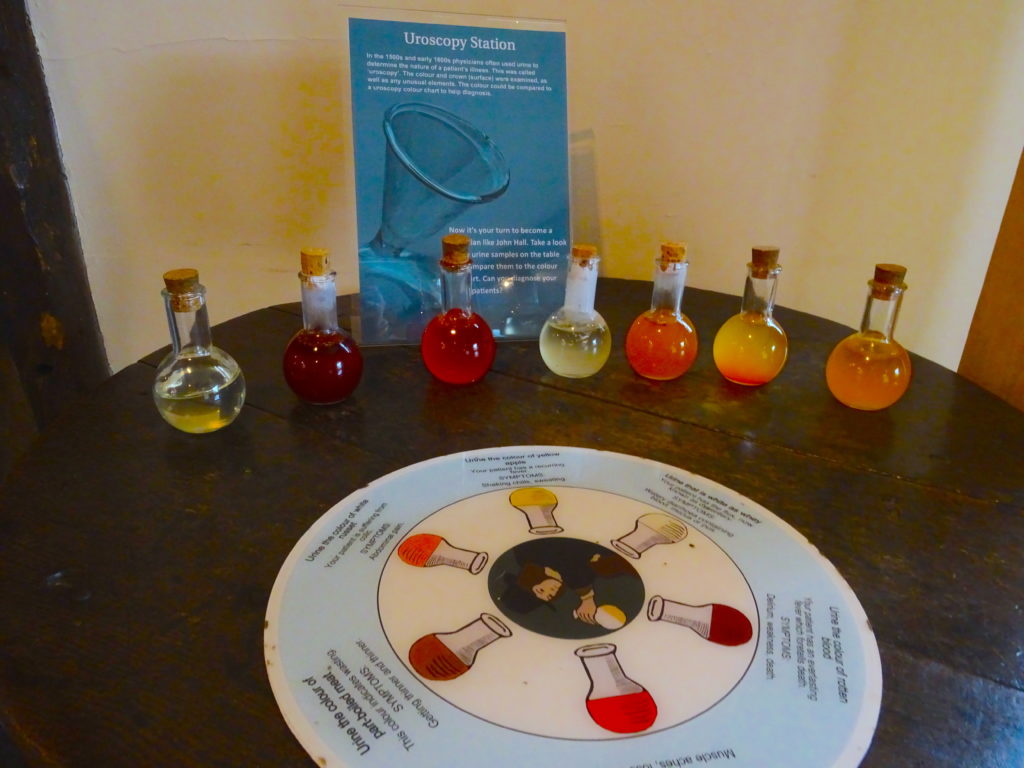
The Uroscopy Station Was Rather Interesting
Did you know, in the late 1500s and 1600s, the brian was recognised as the site of mental activity? Therefore it was seen as the “seat of the soul”. The soul itself was then divided into three sections: The Rational Soul (highest part, found in humans only, allowed men and women to understand the laws of God); The Sensible Soul (animals and humans have, which includes the five senses and ‘inward’ senses); The Vegetal Soul ( found in humans, plants and animals, for the basic functions of life).
Shakespeare And Medicine
Hope you enjoyed the history/medical lesson there! There’s a lot more to it though. If I’ve whetted your appetite you’ll just have to visit.
Anyway, this all links with William Shakespeare, as his plays are full of medicinal references. His characters often discuss such things as mental illness, humours, anatomy and more. It is a matter of debate as to how Shakespeare acquired his medical knowledge. He may have learnt it from his son-in-law, but also could have learnt through reading and discussions with friends and associates.
Shakespeare did seem to have a good relationship with John Hall, who was an executioner of Shakespeare’s will.
John Hall The Physician
Another part I found fascinating were the cures. There were cases from old notes which stated illness and cure. Case 104 was my favourite. This was the cure for established scurvy in an elderly man. The man showed various symptoms and his urine was (obviously) examined. John Hall prescribed a number of remedies, including a drink that contained watercress and scurvy grass. The man was, apparently, entirely cured. And to be fair, it is possible. Scurvy is caused by a Vitamin C deficiency and both watercress and scurvy grass are now known to be rich in Vitamin C. So it shows that old, medieval cures aren’t always crazy and to be sniffed at.
On the other hand, sometimes they are insane. Such as a cure John prescribed for a case of quinsy (an abscess in the throat after tonsilitis). For this John prescribed that the patient eat two swallow’s nest, complete with feathers and droppings.
John Hall was a very popular physician and well thought of. He considered himself advanced in his ability to diagnose scurvy. John Hall even recorded 178 of his medicinal cases, known as his “Little Book of Cures” (which is where I assume the above cases were from). The first volume was translated from Latin into English by James Cooke and given the title Select Observations on English Bodies. This was published in 1657.
A Complaint
Although John Hall was a good physician (so it seems), he still got complaints. A letter of complaint is on display. The complaint is basically about the fact that John was not able to make an appointment. John had been threatened with a fine if he kept missing council meetings. The letter says that the patient thinks that John has another patient and so is being fobbed off. But of course, it is still signed “your truly loving friend and servant”. People don’t change, do they? If they want to be seen now, they will be seen.
Out in the garden you can find medicinal herbs. There is also a mulberry tree, which is possibly linked to the one at New Place. I didn’t fully explore the gardens, as it was quite cold and we had been out for quite a while and so were starting to get hungry. Bit of a shame, but I plan to go back.
Once you leave the cottage, if you walk around towards town (not in the direction of the church) you can see a coat of arms above the doorway. This is a combination of the Shakespeare and Halls Coats of Arms. So you have a Shakespeare spear and three dogs of the Halls, I think.
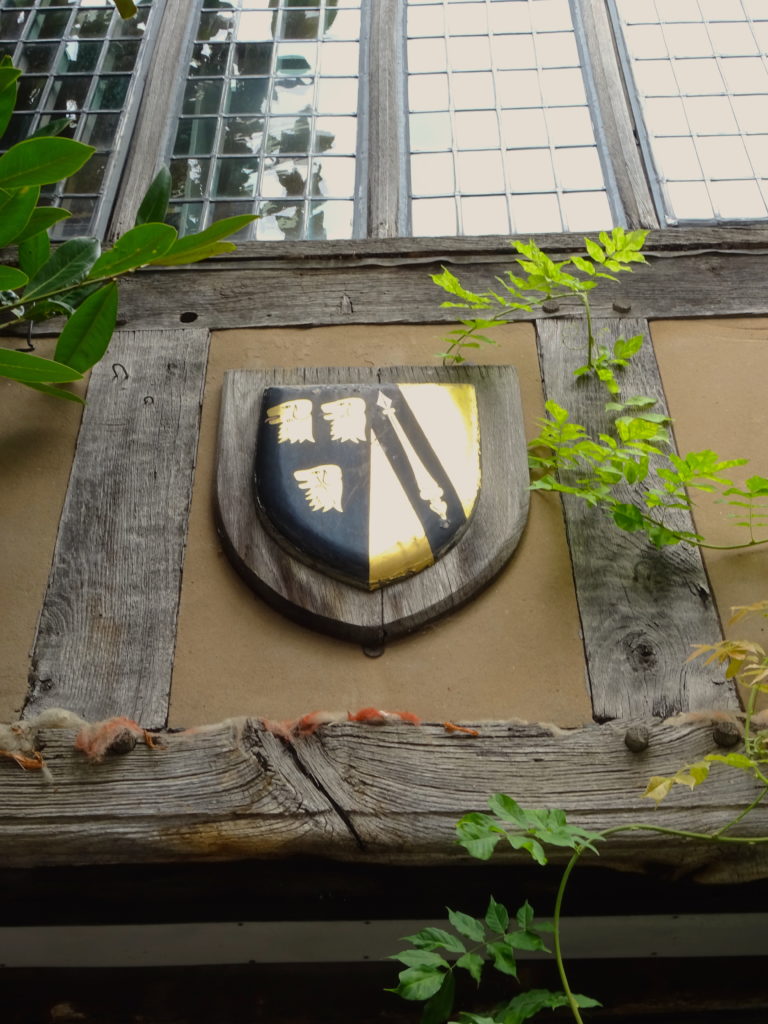
The Two Family’s Crests Are Combined
A Shakespearian Tearoom
By now it was definitely time for lunch. So we found Hathaway’s Tearooms (everything in this town seems to be named after some link to Shakespeare). We had a discount here from our tour so thought we’d take advantage.
It was a cute little cafe, with lots of cakes on display. We both had mushroom soup and some tea. The soup might have looked like a bowl of mud, but it was delicious. Very rich and earthy. I do wish we’d had time to go for afternoon tea here, maybe some other time…
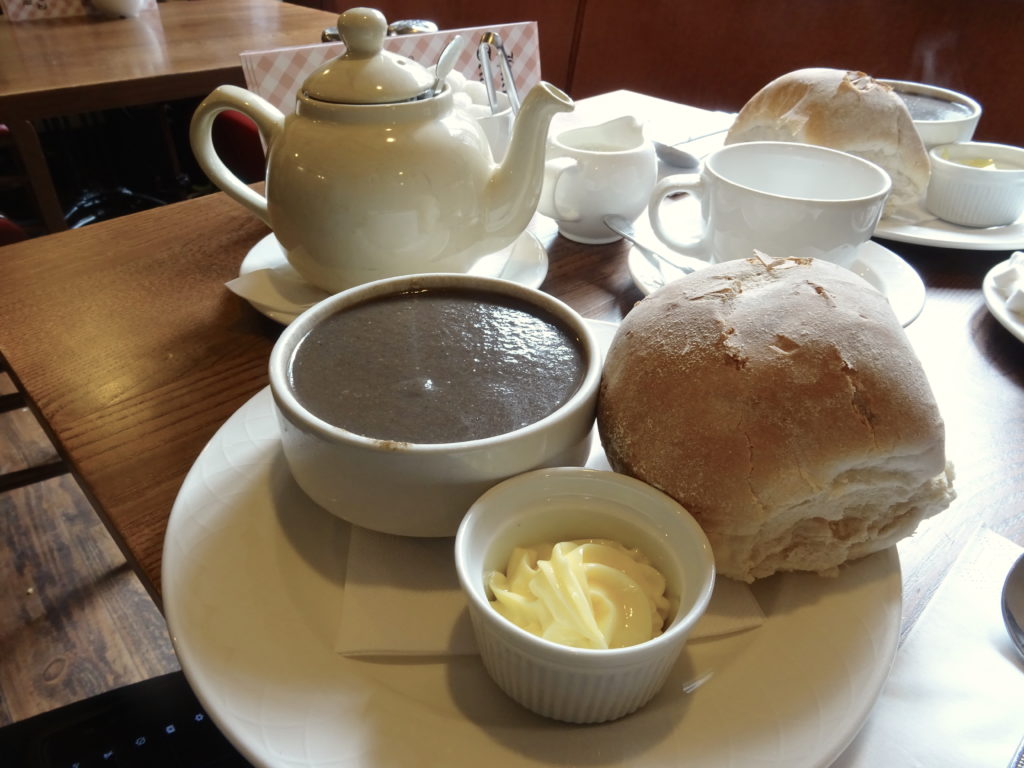
Soup And Tea At Hathaway’s Tearoom
We maybe stayed here longer than was needed, but it was just a nice place to be. Check out reviews for the tearoom here.
Using More Of The Discount Book
After lunch, we decided to take advantage of another discount in the book from the walking tour. We went to the Shakespeare Schoolroom and Guildhall. And I definitely recommend this, I had such good fun (check out what other people say here).
So we entered the Schoolroom and Guildhall with our discount and started looking around. You get a guided tour of the place, but first, we had to wait for others to join. There was loads of information here, but I didn’t get a chance to read it as the guy here was very talkative. Though at least he told us a few bits, as the tour would be guided I would have prefered some time to browse the signs myself.
The Guildhouse became the Town Hall in 1553 and the school was moved into the building in the 1560s. There was a lot of history here and a little model of Shakespeare, which was just a bit weird, to be honest.
John Shakespeare (William’s father) became a Bailiff here in 1568, which is essentially a town Mayor. Part of this job was to preview performances by travelling theatre troupes to ensure that the performances were suitable for the public. It is likely that William Shakespeare would have seen some performances as a child and it is even possible that he took part in the performances as an ‘extra.
But the good fortune didn’t last. In the late 1570s, John Shakespeare got into trouble with the authorities, which obviously damaged his reputation. So he had to resign from the Borough Council.
The Guildhall Tour
The tour finally started! Not that we had to wait long really. It starts with a video that tells you about the Guildhall and its history.
The next part was really cool. We were shown the remains of an old painting, it is hidden behind a screen. No pictures are allowed, due to its sensitive nature. These old paintings are rare medieval wall paintings. The painting shows Jesus being crucified, God above, the Virgin Mary and St John. It is thought that they were whitewashed during the Reformation. Now only fragments remain, you can see the image better on the wood than the walls, as wood holds the paint better.
Up To The Schoolroom
As we walked up the stairs, there was information on the old schoolmasters. Two of the masters that taught William Shakespeare were Simon Hunt and Thomas Jenkins. It is believed by some scholars that Jenkins was Welsh and that he was the inspiration for the Welsh teach Sir Hugh Evans in “The Merry Wives of Windsor”.
The first room upstairs was the Master’s Chamber, this was where the school’s only teacher lived. In the 19th century, this room became the Prefect’s Common Room. Many of the boys carved their initials on the table, which can be seen today. There are a lot of carvings on this table.
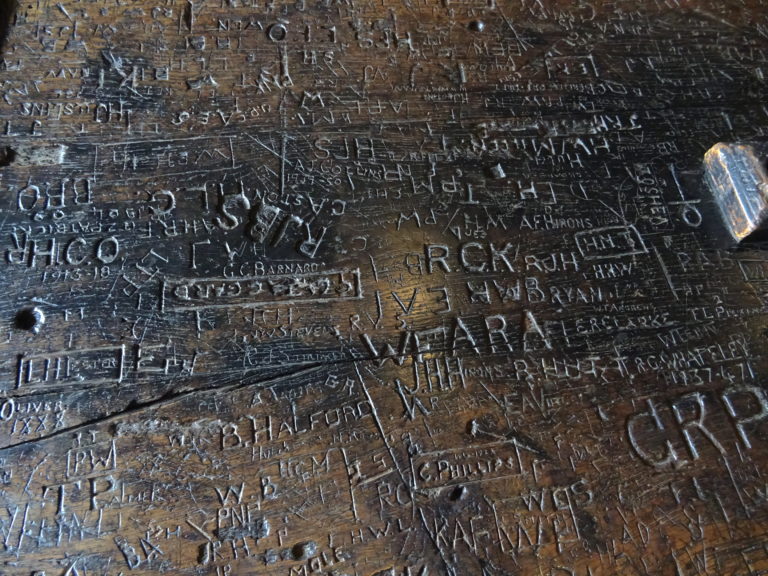
The Table Was Covered In Carvings
If you visit, be sure to look at the Tudor Roses on the walls. These may be the oldest surviving Tudor Roses in Britain. The roses painted showed Stratford’s loyalty to the crown and the power given to the Borough Council.
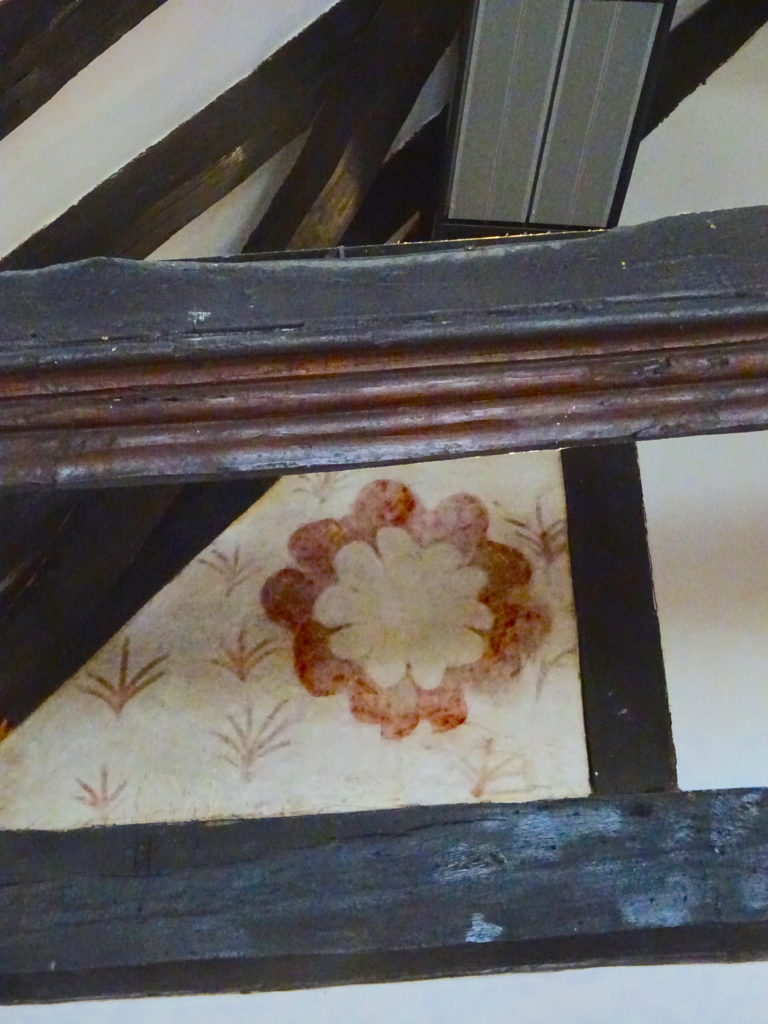
Tudor Rose In the Prefect’s Room

Tudor Roses Showed Loyalty To The Crown
Lessons With The Schoolmaster
Entering the next room, where we started my favourite part of the tour. We had actual lessons!
First, we were scolded by the master for being late, as classes start at 6 am. So to be fair, we were VERY late.
For our first lesson, we learnt some Latin. We were taught basic pronunciation and parts of the body. It was really fun to join in. We were also taught about Latin stories, such as the one that Romeo & Juliet was based on. The lesson went on for a fair while, I was having so much fun though, I would have been happy for it to be longer.
Our next lesson was Calligraphy (or as I like to call it, pretty writing). We were each given a quill and ink, then we were given a piece of paper with Shakespeare’s signature. We could either try to copy the signature or write our own name. I tried to copy the signature, and I was rather proud of my efforts (though Dave did better). So much fun!
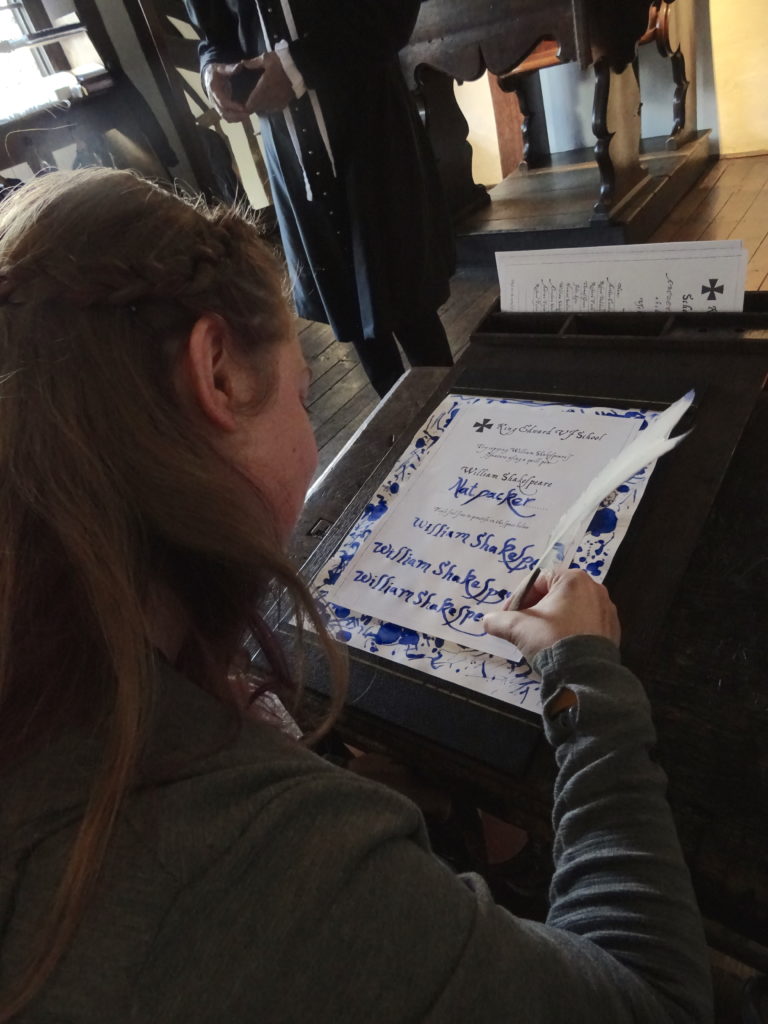
I Really Enjoyed The Calligraphy Class
After class, me and Dave ended up talking to the Schoolmaster for a bit. He had asked us about our plans and so we got talking about Tamburlaine which we were going to see that night.
On the way out, there is a bit more information to glean. For example, the importance of drama during Shakespeare’s school days. Pupils would have performed plays in both Latin and English. Be sure to also look out for the Coats of Arms on the walls.
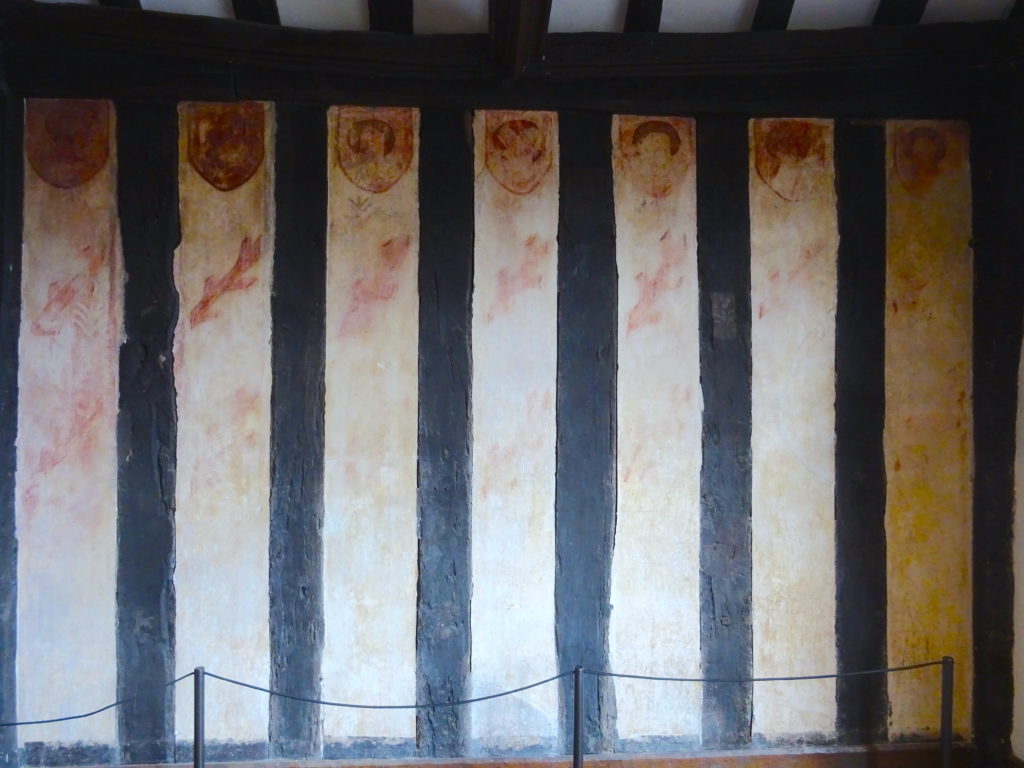
Coats Of Arms On The Wall
An Interlude
After our tour, we had a bit of time to go back to the first room (entrance and exit were here), so I did manage to have a bit of a read of the signs and a walk around. But we didn’t really have a chance to stay long, as the next tour was coming through. There was a lot of signage, it seems a bit pointless having it all if you don’t get the chance to read it.
It was now late afternoon and many things were closing up. We had seen all the Shakespeare houses in the town, and they were all starting to wind down. There was a bit of time before the play that we had booked, so we had a few hours to chill. Stratford town is pretty enough to just wander around, so with some spare time, it’s a good thing to do. We had a closer look at some of the statues, kept an eye out for bizarre things written on the floor and tried to get lost (not overly possible in this small town).
After our chill time, (we even went back to our Airbnb for a cuppa tea – how English are we?) It was soon time to head out into the night. We noticed that Edward Moon (see reviews here) did a pre-theatre menu, so obviously headed there before the theatre. I mean, it just makes sense, right?
Pre-Theatre Food
It was a nice little place (almost felt a bit posh for us). Lit with candlelight, it was cosy. The staff were lovely too. We’d gotten there quite early, so we had the place to ourselves for a bit, just a little awkward! The pre-theatre menu wasn’t extensive, but there were enough options there. We chose to have a starter and a main, it was a good choice.
I had oven-baked filled mushrooms to start and then pea and asparagus tagliatelle for main. Dave had a goats cheese and beetroot salad for starter, his main was a cauliflower tart. It was all as good as it looked and better. So delicious.
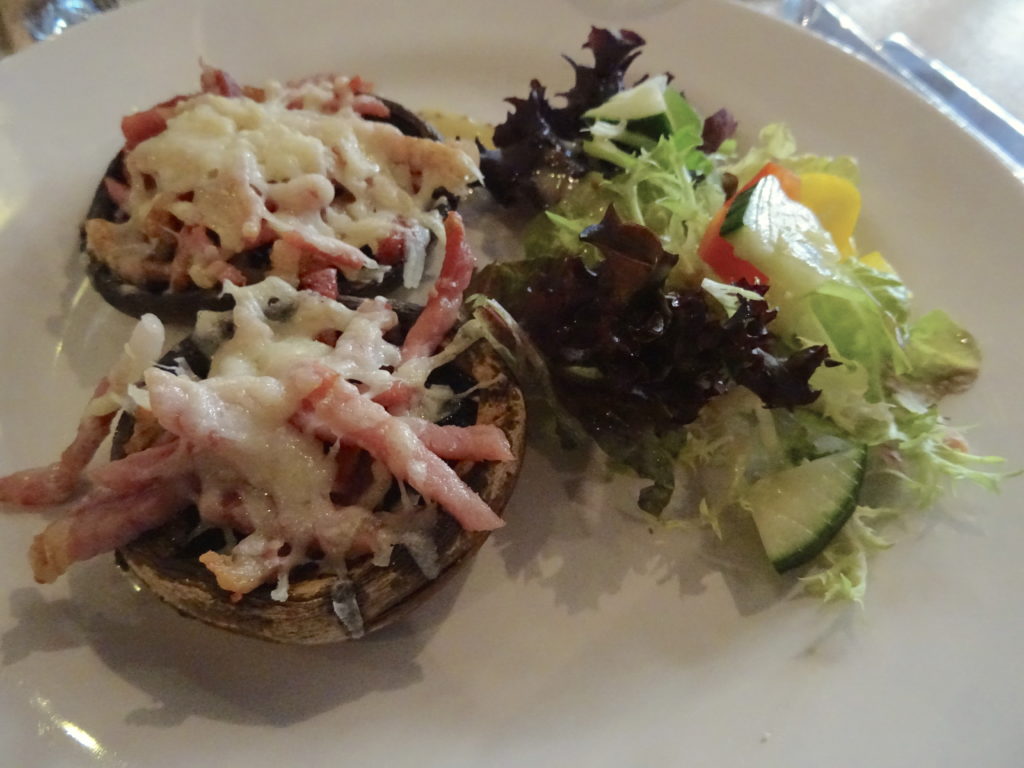
My Mushroom Starter
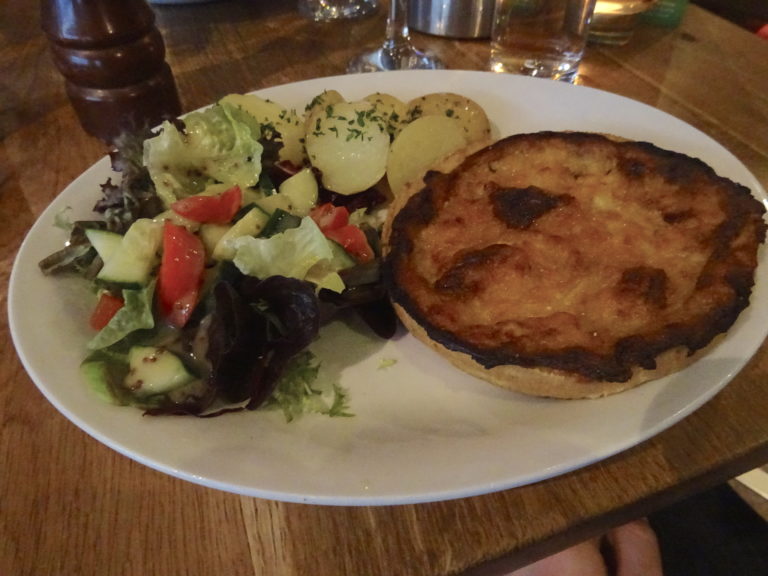
Dave’s Cauliflower Tart
A Bit Of Kit Marlowe
After eating it was a short walk to the RSC Swan Theatre (check out reviews by clicking this link) where we had tickets to see Tamburlaine. We had a bit of time before the show started, so had a bit of a look around, there’s an awesome bit of artwork about the Royal Shakespeare Company, and the bard himself.
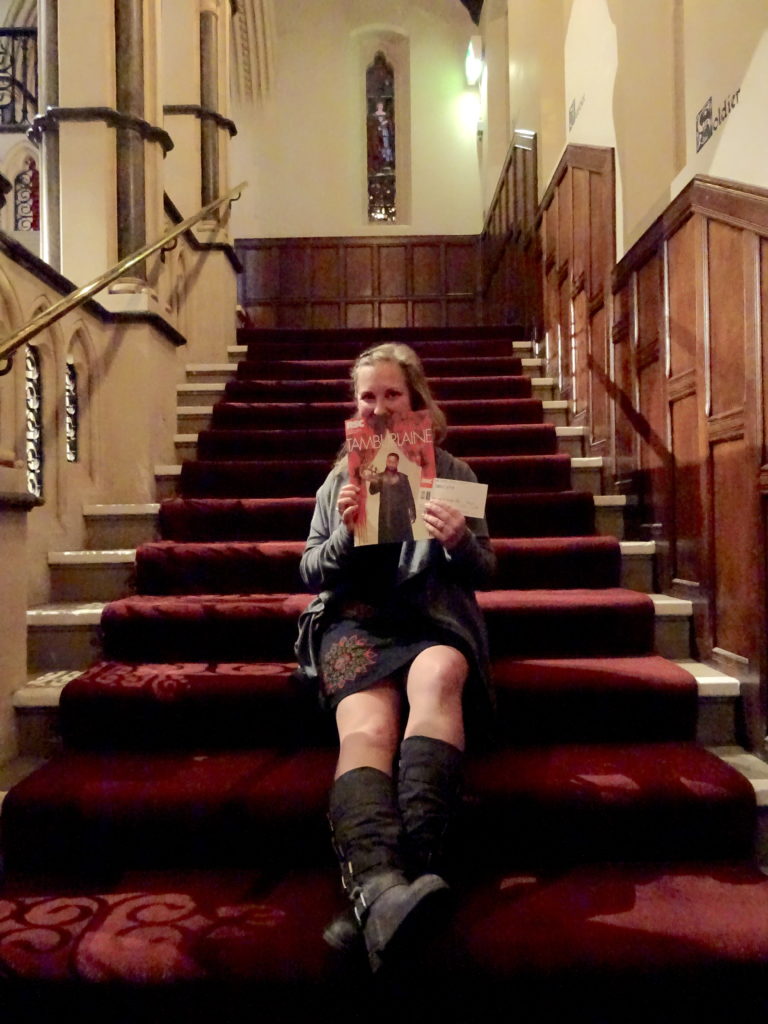
Excited To See Tamburlaine
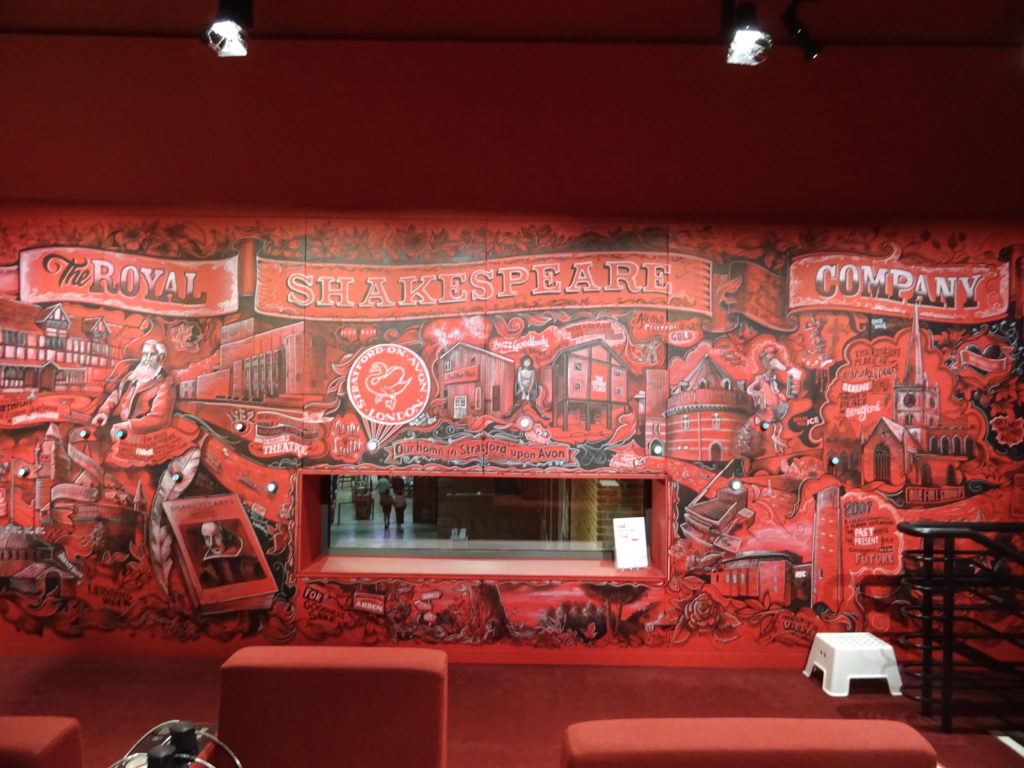
The Artwork At The Theatre Was Pretty Cool
We hadn’t gotten great tickets, we’d booked last minute and so we on the upper tier. However, not long before the show started we were moved closer, as seats were spare. So we were right at the front of the upper tier and ended up with a great view looking down on the actors. The theatre was actually smaller than I’d imagined, so felt quite intimate.
Tamburlaine is not a Shakespeare play but is by another play write of the time, Christopher (Kit) Marlowe. Its full title is Tamburlaine the Great and is actually in two parts, though the play I saw had put the two parts together. It is loosely based on the life of the Central Asian Emperor Timur.
And what can I say about this play? Wow. Just wow. It all got a little out of hand. When after the first half they have to clean all the fake blood off the stage, as it had covered the entire stage, you know it’s a bit of a stabby, angry play. In all honesty, I didn’t follow it all but definitely got the main gist, which was “everyone who gets in Tamburlaine’s way must be killed, tortured or both.” A bit hardcore. I enjoyed it, but I was in shock for a couple of hours after. Worth seeing, but be prepared for shock and horror.
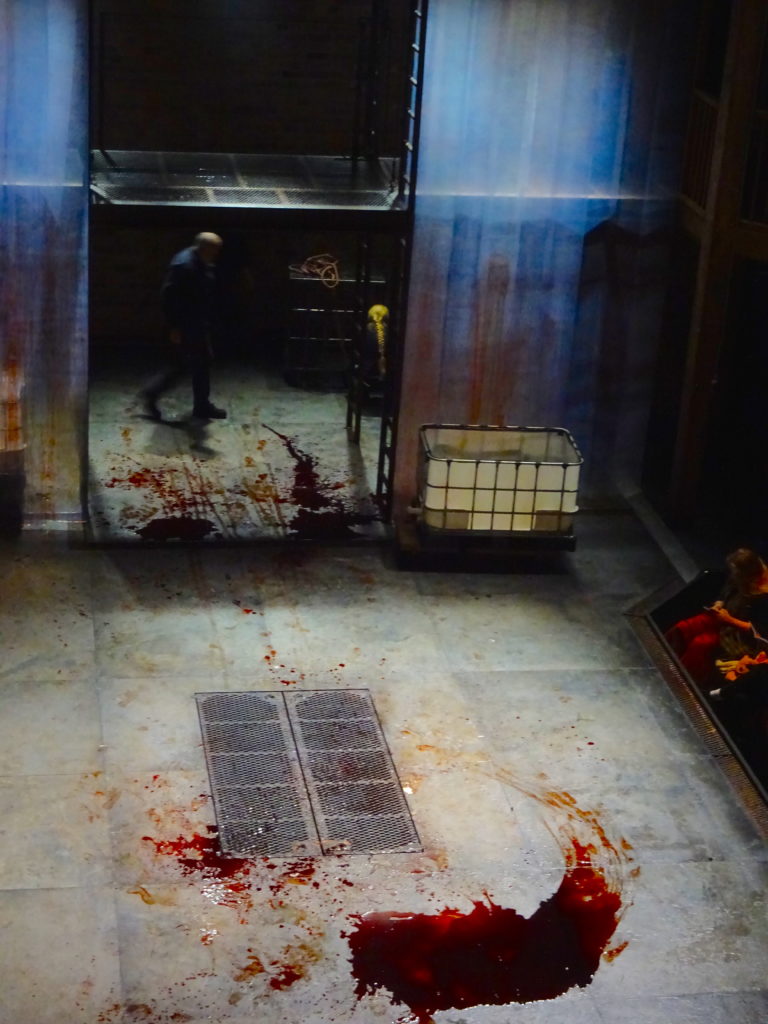
You Know It’s A Bloody Play When There’s This Much Blood At The Interval
The Need For A Drink
So, after the madness of Tamburlaine, there was no way we could go home and sleep. Just no chance! So once again we walked around a bit until we found The One Elm (click here to see what people think of this pub) and went in for a drink. After all the blood, guts and horror, we really needed a bit of a drink and a chat.
This pub was lovely, we got a nice distraction from our thoughts in the form of a Great Dane. She was just left to wander around the pub as it was quiet, so I was happy. Who isn’t happy with a drink and a huge dog?
We basically left as the pub was closing and on the way back to our Airbnb we found another Shakespeare themed statue and I loved this one. It was a jester and had various jester, or fools quotes from Shakespeare plays. My favourite was “A fool thinks himself to be wise, but a wise man knows himself to be a fool”, which is from As You Like It.
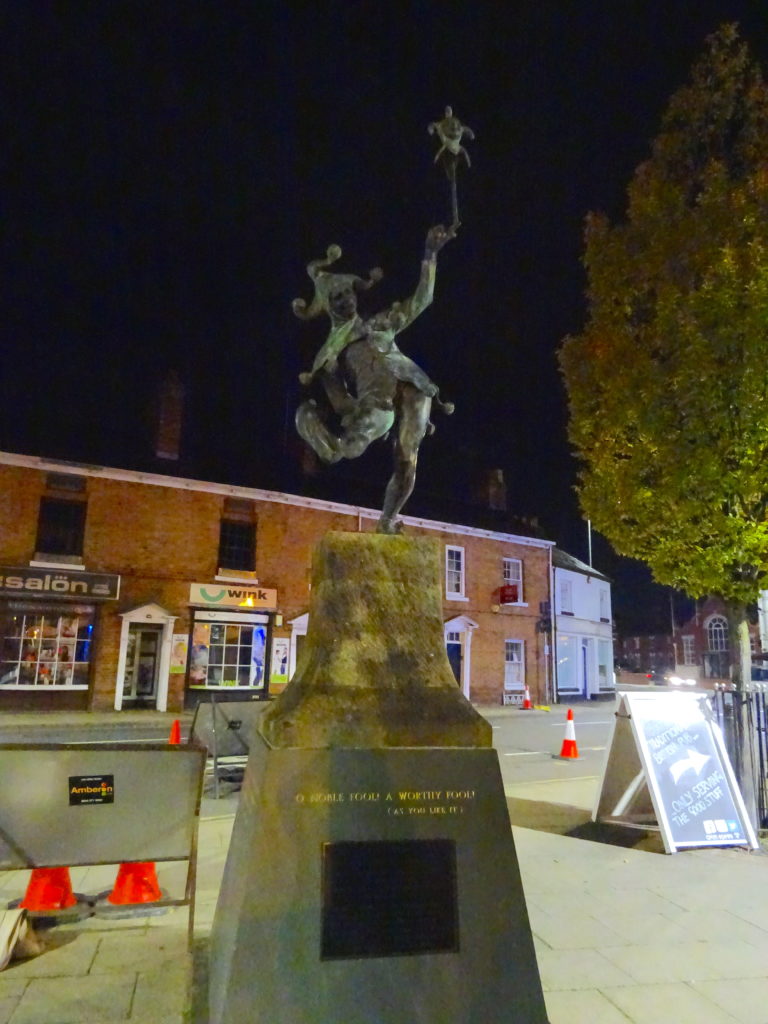
Shakespeare’s Fool Statue
The Last Shakespeare House
The next day, we were up early. We had our last breakfast at the Airbnb, said our goodbyes and headed off for the day. But we weren’t leaving Stratford-upon-Avon just yet, we had one more Shakespeare House to see: Mary Arden’s Farm. (For reviews, click here).
We had to drive to the farm, as we had to get to Telford later that day. It’s not far, about a fifteen-minute drive. But you can reach the farm from Stratford centre by walking along the canal, apparently, it takes an hour. I would like to do this, but it just wasn’t possible this time.
So we arrived nice and early, basically noses at the door for opening time. As we only had half a day we wanted to make the most of the morning.
Mary Arden’s Farm is the farm where Shakespeare’s mother (Mary Arden) grew up. It was built for her father around 1514. There are actually two houses on the site, the Arden’s and the Palmer’s.
So Much To Do
Walking through to the farm, there is a display of foods that would’ve been grown at the farm, with some explanations and modern-day versions. Mary Arden’s Farm is still a working farm, with rare breeds of animals. All the staff about the property are not just there to teach you about the house and Tudor life, but they are also farmhands.
As you enter the main site you can’t miss the blackboard full of events for the day. There’s a lot to see and do at this Shakespeare house. There’s goose herding, talks, house tours, the animal of the day and more. We quickly decided that we definitely wanted to see the goose herding display (who wouldn’t), do the Mary Arden’s house tour and see the Tudor Dinner. It all filled up the day pretty quickly.
Goose Herding
The first event of the day was goose herding, and who wouldn’t want to see this demonstration?! Naturally, we headed straight over this exciting event, and so did a school trip that was visiting…
This event was awesome, there was lots of information in a short time. For instance, did you know that the word ‘cattle’ was used for all herd animals?
Those doing the demonstration were in Tudor costumes and were actors as well as farmhands. They told us all about geese and why they were farmed in Tudor England. Geese were bred for their feathers, the down from the neck, the left-wing for quills and there was another type of feather, but I can’t remember… They did pluck the geese whilst alive during Tudor times, which is very cruel, but thankfully this is not done anymore.
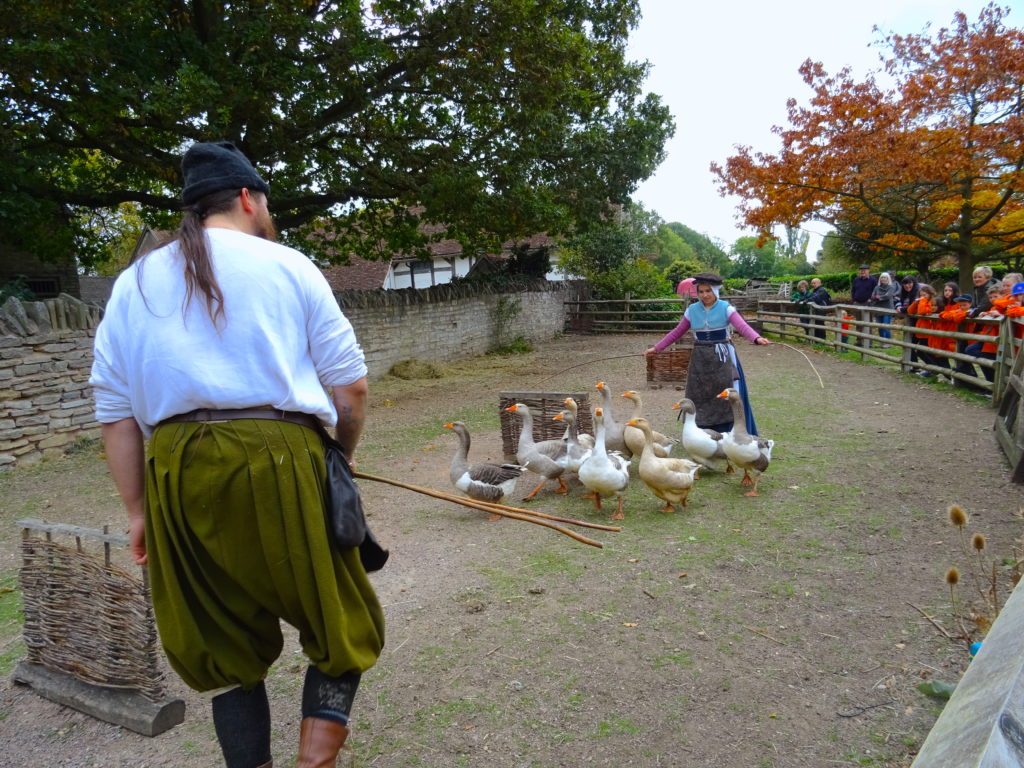
I Loved The Goose Herding Demo
In Tudor England, showing how rich you were was a constant. So at Easter, families would eat lamb and this showed that they were so rich that they could eat their stock before it had made them any profit. Similarly, at Christmas, a goose would be eaten, to show that you can eat from your own stock.
Drovers
Drovers were the people who took the geese to markets. They would ‘drive’ hundreds of geese and this meant walking them from market to market. The two staff gave us a demonstration with the small number of geese that they had (it was no way near the hundreds). They weaved them in and out of fences, going from one end of a pen to another. One would stand behind and ‘drive’ them forward, the other would ‘steer’ them the sides. Both ‘drivers’ have large sticks to herd the geese with.
It looked really easy and the geese were pretty well behaved, apart from two males that kept pecking at each other. After the demonstration of how to herd the geese, the staff asked if anyone wanted a go. Of course I did! It’s not every day you get to herd geese, is it? And as two people are needed, Dave had to join in too.
It was actually fairly straightforward and easy, though I can imagine this is much harder when you have hundreds of geese! We both had a go at each bit, one walking behind and one steering. We got to weave the geese in and out of the fences, from one side of the pen to the other. On the way back the geese were even easier to herd, they were practically just going themselves, this is because they knew it was coming up to feeding time and this is the way they go for food!
After us some of the school kids also had a go, so the geese didn’t get fed as quickly as they would have liked.
Falconry
Straight after the goose herding demo was a falconry display. As to get to this all we had to do was literally turn around, we decided to stick around for this, as did the school kids – it felt like we were on their trip!
This, I will say, was not what I’d call a display, but I really enjoyed it. We were taught so much about falconry, rather than just having birds do tricks.
The falconer had a barn owl with him, which in Tudor times was also known as a love owl (due to their face shape), a ghost owl (due to their silent flight) and white owl. Barn owls were used for hunting and being a falconer was a good job in Tudor times.
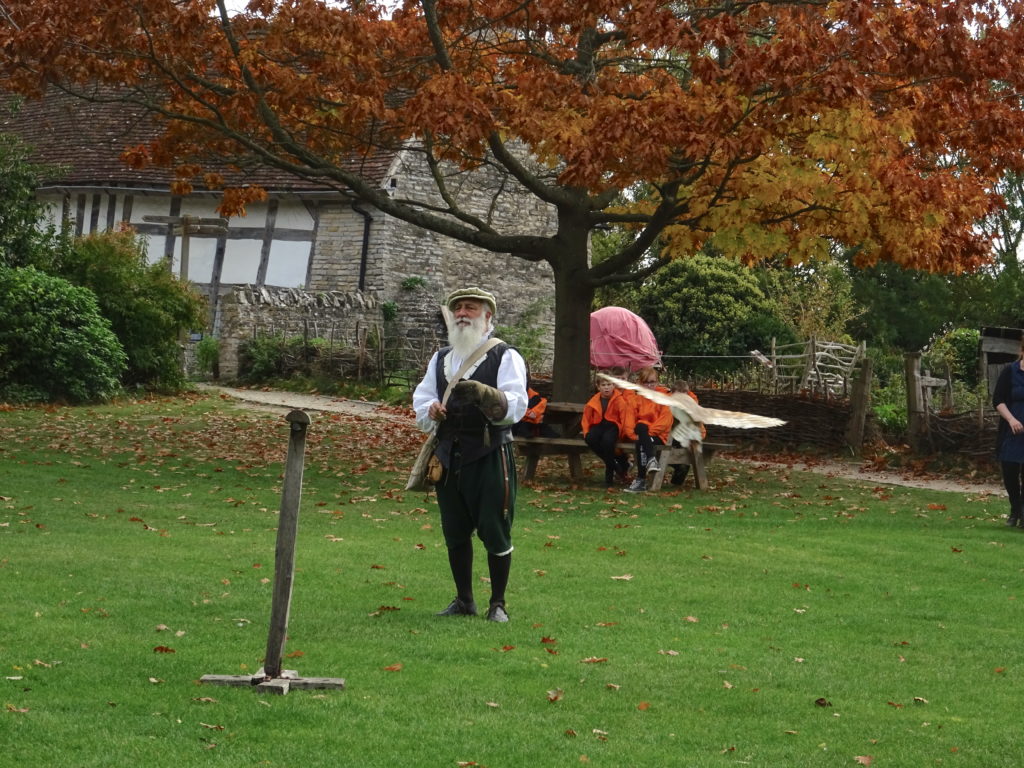
The Falconry Was Mainly Just The Barn Owl Flying Around
As we were taught about barn owls and Tudor England, the owl just flew around. He would occasionally land somewhere and cry out. This is because he was hand-reared and so would whinge to be fed constantly. He would fly closer and closer to people, I think he was attention-seeking.
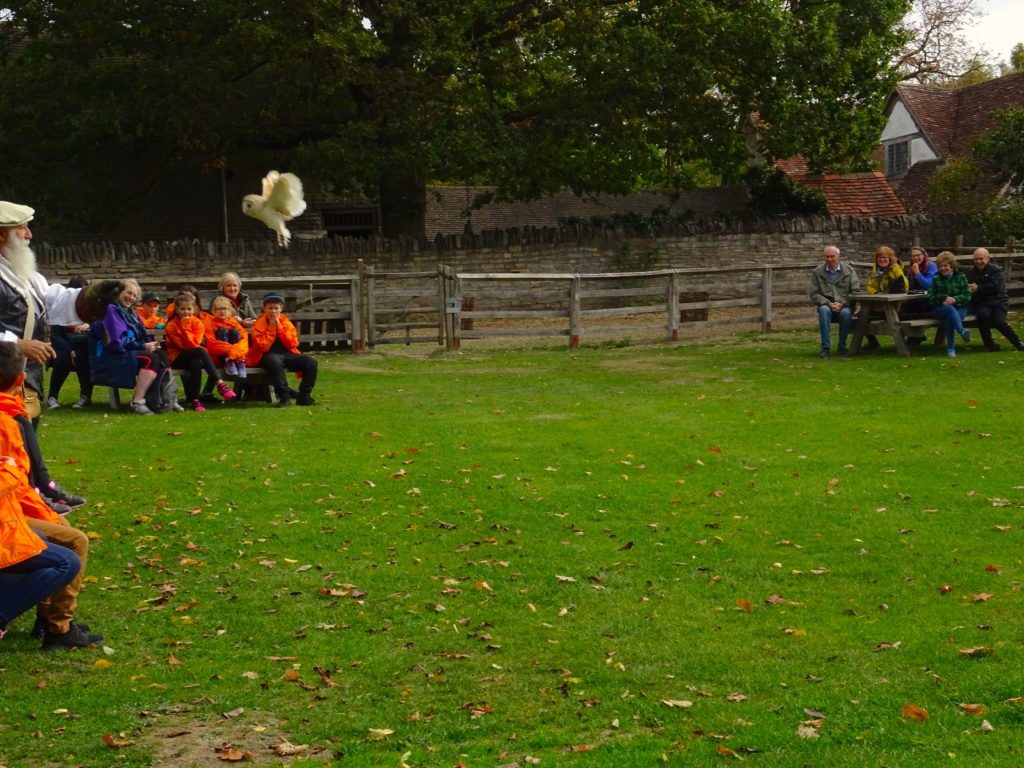
The Owl Seemed To Be Enjoying Herself
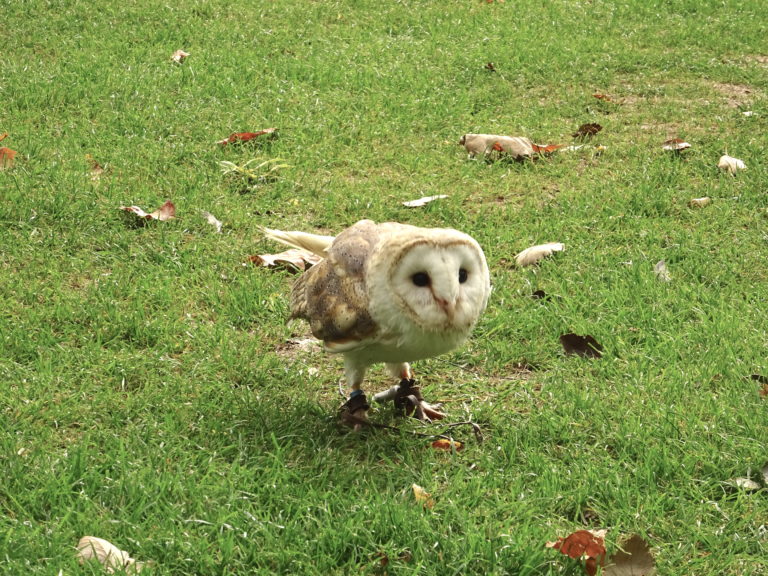
The Barn Owl Having A Rest
Handfasting
Barn owls were not only used for hunting, but also during handfasting (marriage) ceremonies, to predict the sex of the couple’s first child. The owl would be flown over the couple as they were handfasting. If the owl flew over the bride, their firstborn would be a girl, if the owl flew over the groom, the firstborn would be a boy. Completely logical, right?
The falconer then went on to ask for a recently married couple… Or recently engaged couple… Maybe even just a young couple?! At this point he was practically pointing at me and Dave, so we got the hint. Though at this point we had been married for two years and wouldn’t really class ourselves as a ‘young’ couple, especially when next to all the school kids!
But, it was quite clear that he meant us, so we joined him for his demonstration. We had to hold hands facing each other, whilst he stood behind our hands. He then called the owl and it predicted… Nothing. The owl flew straight between us, so did not predict what sex our firstborn would be (if we ever decided to, but that’s a topic for another day). Anyway, this is what the owls would have been trained to do in the Tudor times, so if the owl was wrong, there would be no backlash. So it really was a complete con!
The Tour Of Mary Arden’s Farm
Next on our list to see was the tour of Mary Arden’s house. So we headed over, and you’ll never guess what the school kids did… Yep, they were doing the tour too!
Our guide, Tom, met us at the house and introduced himself. He was one of the goose herders from earlier. Mary Arden’s farm doesn’t actually look like a Tudor house, it is red brick with none of the black and white Tudor beams. It is only recently (2000) that this house has been discovered to be Mary Arden’s, Palmer’s house was mistakenly given that name, to begin with. This house was also occupied for many years.
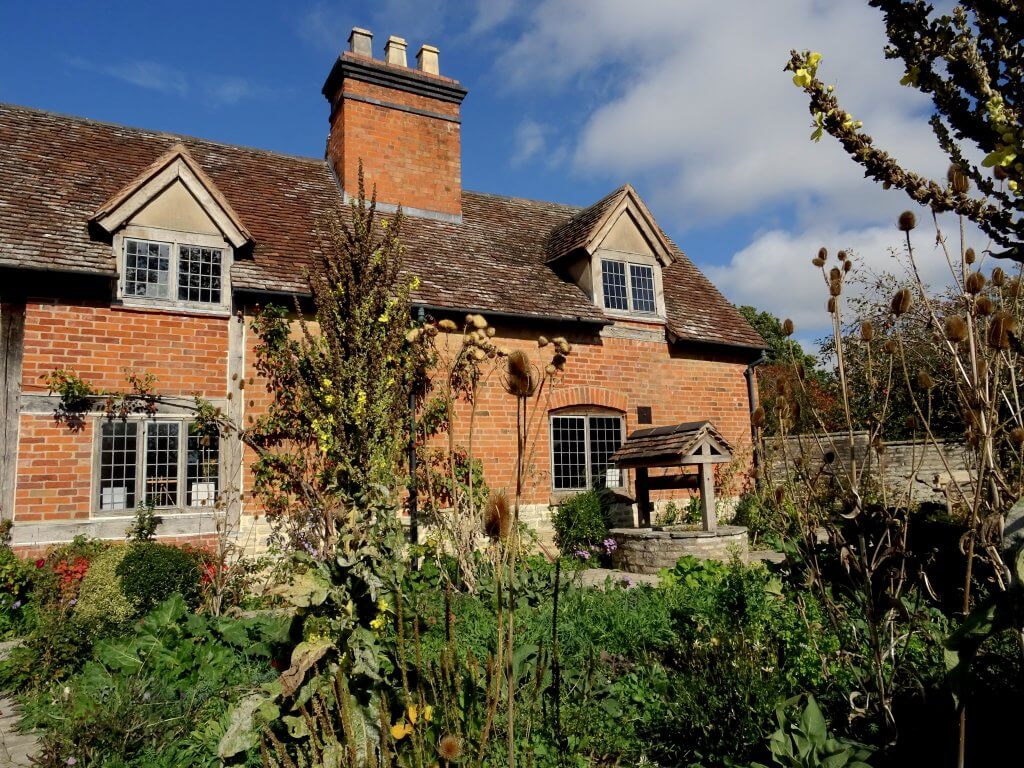
Mary Arden’s Farm House, It Doesn’t Look Tudor
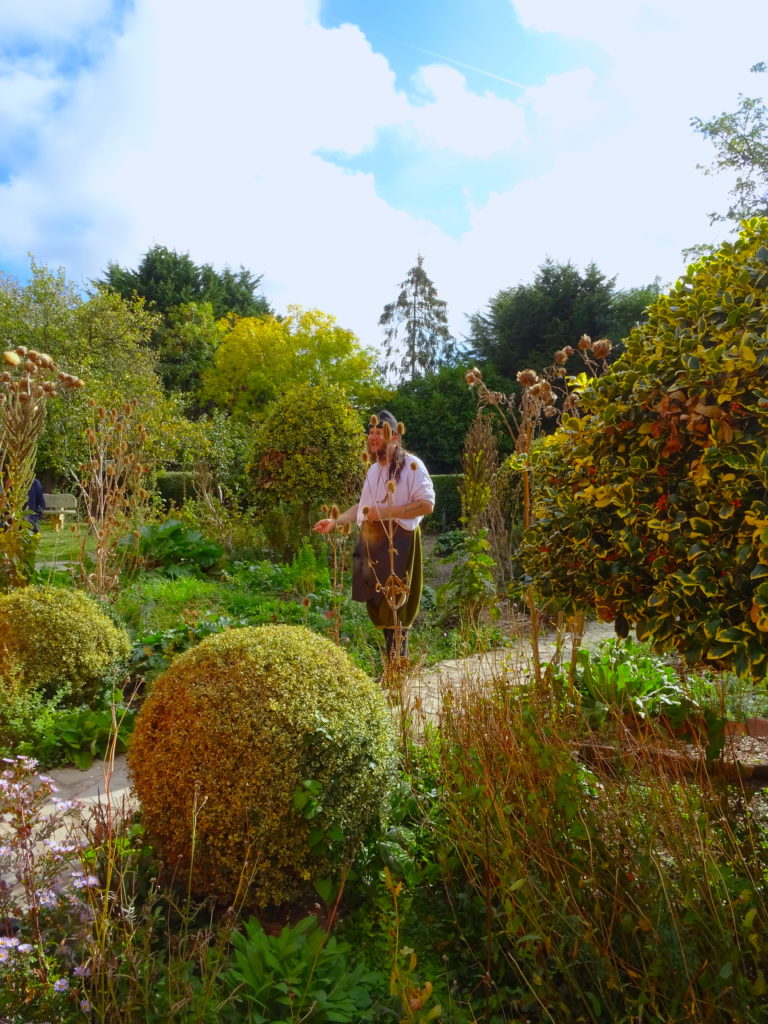
Tom Telling Us About Mary Arden
We entered the house and it was quickly noted that the ceiling was very low ( not that this caused a problem for me). This gives rise to the myth that people were much shorter in Tudor times, but they were not. In fact, the average male height in Tudor England was 5”11; so how come Tudor houses have such low ceilings?
If you look at the floor in this room, you have your answer. The floor is simply dirt, and that is it. During a Tudor house warming, a traditional dance was performed, and everyone would wear clogs. This would pack the floor in. And so the floor was actually 6 inches lower than it currently is.
The History Of Mary Arden
Whilst in this room Tom told us many things. For instance, he pointed out that the house had a thatch roof but also had fireplaces. So how was this safe? Quite simply, they had no chimneys, this meant that the smoke would smoother a larger fire. A fireplace and thatch only becomes dangerous when an airhole is put in the thatch, which allows oxygen in the room. So you might be choking on the smoke, but at least your house wouldn’t burn down!
Here we also got an introduction to Shakespeare’s mother, Mary Arden. Mary was the youngest of eight daughters. As such here duty was to look after her parents in their age, she would not be needed to marry. Becoming an old maid in these days was actually a good career choice as childbirth was dangerous.
Unfortunately, Mary’s mother died. Now the mistress of the house (her mother) is a very important role. The mistress would run the house to ensure that no one starved, this actually took years of planning. So a widower would try to marry again within four to six weeks, to ensure that the house and his children were cared for.
Mary’s father married again, he took to wife Agnus Hill, who brought four more daughters into the house. So this meant that Mary was no longer needed to take on the role of the old maid. And so she married the up and coming businessman John Shakespeare, from what we know this seems to have been her choice.
Tudor Myths
In the next room Tom pointed out a shelf, this was where the daughters would sleep. Hence the phrase “being left on the shelf”. The ladder would be taken away at night until the morning.
This room had a fireplace with a chimney (the chimney was put in to allow for the extension of the second floor) and Tom told us a myth from Tudor times. It was believed that the devil could come down chimneys to steal souls. Therefore Tudors would put a saltbox in the chimney, as the devil can’t pass salt without counting every grain.
This room also had a pantry off to one side. During Tudor times a dairymaid would keep the pantry clean and cold. Amazingly, the pantry was actually colder than the room, you could feel the difference in the air temperature by just putting a hand into the pantry.
The First Floor Of Mary Arden’s House
The tour then took us up the stairs, but there was a dilemma, there were too many people on the tour. The old house wasn’t suitable for having som many people on the first floor. So at this point, the school kids left and Tom offered to finish the tour for them later.
Up the stairs, it was noted that the doorways were low, another reason that Tudors were thought to be short. But it was them being thrifty. It was simply much cheaper to make a doorway cutting part of the old roof beam. There was another doorway that was full height, this meant that more beams had to be used to create support. Handily, these doors were opposite ends of the same room, so you can easily compare them.
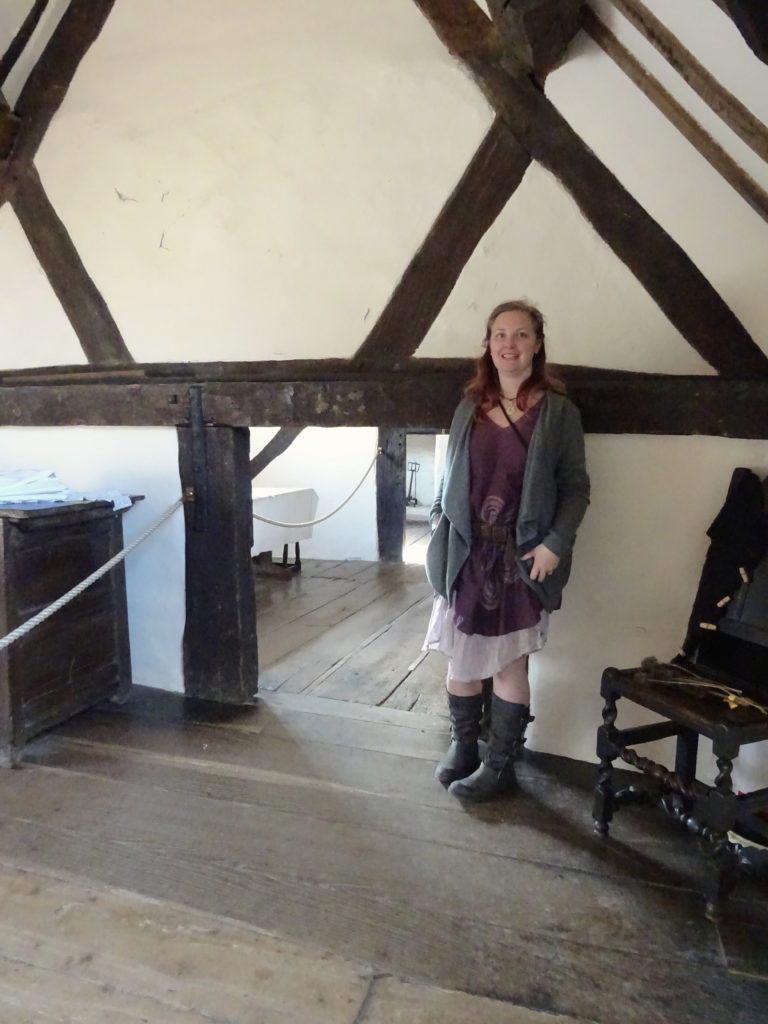
Having A Small Doorway Saved Money
There was a really interesting feature in the accounting room – you could see where the candles were used. There was also a storage room where hay would have been kept. However, this is dangerous in a house as piled hay can combust, as the centre can become hot, causing a fire. So a needle would be used to test the heat of the centre of the pile. It would be pushed into the pile and left for a few minutes. When it was taken out, you could feel if the hay pile was getting too hot, as the needle would be hot. This is where the phrase “looking for a needle in a haystack” comes from, as the needle would get lost if it was put too far in.
Down some other stairs, we met a lady who was doing some Tudor art. Here Tom had a quick chat (in character) before we went outside and the tour was over.
Animals On Mary Arden’s Farm
As there was a bit of time until the next event that we wanted to see. So after the tour of Mary Arden’s house, we generally wandered around. Behind the Arden’s farmhouse is the Arden’s Barn, here we found some pigs in their sty. There were meant to be some goats, but they clearly didn’t want to play.
We then decided to make our way to Palmer’s Farm, where the next event would take place. One the way we bumped into the “animal of the day”. This was a very friendly sheep. No one had been to this event, so I felt a little sorry for her, as she really did just want a stroke. When we came near her we literally had no choice!
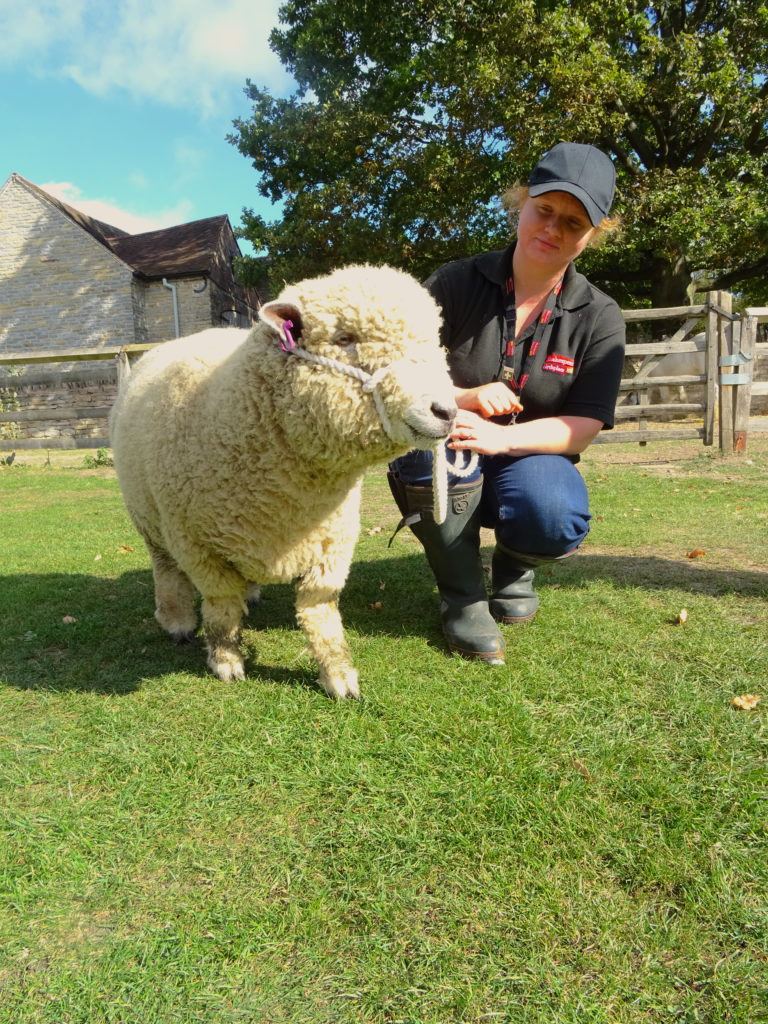
Animal Of The Day
Coming up to Palmer’s farmhouse, you can see why it was mistaken for the Arden’s – it looks a lot more Tudor. With black and white timber frames, you can’t mistake it for anything other than Tudor!
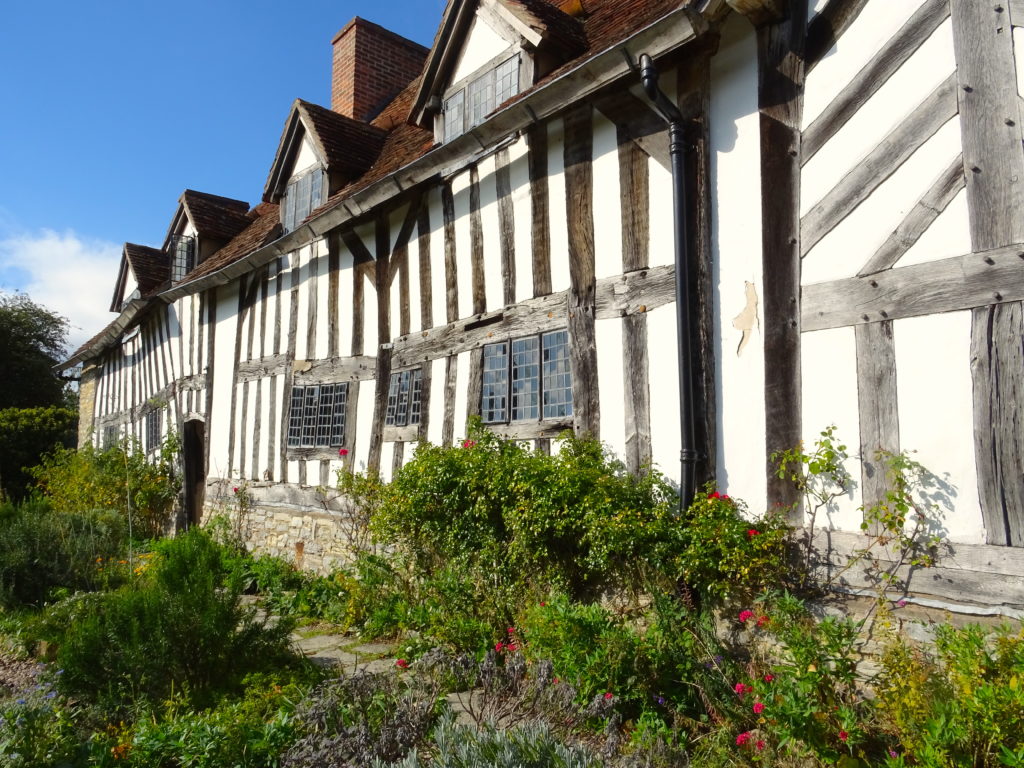
You Can See Why This Farmhouse Was Originally Thought To Be Mary Arden’s
Inside you can find more low doors and there’s a daughter’s shelf set up for sleep. What you find here is very similar to in the Arden’s farmhouse.
We quickly walked around the house and bumped into some women preparing lunch. They were very happy to talk and told us all about the ingredients that they were using. There were baskets full of different ingredients.
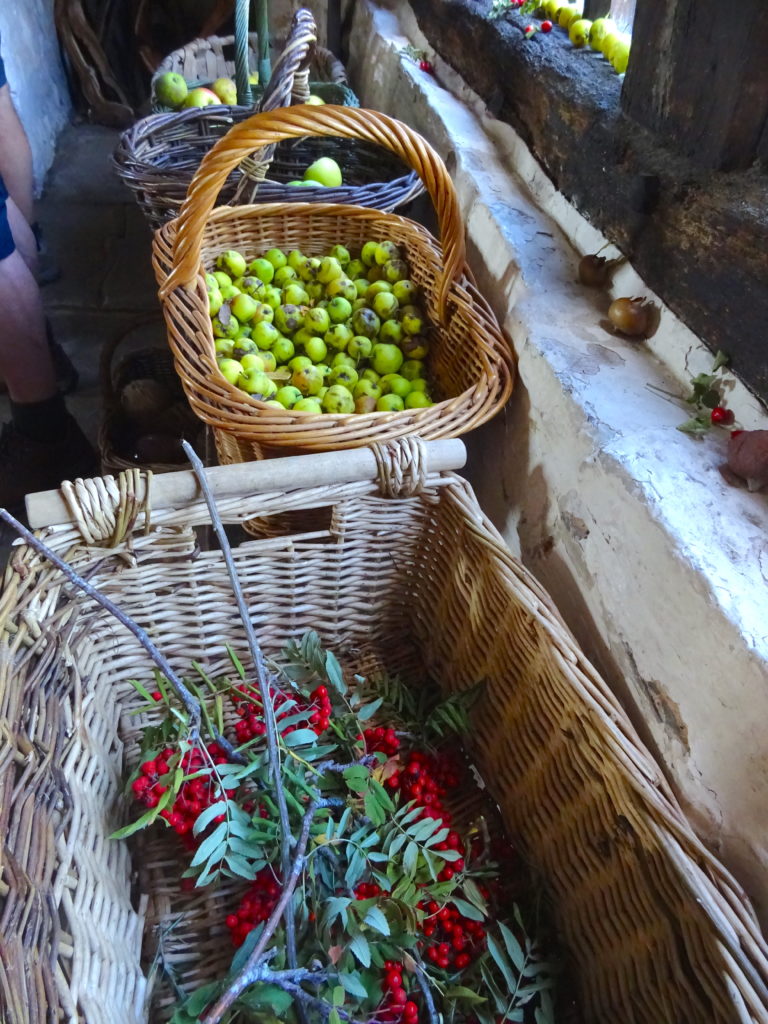
Some Of The Foods Used By Tudors
As there was still a bit of time we headed back outside into the sun. Not far from the house we met Bill and Ben, two donkeys. They were enjoying the sun as much as we were!
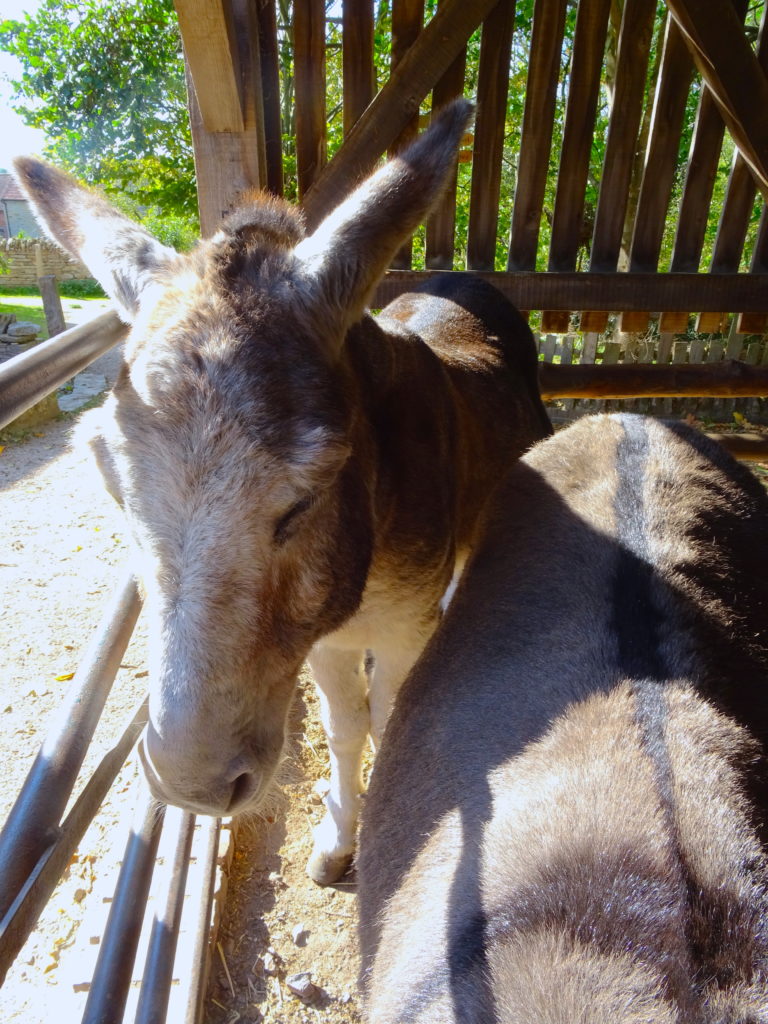
Bill And Ben Enjoying The Sun
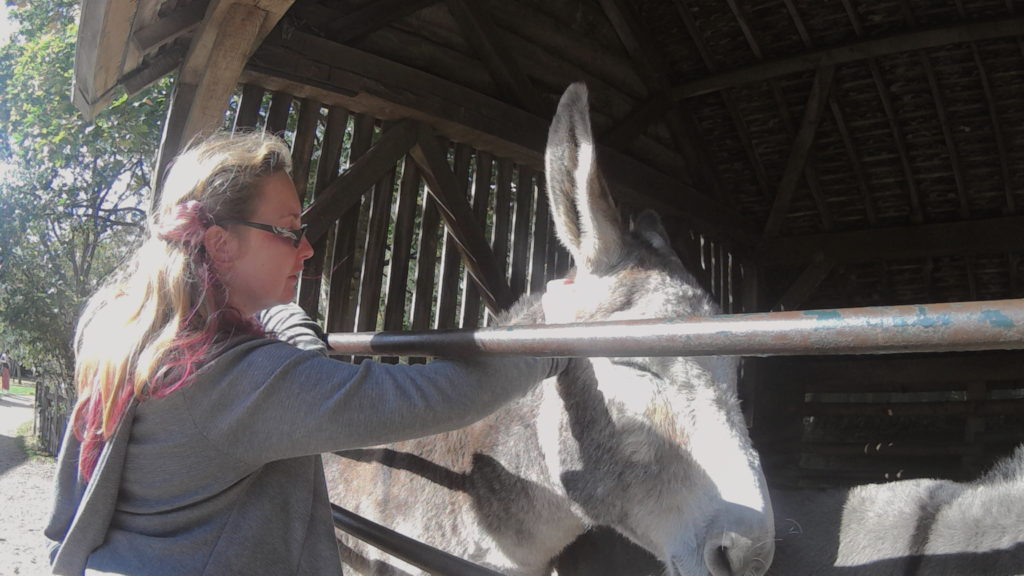
Not Sure If It Was Bill Or Ben Who Liked A Good Stroke
Lunch WIth The Tudors
Just before 1pm, we headed back into Palmer’s House to see the Tudor Dinner. This was a little weird as we were essentially watching the staff have their lunch. But it was awesome, so I really recommend doing this! The only downside when I went was, it was packed, due to the number of schoolkids. But it didn’t make it a bad experience and the schoolkids asked some great questions.
As the staff got ready to eat, they explained everything. The Master of the house entered (this was the guy from the falconry display). No one washed their hands until he did, no one sat down until he did, the master must do everything first in Tudor times.
There was a bowl of water filled with herbs for the washing of hands. In Tudor times it was believed that anything with a nice smell must be clean. And so the herbs would clean the water. And to be fair, the herbs that they used are now known to have antibacterial properties, so the Tudors were on to something.
As the staff prepared for dinner, they talked to us all and interacted, especially with the children. In Tudor times, the children would actually serve the dinner, which included carving meat. They would do this until they had learnt table manners.
When serving, the children would place four to five dishes onto the board (table) from the sideboard. The workers would then help themselves. However, they would only take food from three or four dishes (basically they would always miss out one dish), to be polite. Sweet and savoury foods could be served at the same time and could be mixed.
Tudor Status
Status was very important in Shakespeare’s time. And so all the staff welcomed the master when he entered. The women would curtsey and the men would bow. But, there are particular ways to do this. For example, only common girls would lift their skirt when curtseying. And when bowing a man would doff his hat, but it was important not to show the inside of the hat to the master. This all seems far too much work to me!
The staff then asked us how we would great the master. Naturally, we all said “hello”, but this was wrong. “Hello” meant “what” in Tudor England and so was not used as a greeting.
When at the table, the master was the only male who would keep his hat on, this showed his status. If someone visited with a higher status, the master would take his hat off and the visitor would keep his on. Although, no matter how high your status, you would remove your hat when praying. This is because God has the highest status, so I assume God keeps his hat on.
However, the women were allowed to keep their hats and coifs on. Having their hair tied up under the coifs was thought to prevent the spread of nits.
When everyone was gathered at the table, everyone sat down in order of status. This meant that the master had to be the first to sit.
Pottage
I love the old folklore and the dinner wasn’t free of this, everything is done for a reason. The plates and bowls to be used were laid upside down. This was to prevent spirits from climbing into the crookery.
The first course came out (they were having a three-course meal and each course was described to the audience). First was “Pottage”, which is a stew/broth. They had this with lots of bread. Bread was a staple in Tudor times, as there were no potatoes (as these came from America). So Tudors would eat 2-5 pounds of bread a day. Seems a lot doesn’t it?
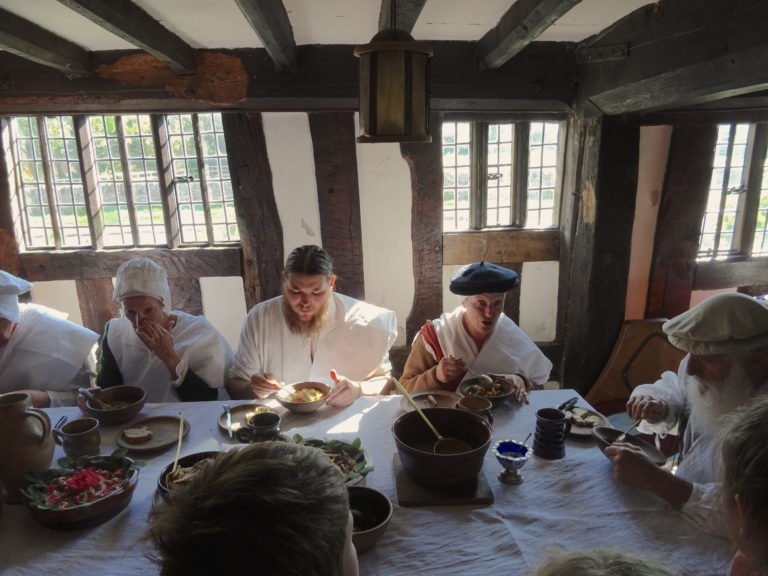
It Was A Little Weird Watching The Staff Have Their Lunch, But Very Interesting
Pottage was believed to help the digestive system, the stomach was viewed as a cauldron which “cooks” the food you eat. So to keep care of it, you must fill it with broth first. Cheese is the last thing to be eaten as this “puts the lid on”.
Manners Maketh Man
The Tudors were really big on manners. Manners were VERY important. Those that had no manners were seen to be “as low as pigs”. The staff did great at teaching the crowd Tudor manners, as they asked opinions. They asked what we thought was rude and what wasn’t. I love a bit of audience participation.
The first thing to remember if you are ever at a Tudor dinner is to not eat with your mouth open. Pigs eat with their mouths open and so it is bad manners to do so. We were asked if we thought if eating with hands was bad manners, we all assumed yes, but this was wrong. Although there are rules about eating with your hands – only the thumb and the first two fingers should be used. To show that you are not grabbing, your last two fingers should be stuck out.
Ever heard of keeping your elbows off the table? Well, this is as old as the Tudors. Although technically, having your elbows on a table is fine. A board was used as a table in Tudor times and this was not fixed, so if you put your elbows on the board, it would tip. Keeping everything above board? That’s a saying from Tudor table manners. Your hands should be kept on display whilst eating – above the board – so that there was no fondling or dirty work going on at dinner.
Dispelling Some Myths
Ever heard that burping in Tudor times as considered good manners? It wasn’t. Burping was just as impolite as it is now! Where that rumour started from I don’t know.
And you know how in films in medieval times people would just wipe their mouth with their hands? Never trust the film industry… I mean, come on, they put Edinburgh Castel on a flat plain. Anyway, a napkin would always have been used to wipe fingers and mouth in Tudor times. But I guess that doesn’t portray the image of this time that the film industry wants.
Another film industry lie is eating off a knife (it always seems to be some brute doing this). But this would not have been done as it was dangerous. Tudors always ate using a spoon.
One thing you may have heard though that is true is that it was safer to drink ale than water. So everyone drunk ale from 2 years old. However, the ale was much weaker, so there weren’t plastered children walking around.
No Waste
During a Tudor meal, it was important to clean your plate. Bread would often be used to mop up the last bits. As the food was placed in the middle of the table, you served yourself. Therefore if you didn’t eat all that was on your plate, you were a glutton. It was greedy and rude to take more than you could eat. This is one that I wish people still adhered to today, think how much waste it would save.
Although talking of waste and cleaning your plate, the serving dishes were never emptied. Anyone who took the last morsel was insulting the master. If the serving dishes were emptied the master hadn’t provided enough food. But nothing was wasted, all the leftovers would go into the next days’ pottage.
As we were taught our Tudor table manners, the first course was finished and the second course served. The workers had links (sausages) with bacon and kidney, this was all served with “compost” of vegetables (which means layered veg) and onion gravy.
Crookery And Implements
Each Tudor had in their possession a hygiene set. This consisted of a nail pick, tweezers, a toothpick and an ear wax spoon. We were asked if we thought this could be used at the table and once again the film industry had tricked us… Those scenes where people are using a toothpick at the table in Tudor times, nope wouldn’t have happened. Bad manners to use any part of a hygiene kit at the table.
The actors got talking to the kids and got them talking about crookery. They pretended to be astonished when the children admitted that they do not have their own spoons that they carry around. In Tudor times everyone had their own personal spoon, their Christening Spoon, that they would eat with. This would not be washed, as the same person used it. I kind of see the point of this. I mean, how many times do you grab some crookery only to find it has not been washed properly? Seems sensible to only use your own.
For eating Tudors only used a spoon. Knives were available for spreading butter etc. But forks were not used. However, the mistress of the house, in this case, did have a fork. Forks were only used at sugar banquets, which is where everything is made from sugar.
Not So Polite
When it comes to manners at the dinner table, I hate to say it but, men had the advantage in Tudor times. For men were allowed to leave the board to relieve themselves, so long as they asked for the master’s permission. But where did they pee? In the fireplace. Hence why they were allowed, they did not have to leave the room.
Women, on the other hand, would have to go outside to the privy. And so they had to wait until the meal was over.
One thing I thought was nice though, was that all the farmworkers would have dinner (or lunch) at the same time, around the board. Hence the term “board meeting”. The meal also provided a time for the workers to discuss any issues or good news about their work. They could keep the master and everyone else informed as to how everything was going.
Time Keeping
By this point, the second course was finished and the third course was being served. The workers got “farmers mess” for dessert. This was just a big mess of different fruits.
As they were finishing up the workers told us about a Tudor day. I found this really interesting. During Tudor times the time of sunrise and sunset didn’t change like it does today. There were twelve hours of day and twelve hours of night. But obviously, there were differences in the amount of light due to the seasons. So the hours of the day and night just became longer or shorter to suit. So in summer, the hours during the day were longer, but during the night they were shorter, then in winter the opposite was true.
And with that, the meal was finished. The staff began to clear up and get back to their duties on the farm.
The Farm Trail At Mary Arden’s
The plan for the day was to leave at about this time, but you know what it’s like. We decided to stay for a bit longer and walk around the farm trail. Luckily for us, it wasn’t as big as it looked on the map.
The trail was well worth walking around and I’m glad we did. We were the only people on the trail. It was so quiet. We met some friendly goats, who weirdly were trying to eat their enclosure. There was a traditional orchard, with apples ripening on the trees. The geese from earlier were relaxing in the orchard, enjoying apples that had fallen down. We also passed several rare breeds of sheep and cows.
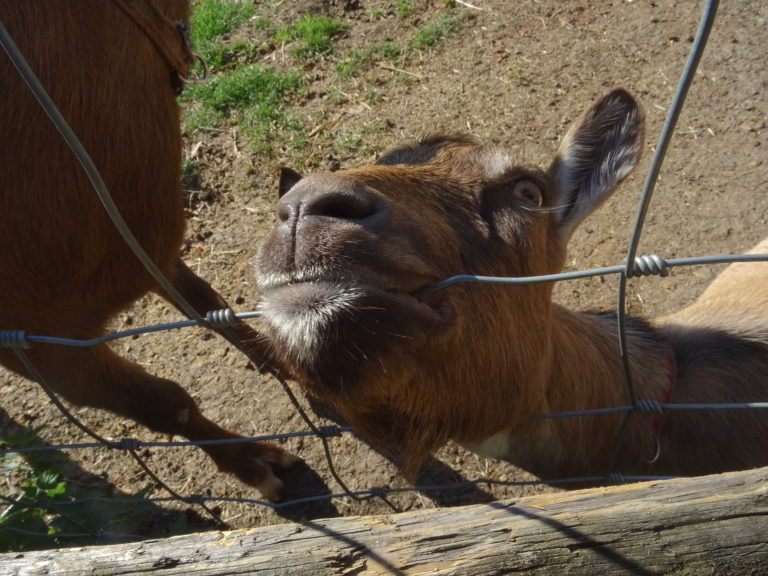
This Goat Was Definitely An Attention Seeker
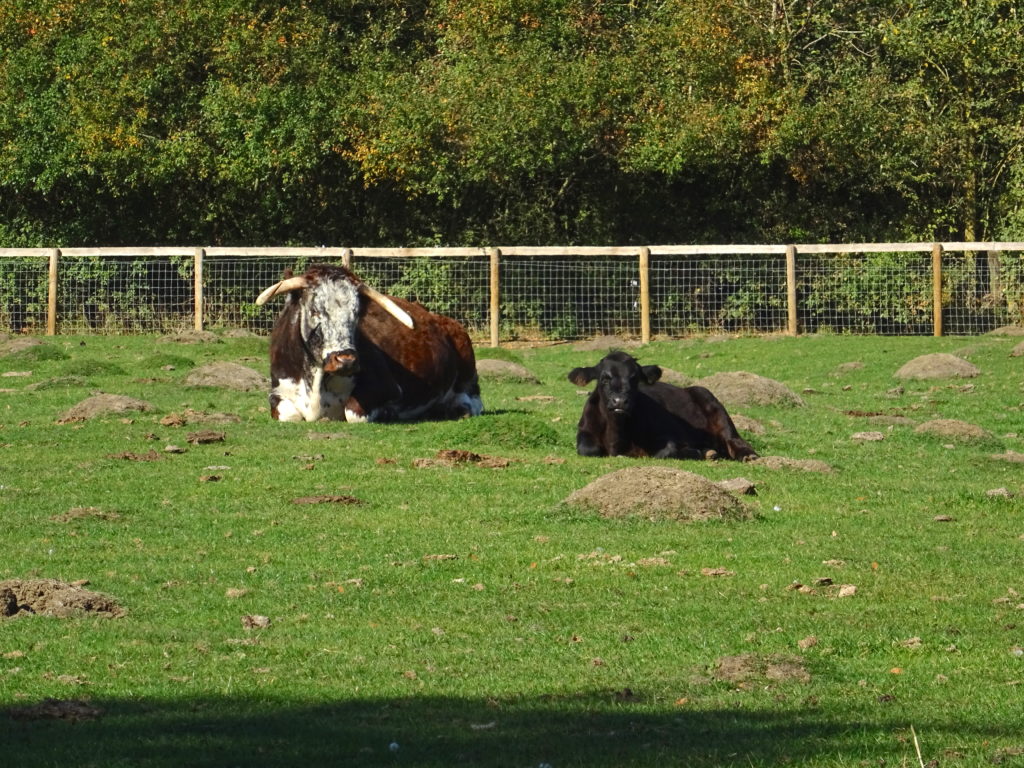
Some Cattle Seen On The Farm Trail
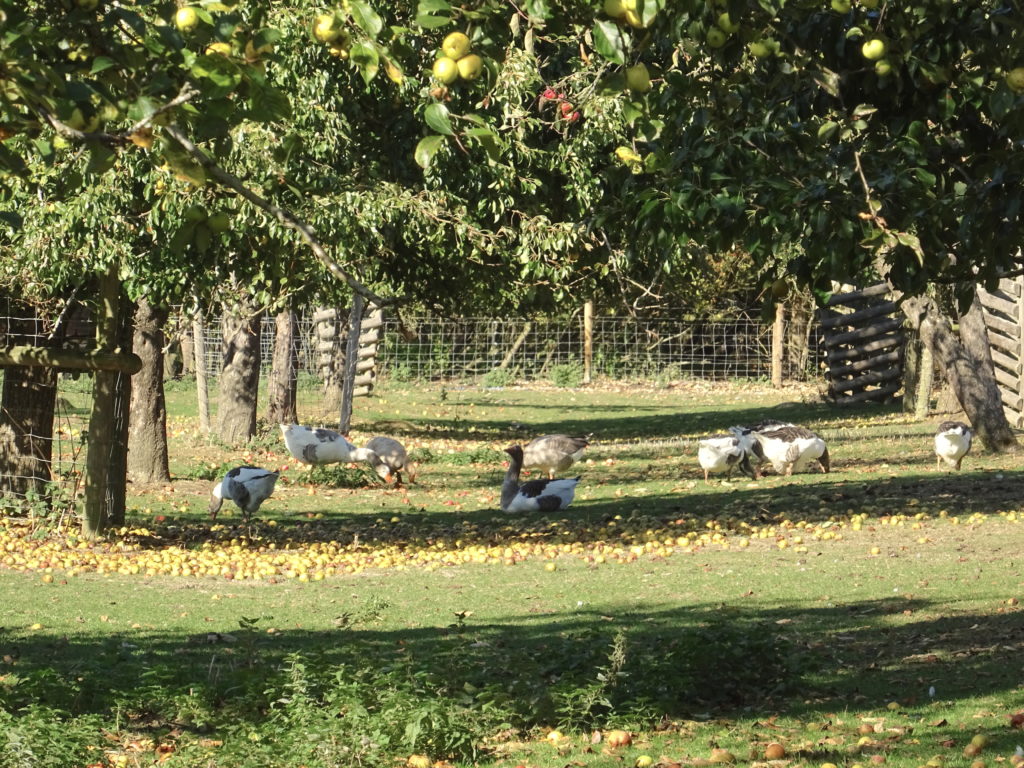
The Geese Were Enjoying The Orchard
As usual, we were here at the wrong time of year though. As the trail loops back, there is a wildflower meadow and butterfly bank. But being October, the flowers weren’t out and there were no butterflies. So I guess I must go back in spring or summer. But I guess in spring and summer this trail would be busier.
Nearing the end of the trail we also found a rabbit enclosure. And what an enclosure! If only more people kept rabbit like this, I’d be happier. There were different floors, plenty of hay, loads of space and lots of hiding holes. Literally, this is how rabbits should be cared for!
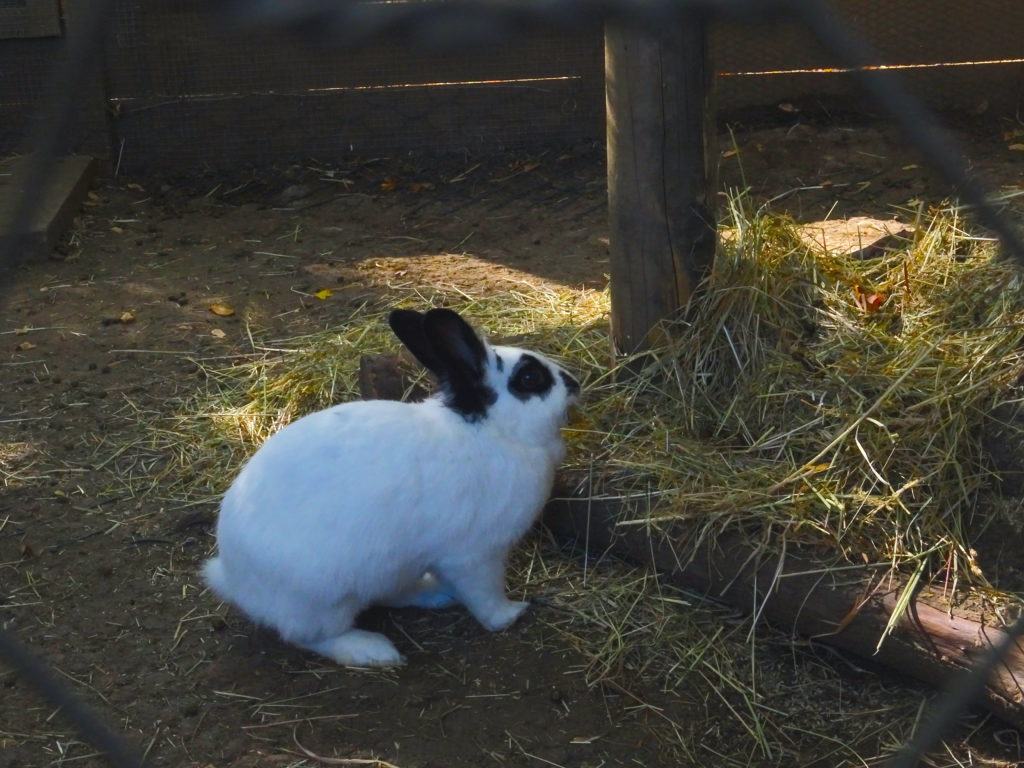
I’m Just A Bit Obsessed With Rabbits And Their Care
The End Of The Adventure
On the way back we met Tom again. I can’t remember what we chatted about, but chat we did. He was heading out to do some farm work with the animals.
And just like that, we had seen all that we could. I could’ve easily spent more time here and would’ve loved to of had a full day to explore a bit more leisurely. We also missed out the Palmer’s House tour (it was do that tour or the farm trail). It’s definitely somewhere I’d like to go back to. Not just Mary Arden’s farm, but Stratford in general.
If you’re looking for a trip that includes Stratford, check out Get Your Guide or to get tickets to see the Shakespeare Houses click here.

